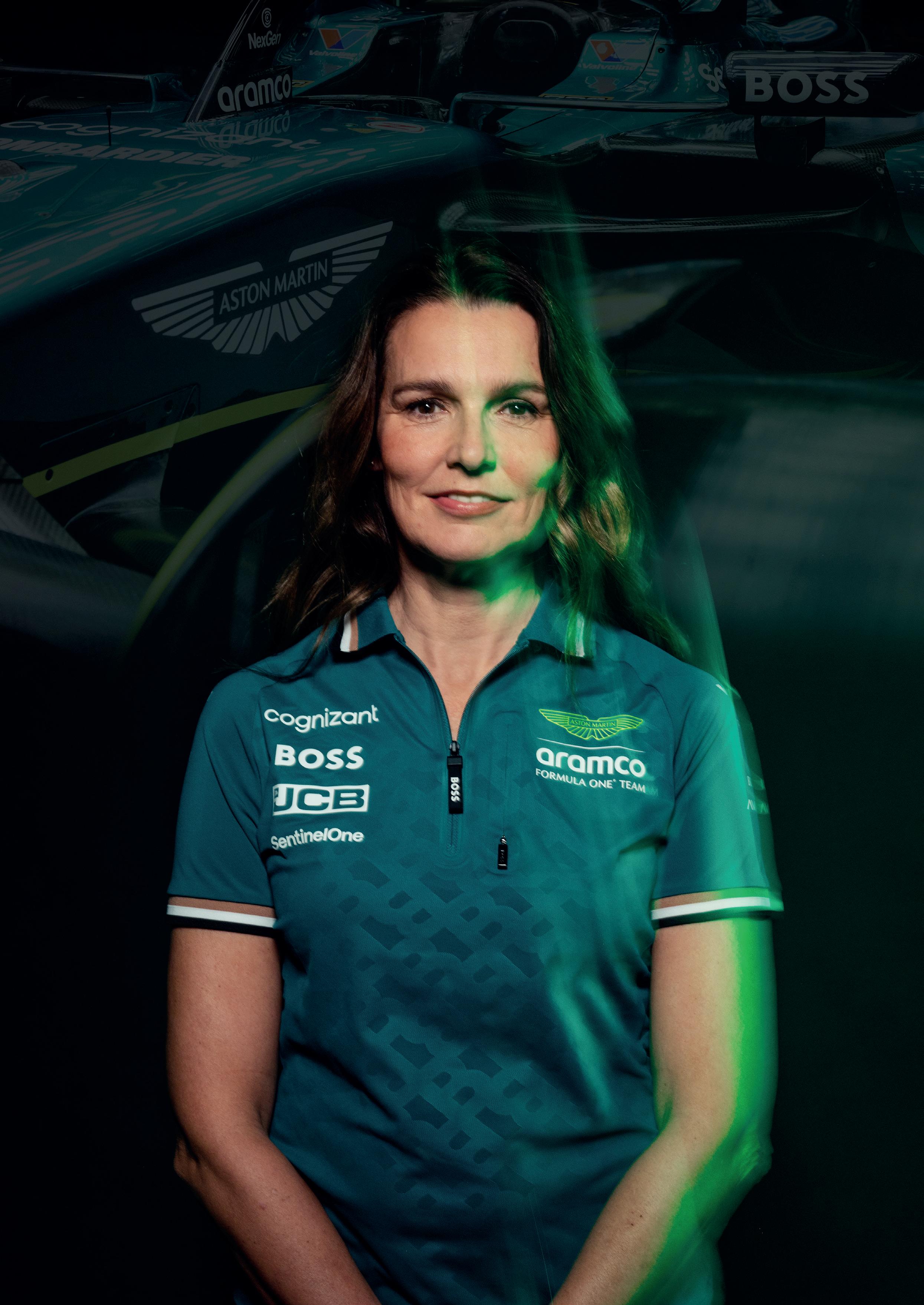







Cover Story: Exclusive Interview With Clare Lansley - CIO of Aston Martin Aramco Formula One Team p34
The Executive Explorer: Cyprus - The City Of Dreams p58

Special Feature: The Executive Gift Guide 2024 p72

p02. Resilience Through Advertising
p06. Achieving True Net Zero
p08. Exclusive Interview: Nick Cooper
p12. Exclusive Interview: Zuhairah Washington
p16. The Business Show 2024
p18. Business Leaders Profile: Paolo Dellachà
p20. Exclusive Interview: Ella d’Amato
p24. Exclusive Interview: Elias Pertoft
p28. Exclusive Interview: Gemma Krysko
p32. Foreword: Misha Sher
p38. Exclusive Interview: Kate Mason
p42. Exclusive Interview: Fara Williams
p48. Exclusive Interview: Matteo Lunelli
p50. Jacob & Co. Partner With Man City
p52. Exclusive Interview: Ramla Ali
p56. Exclusive Interview: Tom Davies
p68. The Original Nikki Beach - Ibiza
p82. An Aston Martin Icon Returns
p86. The All New Lamborghini
p90. Pininfarina - Out Of The Darkness
p94. The First Watch in Space Reborn

EDITORIAL
Elizabeth Jenkins-Smalley Editor in Chief editorial@theexecutivemagazine.com
Alice Weil
Business Editor
Jack Bell Lifestyle Editor
Aleks Bond
Travel Editor
Mike Jennings Food & Drink Editor
Aaron Kelly Art Director
SALES
Adam Busby Director of Strategic Partnerships advertising@theexecutivemagazine.com
Nathan Taylor Strategic Partnerships Lead
Kiera Morris Strategic Partnerships Manager
Elroy Oduor Business Development Manager
MARKETING
Bjorn van den Akker Marketing Director
Jack Salmon
Subscriptions Manager subscribe@theexecutivemagazine.com
Elie Robbins Outreach Project Manager
MANAGEMENT
Francis Falodun Operations Manager
Ian McDonald
Finance Director
COMPANY
©Executive Media Group Ltd
Studio 306 Bonded Warehouse Manchester, M3 4AP
Tel: 0208 1359 527
Company No. 14993504
VAT No. 444948655

Henry Ford once said; “Stopping advertising to save money is like stopping a watch to save time.” During economic uncertainty, many companies instinctively cut marketing budgets, but history shows that maintaining or even increasing advertising efforts can lead to stronger visibility and resilience. This article highlights why strategic advertising is essential for businesses looking to thrive amidst challenges



Henry Ford once said; “Stopping advertising to save money is like stopping a watch to save time.”
During economic uncertainty, many companies instinctively cut marketing budgets, but history shows that maintaining or even increasing advertising efforts can lead to stronger visibility and resilience
DDuring challenging financial periods, businesses are often tasked with making difficult costcutting decisions. One of the first areas many companies consider trimming is their advertising budget. However, history has repeatedly shown that reducing or halting advertising in tough economic times can lead to missed opportunities and even long-term setbacks. On the contrary, sustaining or even amplifying advertising efforts during a downturn can significantly enhance a company’s prospects for future growth.
Maintaining a robust advertising presence during periods of economic uncertainty offers distinct advantages, especially when many competitors may pull back. This strategy allows businesses to fortify their market position and remain resilient.
As economic pressures mount, many firms instinctively reduce their marketing expenditure, which results in less competition for consumer attention. This scenario creates a rare opportunity for businesses that continue to invest in advertising. With fewer competitors vying for visibility, brands that stay the course can capture a larger share of consumer mindspace, positioning themselves as the first choice when spending resumes. A consistent advertising presence keeps a brand prominent, ensuring it is remembered when customer purchasing power recovers.
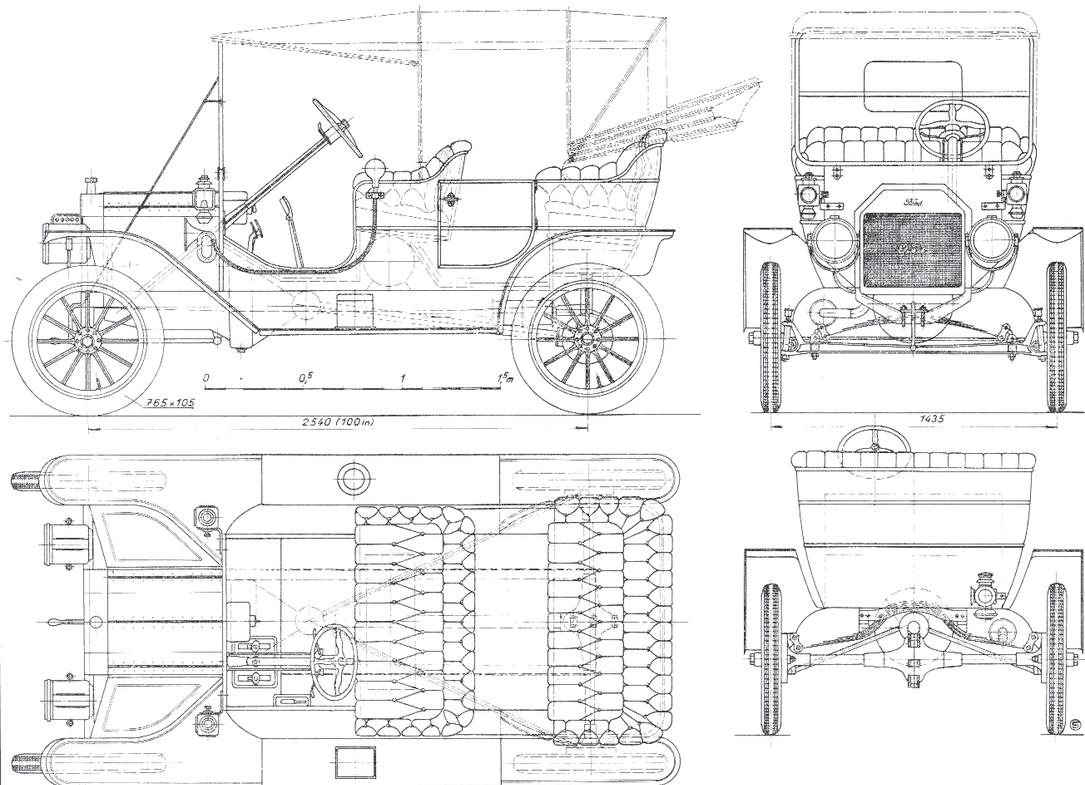
Trust becomes an even more valuable commodity during economic slowdowns. Consumers tend to gravitate toward brands they are familiar with and confident in during times of uncertainty. Advertising plays a crucial role in reinforcing that trust by reminding customers that the brand is stable, reliable, and remains committed to meeting their needs. By maintaining visibility and consistent messaging, companies not only retain their existing customer base but also deepen loyalty that can endure beyond economic fluctuations.
Tailoring the Message to Fit the Climate
While continuing to advertise is essential, the content of those advertisements must evolve to reflect the changing priorities of consumers. Economic downturns bring shifts in consumer behaviour, with increased attention on value, necessity, and problem-solving. Brands should adjust their messaging to emphasise how their products or services offer meaningful benefits, cost-efficiency, or essential solutions during difficult times. A thoughtful, empathetic approach to communication can resonate more deeply with consumers and foster a stronger emotional connection to the brand.
Preparing for the Economic Rebound
It is vital to remember that downturns, while impactful, are not permanent. Companies that continue to invest in advertising during challenging times are often better positioned for success once the economy begins to recover.

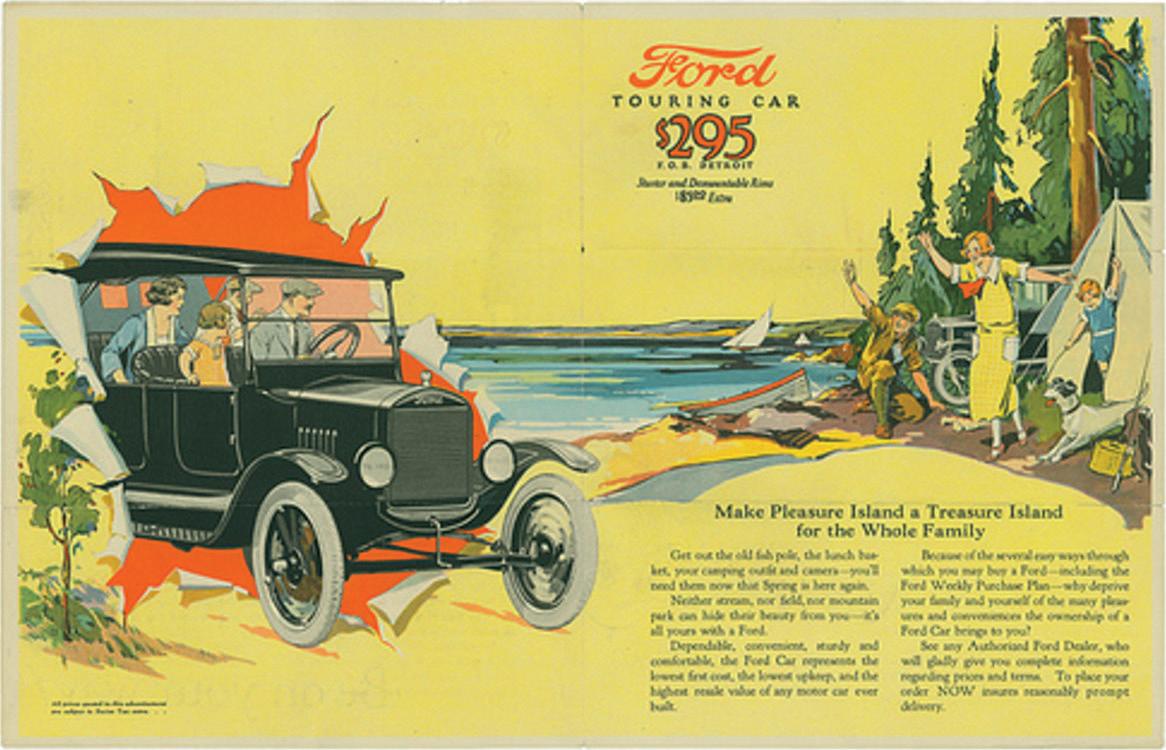
Businesses that maintain visibility and focus on building their brand during the downturn can emerge stronger, with increased market share and enhanced consumer recognition. When consumer confidence returns and spending rebounds, these brands are ideally placed to capitalise on renewed demand.
Maximising the efficiency of advertising spend during an economic downturn is paramount. In this environment, businesses should turn to data and insights to guide their marketing decisions. Analytical tools can provide invaluable information about which channels and messages yield the highest returns. By closely monitoring performance and adjusting strategies based on real-time feedback, companies can ensure that each advertising pound is spent with maximum impact. A data-driven approach allows for precision in targeting and optimising spend, ensuring a stronger return on investment.
It may seem counterintuitive, but scaling back advertising in response to economic challenges can be a costly mistake. Rather than retreating, companies that maintain or increase their advertising efforts stand to gain significant advantages in brand visibility, consumer trust, and market positioning. As Henry Ford wisely observed, stopping advertising in tough times to save money is akin to stopping a watch to save time—it may feel like a solution, but it hinders future progress.
Now, more than ever, brands must seize the opportunity to stay ahead. By remaining visible, adjusting their messaging, and leveraging insights to optimise their strategies, businesses can navigate through economic turbulence and emerge stronger on the other side.






Amid rising energy costs and growing pressure to meet sustainability targets, UK businesses are facing a pivotal challenge: how to reduce expenses while cutting carbon emissions. True, a leader in energy procurement and sustainability solutions, is offering a transformative answer. By blending human expertise with cutting-edge technology, True empowers companies to take control of their energy strategies, paving the way for significant savings and a clear path to net zero
AAs businesses across the UK and Europe grapple with the twin challenges of reducing energy costs and meeting sustainability targets, True has emerged as a powerful ally in the drive towards a net zero future. Founded in 2012 as Open Energy Market, True is a leading player in the energy and sustainability sector.
The company is committed to helping businesses achieve substantial energy savings while cutting CO2 emissions, with a bold goal of reducing £2 billion in energy costs and 2 million tonnes of emissions by 2030.
True has revolutionised the way businesses manage energy procurement and sustainability efforts. The company’s platform, launched in 2023, enables organisations to take control of their energy strategies through a combination of human expertise and cutting-edge technology. Unlike traditional methods that silo sustainability from energy procurement, True integrates these critical areas, allowing businesses to make data-driven decisions that align both financial and environmental goals.
The platform offers more than just data insights. It empowers businesses to assess the financial and environmental viability of sustainability projects, setting measurable and impactful targets. By tracking progress and automating complex calculations such as savings, return on investment (ROI), and carbon reductions, True provides clarity and precision in an area often clouded by uncertainty. This integrated approach simplifies the journey to sustainability, helping businesses stay on course towards net zero
without sacrificing financial performance.
One of the key advantages of True’s platform is its dynamic nature. As energy procurement data evolves, True adjusts strategies in real-time, ensuring that businesses are always on the most efficient path to reducing emissions. This ability to continually refine and optimise net zero initiatives offers peace of mind to companies concerned about staying ahead of regulatory changes and market fluctuations.
Risk management is another critical element of True’s offering. The company’s expert trading and risk management teams have consistently outperformed the market, helping clients navigate the volatility of energy markets and mitigate potential risks. True’s flagship fund product has delivered substantial savings for its client base, securing millions in cost reductions while maintaining market-beating results. This focus on risk mitigation ensures that clients can control their energy costs while remaining resilient in the face of market shifts.
In an era where sustainability is increasingly becoming a boardlevel priority, True’s platform allows executives to gain the visibility and confidence they need to secure internal approval for large-scale sustainability initiatives. By offering investment-grade insights, True enables businesses to present clear, actionable plans to stakeholders, ensuring that sustainability projects are not only environmentally sound but also financially viable.
Beyond its technological capabilities, True is defined by its commitment to sustainability. The company’s platform serves as an essential tool for organisations aiming to align their business growth with environmental responsibility.

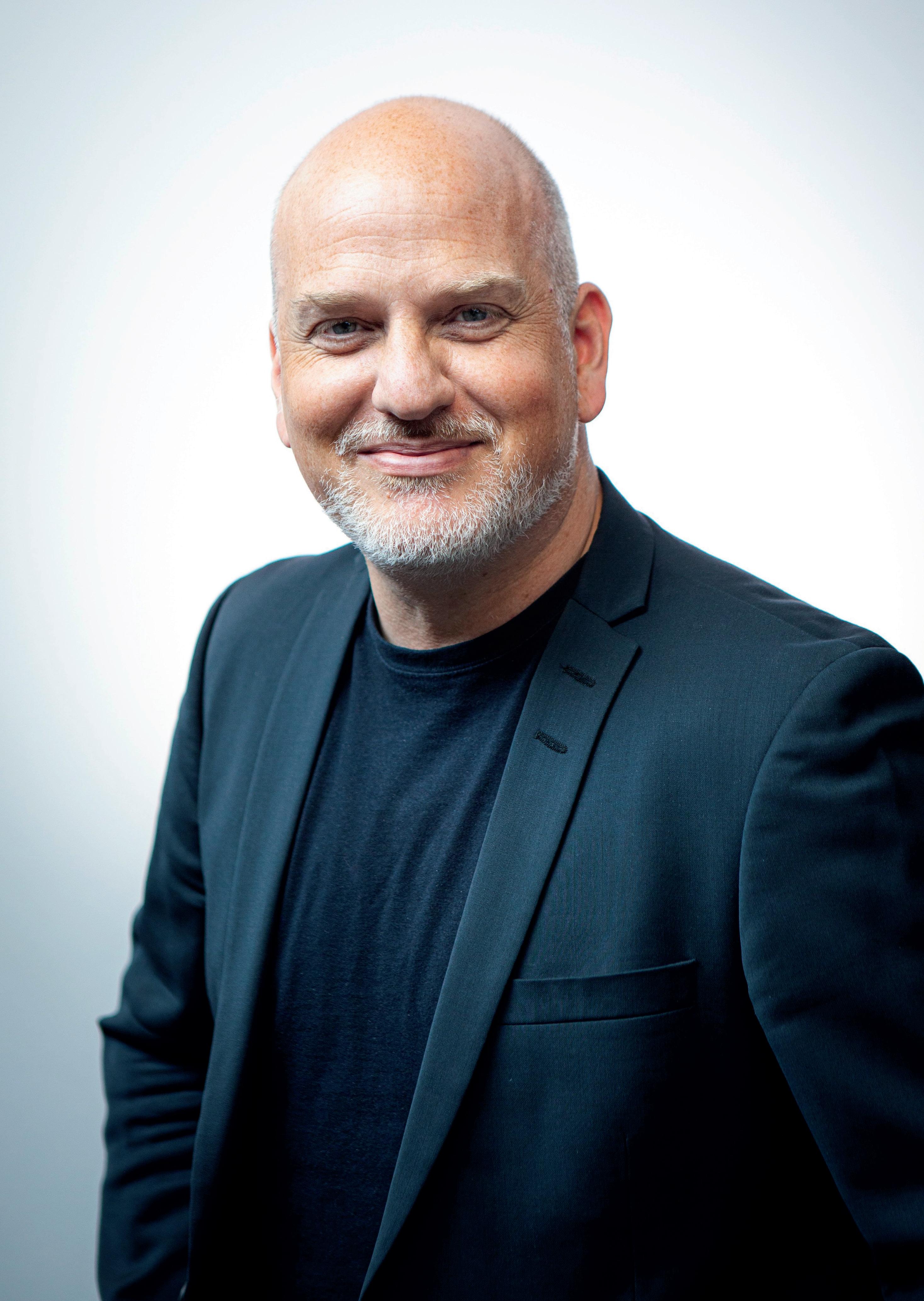
Global Executive Creative Director of IPG-X
Nick Cooper, the Global Executive Creative Director of IPG-X, is redefining luxury and automotive branding through his pioneering approach to Connected Creativity. In this exclusive interview with The Executive Magazine, he shares insights on how collaboration and innovation are shaping the future of these prestigious sectors
WWith over thirty years of experience at the forefront of design and advertising, Cooper has pioneered the concept of Connected Creativity, seamlessly integrating strategy and execution to create compelling brand narratives that captivate discerning consumers. In this exclusive interview with The Executive Magazine, he shares his insights on the transformative power of collaboration, the shifting dynamics of consumer expectations, and the bold innovations shaping the future of the industry
With over three decades in the design and advertising industry, particularly within the luxury and automotive sectors, how have you seen the market evolve, and what key trends do you believe are currently shaping the future of these industries?
“The wider industry has seen significant changes over my time in it, with huge innovation in digital tools and the role of data to shape how we deliver and measure creativity. The importance of simple, powerful, creative ideas that are beautifully crafted endures but how those ideas are created and the pace at which they evolve has emphasised the need to stay curious and embrace innovation. Creating a consistent brand experience between digital and physical worlds is now crucial to building authentic relationships between brands and audiences.
“As the market has evolved, we’ve seen the need to develop an agency structure with collaboration and ‘Connected Creativity’ at the heart.
“The luxury sector is somewhat of a contradiction, in that the most enduring brands have timeless values that are their appeal, but to attract growth audiences they must embrace the latest technologies and social platform opportunities. The tropes of luxury have shifted as they are interpreted by a more socially connected and sustainably responsible world. Conspicuous consumption has not totally vanished, but the way it is displayed and communicated has.
“In automotive, the most notable shift has been the transition from internal combustion engine (ICE) vehicles to electric vehicles (EVs). This move towards sustainability is not only reshaping the automotive industry but also influencing consumer expectations and brand strategies – as people’s need for a car shift towards broader mobility and lifestyle solutions.”
Your approach to Connected Creativity has been a cornerstone of IPG-X’s success. Can you elaborate on how this model has transformed the way your agency collaborates internally and with clients, and why this integrated approach is crucial in today’s business landscape?
“Connected Creativity has fundamentally transformed our agency by breaking down traditional silos and fostering a culture of collaboration. This model integrates strategists, creatives, designers, and digital specialists, ensuring that every campaign is cohesive and aligned with the brand’s core values. Internally, it has encouraged cross-disciplinary teamwork, leading to more
innovative solutions. For our clients, this approach means we can deliver seamless brand experiences that resonate with consumers across multiple touchpoints.
“An essential aspect of this model is the important role of social channels. In today’s digital age, social media is a critical platform for engaging with audiences and amplifying brand messages. Therefore, we think socially from the start of a new brief, ensuring that our strategies are designed to leverage the power of social media effectively. This integrated approach allows us to create campaigns that are not only cohesive but also highly engaging and shareable, driving greater impact and reach.”
Crafting brand experiences for high-end clients like Bentley and Princess Yachts requires a deep understanding of luxury consumers. What do you consider the most critical elements in creating campaigns that resonate with this discerning audience?
“The most critical elements in creating campaigns for luxury audiences are to reflect their values and aspirations, so it’s essential to craft narratives that resonate on a personal level. As we look to build global brands, we need to develop long term brand strategies that are distinctive and consistent, with enough flexibility to be relevant at a local level. Luxury brands need to have the confidence to lead but also be culturally aware enough to be alongside their customers in a way that feels relevant. We need to grab attention but also build lasting connections with discerning consumers, creating interactions that feel one-to-one, not one-to-many. Getting the small details right in execution is crucial, with hyper-personalisation an area that we are seeing as increasingly important for ultra-high net worth individuals.”
Entrepreneurialism is often marked by both triumphs and challenges. Can you share a significant challenge you’ve faced in your career, how you overcame it, and what lessons you’ve carried forward into your leadership role today?
“Perhaps the most significant challenge I’ve faced was moving from being someone in a creative team, to leading teams and now having wider responsibilities for the direction of IPG-X as Global ECD. The shift from only considering the creative brief in front of me to steering and mentoring different discipline teams was an accelerated and, at times challenging learning experience – I had to accept that I needed to take a step back from owning every detail and focus more on developing talent, without giving up the enjoyment I get from being in the day-to-day creative process.
“I count myself lucky to have worked in a variety of agencies and gained understanding of many disciplines and brand touchpoints, across a wide range of sectors, and in different parts of the world. This has enabled me to turn up authentically, to steer ideas for different audiences and in different channels, bringing a nuance of approach to connecting different disciplines. For me moving forward, it’s about collaborating the right creative minds with the right opportunities – innovating agency structures to instil more Connected Creativity, and staying curious and being open to new ways of creating.”
The luxury market is rapidly evolving, with new technologies and consumer behaviours constantly emerging. How do you ensure that IPG-X stays ahead of the curve and continues to deliver impactful campaigns that resonate globally?
“As an Interpublic Group agency, we are fortunate to draw on the

expertise within the wider network and the great work happening in offices all over the world every day. Having a local connection to so many people and places enables us to identify global truths, and that help us build powerful and consistent communication strategies.
“We are constantly looking at emerging technologies to help us create – looking at how innovation can power up our ways of working to deliver compelling experiences for our brand’s audiences. There is perhaps no hotter topic in the creative world than AI. Understanding how to embrace new tools, with a sense of responsibility, will open unbelievable opportunities. Collaborating with those on the front edge of what’s possible is crucial to building the right team as we move into a fast-paced future.”
What advice would you give to aspiring business leaders who are looking to make their mark in the creative industry, particularly in sectors like luxury and automotive? What qualities do you believe are essential for success in this field?
“I would say that turning up every day with energy and authenticity is good advice for anyone with aspirations to lead. In the creative industry communication skills are obviously hugely important too – with nothing more valuable than helping make complicated things easy to understand. The power of simple, original ideas is important to get everyone bought into the direction of travel. You need to cut through the noise with consistency, so that those you are trying to catch the attention of recognise you quickly and start to trust you.
“As you gain experience, the value of knowing what not to say and do is often more powerful than being excited about all the things that are possible. As a creative lead, helping people be clear, concise and compelling is where I spend a good chunk of my time. And this has been proven over the years as the most
effective way to build strong relationships with colleagues and clients.”
As someone who has successfully bridged the gap between strategy and execution, what do you think are the key factors in maintaining a cohesive brand vision across multiple touchpoints, especially in a global market?
“Maintaining a cohesive brand vision requires a clear and consistent brand narrative that resonates across all touchpoints. It helps to have a long-term vision in order to make short term decisions. Involving the right people at the start of a project, to connect thinking from the outset, is empowering.
“Simple, bold ideas are essential as they help connect work across different communication channels, ensuring that the core message remains strong and impactful. It’s easy with the proliferation of brand touchpoints to have too many things to say at once. Working with clients on comms planning helps do less, better.
“My background in design and art direction has helped me understand the value of maintaining a strong and consistent set of visual brand assets. Creating a recognisable brand aesthetic, which goes beyond just a logo, colours and typeface is key to reinforcing a brand’s identity.
“Working in an agency that understands how to lead brand experience across multiple channels puts us in a unique position to connect thinking and execution seamlessly.”
In your experience, what unique challenges do luxury brands face when it comes to digital and social media engagement, and how can these challenges be turned into opportunities for growth and consumer connection?


“Luxury brands face the challenge of maintaining their exclusivity while engaging with a broader audience on digital and social media platforms. As brands look to grow, we’ve found social channels present a fantastic opportunity to develop future audiences, meeting them in a more culturally connected and less corporate way. Our social team is constantly evolving the way we create content for these platforms to be relevant while still maintaining brand consistency. In a constantly shifting landscape, authenticity doesn’t have to mean a lack of craft in execution; in fact, it should enhance it.
“Social platforms are also great places to collaborate with external creators and makers. These partnerships can bring fresh perspectives and introduce new audiences to the brand. By working with influencers, artists, and other creative professionals who align with the brand’s values, we can create content that resonates with more targeted audiences.”
Given the increasing importance of sustainability and ethical practices in the luxury sector, how do you see these values influencing the future of brand storytelling and consumer expectations?
“Consumers are increasingly expecting brands to demonstrate social and environmental responsibility. Brands that can effectively integrate sustainability into their narratives and demonstrate genuine commitment are building stronger connections with audiences and enhancing their reputation.
“There is an opportunity for luxury brands to use innovation in sustainable practices to re-tell stories at the heart of how they make their products. For example, developing a more sustainable alternative to leather is a clear demonstration of change –as well as opening up more sustainable choices, it still enables us to demonstrate the craft in hand stitching – a timeless skill to behold.”
Finally, looking ahead, what are your personal and professional goals as you continue to lead IPG-X? How do you envision your role evolving, and what legacy do you hope to leave in the industry?
“I’ve done several personality tests over the years – and while I have always come down on the side of creativity and introversion, I always manage to confuse the moderator with a love of consistency and bold communication. I’d like to think it is this mixture of creativity and effectiveness that has enabled me to progress in my career.
“I’ve helped build an agency with that same mix. An agency that wants to make work that works but cares about everything being crafted and considered in execution.
“I hope the people I work with at IPG-X would say I care hugely about the work – and that my passion for pushing what is possible creatively steers my decision making.
“Outside of the agency, I’d like clients to see me as someone who wants to understand and connect every facet of their brand in building for the future.”

In this exclusive interview for The Executive Magazine, Zuhairah Scott Washington shares insights from her remarkable journey, offering a glimpse into the future of global business and the qualities essential for leadership. A transformative leader in technology and business, she has driven innovation and hyper scalability across Fortune 500 giants
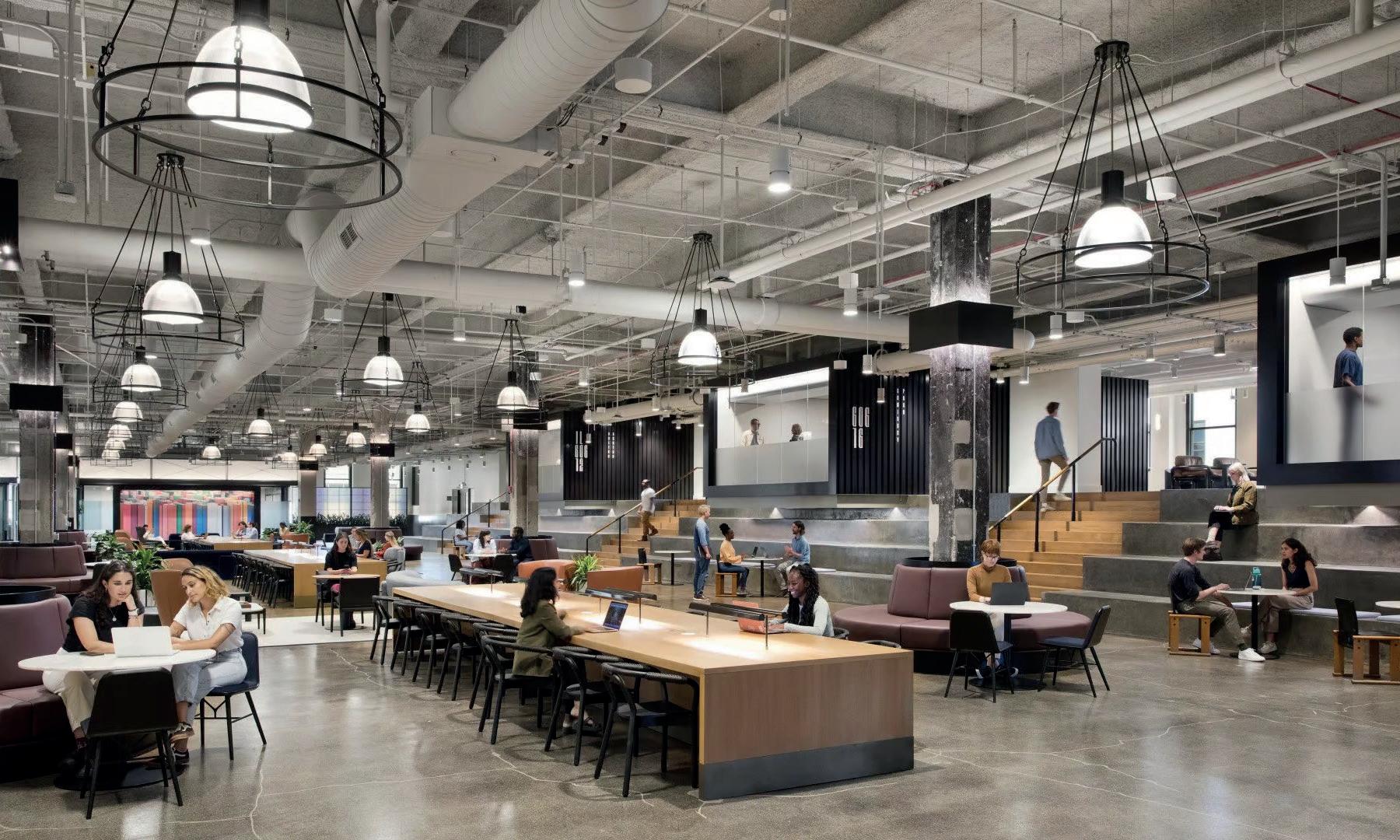
ZZuhairah Scott Washington stands as a transformative force in the corporate world, navigating the dynamic intersections of technology, business, and leadership. With a career spanning from startups to Fortune 500 powerhouses like Uber and Expedia, her ability to drive hyper scalability, innovate across diverse sectors, and break barriers in maledominated industries is unparalleled. In this exclusive interview for The Executive Magazine, she shares the insights and strategies behind her remarkable journey, offering a glimpse into the future of global business and the essential qualities needed to lead it.
You’ve successfully navigated digital transformations across various industries, including travel, real estate, retail, fintech, and e-commerce. What unique challenges and opportunities do you see in these sectors, and how do you tailor your strategic approach to each?
“Each sector presents its own set of challenges and opportunities, shaped by different market dynamics, consumer behaviours, and regulatory environments. In travel, for instance, the focus is on personalisation and seamless experiences, while in fintech, security and trust are paramount. My approach involves deep immersion into the industry to understand its nuances, combined with a cross-pollination of insights from my experience across sectors. This allows me to tailor strategies that are not only relevant but also innovative, pushing the boundaries of what’s possible while addressing the unique pain points of each industry.”
At Uber, you scaled the market by 25 times within three years, and at Otrium, you achieved a 1,000% revenue growth year-
over-year. What key factors contribute to achieving hyper scalability, and how do you maintain operational excellence during rapid expansion?
“Hyper scalability requires a delicate balance between vision, execution, and agility. The key factors include having a scalable infrastructure, a data-driven approach to decision-making, and a relentless focus on customer experience. At Uber, we built a robust tech platform that could handle exponential growth, while at Otrium, we leveraged data insights to constantly refine our strategy and core value proposition to brands. Maintaining operational excellence during such rapid expansion involves creating a strong organisational culture that values adaptability, continuous learning, and cross-functional collaboration.”
Both Expedia and Uber are known for their innovative approaches to business. Can you share specific instances where your leadership directly led to significant innovations or business model disruptions?
“One of the most impactful innovations I led at Uber was the successful passage of first-of-its kind rideshare legislation in the District of Columbia dubbed a “model for the rest of the country.” Second was leading efforts to use Uber’s size and scale to focus not only on the needs of riders but also on the needs of drivers. A key innovation was working across the business to greenlight driver-centric benefits, such as 24/7 phone support and in-app tipping. These initiatives not only improved driver satisfaction and retention but also reinforced Uber’s commitment to a sustainable and balanced marketplace. By prioritising both sides of the platform, we were able to improve driver loyalty, drive significant growth and ensure long-term success of the business.”
As a board director for public companies like FIVE and OLO, what do you believe are the most critical elements of effective
corporate governance, and how do you balance your roles as an executive and a board member?
“Effective corporate governance hinges on transparency, accountability, and strategic oversight. As a board director, it’s crucial to foster an environment where diverse perspectives are valued and rigorous debates are encouraged in the boardroom. Balancing my roles as an executive and a board member involves a commitment to staying informed about the company’s operations while also maintaining an independent viewpoint that allows me to provide unbiased strategic guidance. I strive to ensure that the long-term vision aligns with the company’s operational realities while upholding the highest standards of governance.”
As one of the 100 Most Influential Blacks in Corporate America, what advice would you give to aspiring female leaders looking to break into senior executive roles in traditionally maledominated industries?
“My advice to aspiring female leaders is to embrace your unique strengths and perspectives, and strategically invest in building relationships across lines of difference—whether that’s race, age, or other dimensions—to ensure you are deeply known by people who have the power to promote and protect you. In maledominated industries, it’s crucial to build a strong network of male advocates who can support your journey. Don’t be afraid to take calculated risks and speak up for yourself and others. Resilience, continuous learning, and the ability to navigate challenges with grace and determination are key. Remember, your voice and leadership are not only valuable but necessary for driving meaningful change in these industries.”
for the next generation. Success, for me, has been about staying true to my values, continuously learning, and not allowing barriers to define my trajectory.”
Having founded your own technology company and invested in high-growth startups, what qualities do you look for in entrepreneurs and new ventures before deciding to invest, and what common pitfalls should they avoid?
“I look for entrepreneurs who are not only passionate and driven but also adaptable and resilient. The ability to pivot when necessary, combined with a deep understanding of their market and a clear vision for growth, are qualities I value highly. It’s important that they are data-driven and willing to learn from failures. Common pitfalls to avoid include underestimating the importance of a strong team, neglecting customer feedback, and scaling too quickly without a solid foundation. It’s about striking the right balance between ambition and execution.”

Can you discuss any specific challenges you’ve faced as a female leader in the tech industry, and how you have navigated and overcome these obstacles to reach your current level of success?
“One of the significant challenges I’ve faced is overcoming unconscious bias and the often unspoken expectations placed on black, female leaders in tech. My strategy for overcoming these challenges is to be as close as possible to the part of the organisation that generates revenue or the key results that matter most to your business. When you are proximate to the key activities that drive the business forward and you deliver, it is very hard for people to discredit your impact. I have always stayed close to the P&L and revenue side of the business as a result. Navigating these obstacles required a combination of resilience, strategic networking, and a focus on delivering results. I’ve learned to assert my expertise confidently, build alliances across the organisation, and mentor other women to help pave the way
In your view, what are the most significant trends and innovations on the horizon for the sectors you’ve worked in, and how should companies prepare to stay ahead of these changes?
“The most significant trends include the rise of artificial intelligence and machine learning, the increasing importance of data privacy, and the shift towards more personalised and immersive customer experiences. Companies should invest in building a flexible and scalable tech infrastructure that can adapt to these changes. Continuous innovation should be ingrained in the company culture, and cross-industry collaboration can provide new insights and opportunities. Staying ahead means not only keeping pace with technological advancements but also anticipating consumer needs and regulatory shifts.”
Having successfully led Otrium’s expansion into the US market, how do you approach entering and scaling operations in overseas markets like the UK? What differences have you observed between operating in the UK versus other global markets, and how do you adapt your strategies to address these regional variations?
“Entering new markets requires a deep understanding of local cultures, consumer behaviours, and regulatory landscapes. In the UK, for example, there’s a strong emphasis on sustainability and ethical business practices, which shaped our market entry strategy at Otrium. The key is to maintain the core brand identity while being flexible enough to adapt to regional differences. It’s about being globally consistent yet locally relevant.”
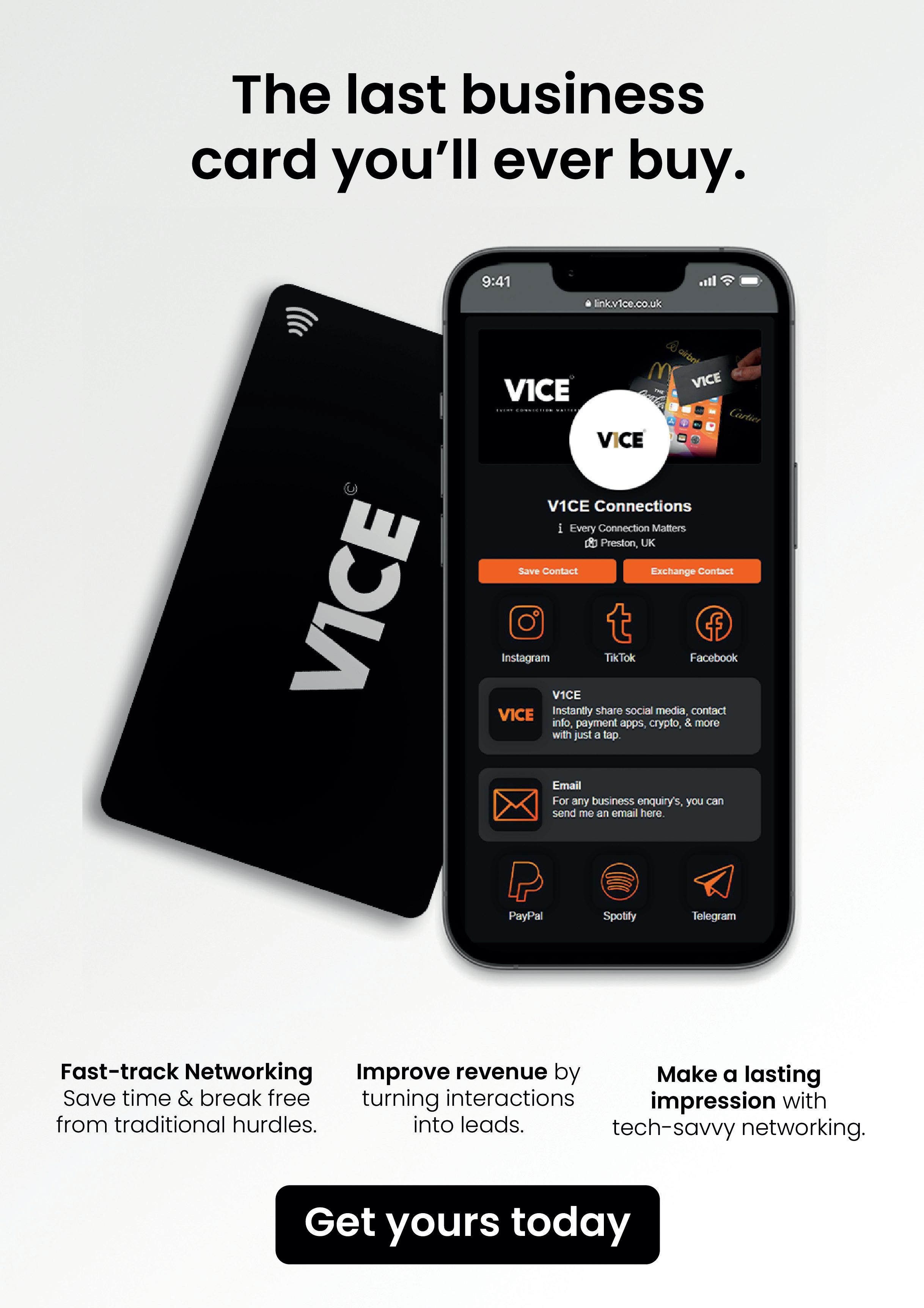
Join The Executive Magazine at The Business Show 2024, where the brightest minds in business will converge for an extraordinary celebration of entrepreneurialism and innovation. Taking place at London’s ExCeL on the 13th and 14th of November, this landmark event marks the 50th edition of the UK’s largest business show. Attendees will gain access to world-renowned speakers, leading brands, and unique opportunities designed to accelerate business growth
TThe UK’s most highly anticipated business event, The Business Show 2024, is set to take place on the 13th and 14th of November at London’s ExCeL, marking a milestone in the event’s illustrious history. This year’s show promises to be the grandest yet, celebrating 50 editions of supporting entrepreneurialism, fostering small business growth, and driving innovation. As a leading platform for entrepreneurs, startups, and established businesses alike, The Business Show will pull out all the stops for this golden edition, offering unrivalled insights and opportunities for attendees.
The Executive Magazine is proud to announce its attendance at The Business Show 2024, offering an exclusive opportunity for partners, collaborators, and attendees to connect with the esteemed team behind the brand. This event provides the perfect setting for those eager to engage with the publication’s leadership, discuss potential partnerships, and explore how The Executive Magazine continues to shape conversations within the luxury business sector. As a respected voice in the industry, The Executive Magazine welcomes this chance to strengthen relationships and forge new collaborations with businesses and entrepreneurs alike.
The Business Show first launched in 2000, during a time when the landscape for business publications was rapidly shifting due to the rise of the internet. Originally established as a magazine, the founders recognised the changing tides and made a pivotal decision to transition into event hosting. Their vision was to provide a platform where entrepreneurs could find the support, resources, and connections needed to launch and grow their businesses. Since that pivotal switch, the show has expanded and grown with each passing year, continually adapting to the evolving needs of the business community.
2023 proved to be a breakthrough year for Business Show Media, with a remarkable global expansion. September saw the show’s successful launch in Los Angeles, attracting global attention and laying the foundation for future international editions. The momentum will continue with the forthcoming Business Show Miami, scheduled for March 2024, further reinforcing the brand’s
international presence. Over the years, The Business Show has built a powerful portfolio of events not only in London but also in LA, Miami, and across Asia, with further expansion into new regions on the horizon.
The upcoming 50th edition promises to be a fitting celebration of its journey so far. Keynote speakers from past shows will return, offering valuable reflections on their business successes, sharing insights and strategies that have shaped their achievements. These high-profile speakers will deliver expert advice and actionable takeaways, making the event an essential opportunity for those eager to learn from industry leaders.
Major global brands and long-term exhibitors will once again grace the show floor, presenting cutting-edge products and services tailored to help businesses achieve their growth objectives. In addition to the wealth of knowledge and networking opportunities, an exceptional highlight will be the black-tie awards ceremony taking place on the evening of 13th November. Replacing the traditional exhibitor party, this prestigious event will celebrate excellence in business, honouring outstanding suppliers and speakers with industry awards.
One of the most exciting elements of this year’s show is the unprecedented opportunity for aspiring entrepreneurs. A unique competition offers the chance to win a £50,000 business package, including £10,000 in cash, as well as essential resources to kick-start a business venture. Prospective founders will be invited to pitch their ideas in front of a distinguished panel of experts. Only a few will be selected to compete at the event, with the ultimate winner receiving the full prize package to bring their entrepreneurial dream to life.
With such an incredible range of activities, insights, and opportunities on offer, The Business Show 2024 is set to be an unmissable event for anyone serious about business growth and success. Free tickets are available for those eager to attend what promises to be the largest and most significant edition yet. The event will take place at London’s iconic ExCeL on 13th and 14th November 2024, and early registration is strongly advised.
Don’t miss your chance to be part of this extraordinary occasion, where the brightest minds in business converge to shape the future of entrepreneurialism.
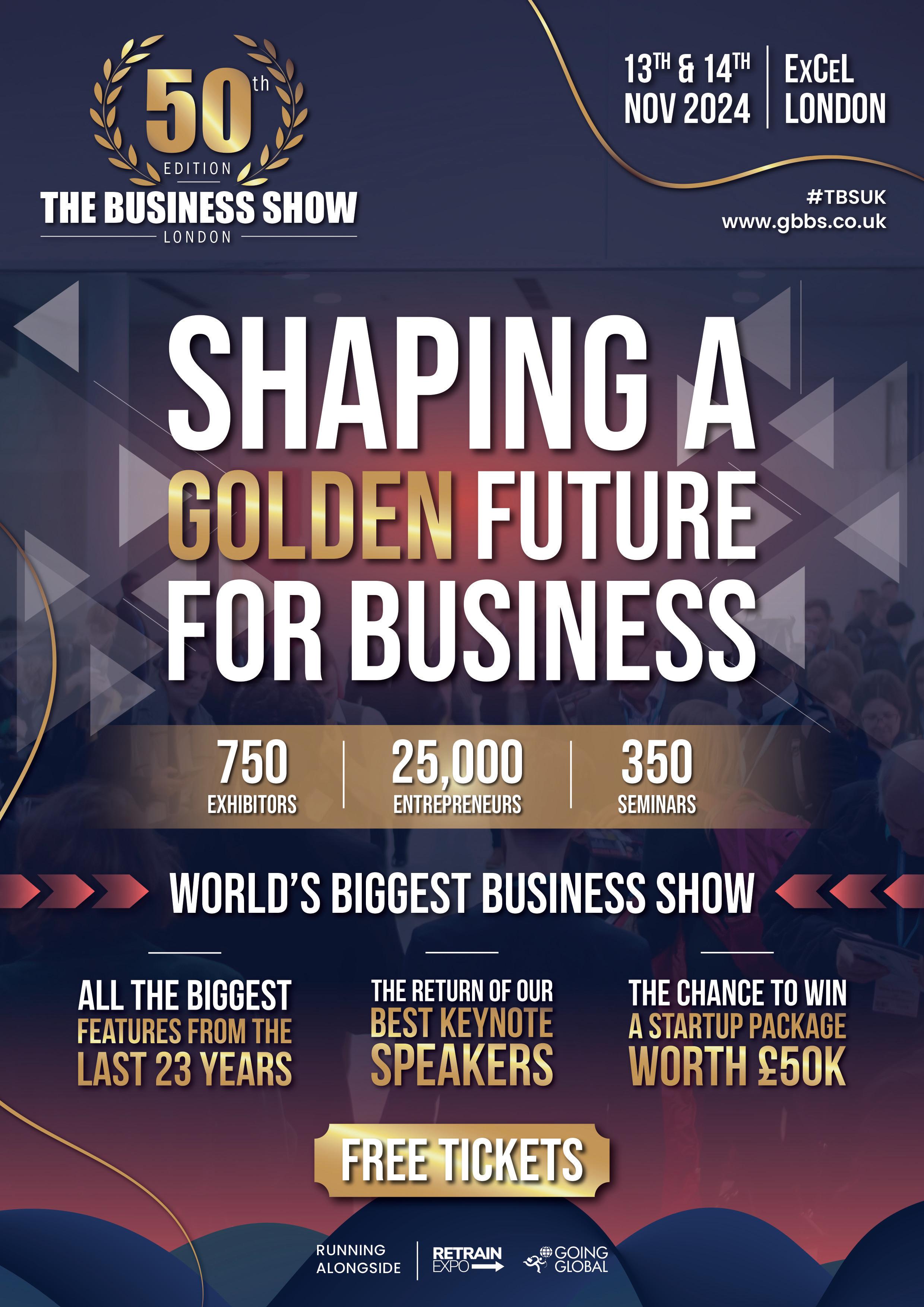

at Automobili Pininfarina
Paolo Dellachà stands at the forefront of luxury automotive innovation as the Chief Executive Officer of Automobili Pininfarina. With a distinguished career marked by engineering excellence and strategic vision, he is developing the iconic brand into a leader of bespoke automotive artistry. His journey reflects a commitment to pushing the boundaries of design and performance, ensuring that Pininfarina honours its storied legacy and embraces a dynamic future in the world of high-end automobiles
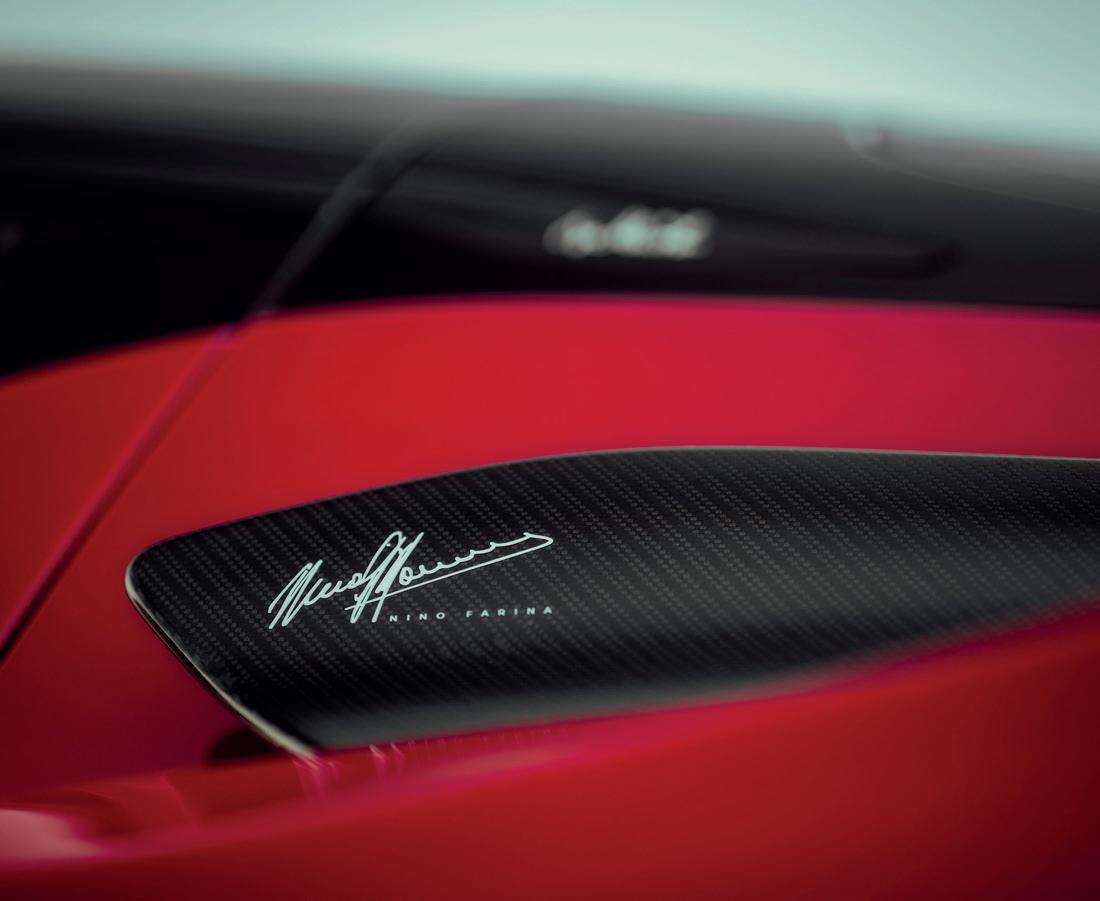


PPaolo Dellachà assumed the role of Chief Executive Officer at Automobili Pininfarina in January 2023, marking a pivotal moment for a brand renowned for its bespoke luxury vehicles. Prior to this appointment, he served as Chief Product and Engineering Officer since May 2020, during which time he significantly contributed to the company’s strategic direction.
At the helm of Automobili Pininfarina, Dellachà is responsible for establishing the overarching brand and product strategy. His leadership has been instrumental in the company’s evolution, steering it towards a marked increase in bespoke commissions year on year. This trajectory reflects not only the brand’s commitment to exclusivity but also Dellachà’s vision for the future of luxury automotive design and engineering.
Dellachà’s notable achievements include spearheading the development of groundbreaking products such as the B95 hyper Barchetta and the PURA Vision design concept. His hands-on approach to innovation is exemplified by his previous work on the Battista, which is celebrated as Italy’s most powerful road-legal hypercar. This project highlighted his ability to transform ambitious ideas into tangible, highperformance vehicles, showcasing a meticulous attention to detail and engineering excellence.
Bringing a wealth of experience from the automotive sector, Dellachà has cultivated a collaborative atmosphere within the company. His engineering background allows him to integrate seamlessly across various disciplines, fostering a results-oriented environment among design, engineering, commercial, and operational teams. This holistic approach not only enhances productivity but also fuels creativity, essential in an industry that thrives on innovation.
Before joining Automobili Pininfarina, Dellachà honed his expertise at prestigious brands including Alfa Romeo, Maserati, and Ferrari. His rich professional history is complemented by a Master’s degree in Mechanical Engineering from the Polytechnic University of Milan, reinforcing his technical credentials and strategic insight.
Beyond his professional pursuits, Dellachà is an avid sportsman, engaging in activities such as skiing, tennis, basketball, swimming, and running. His diverse interests extend to motorsports, travel, art, and cinema, reflecting a well-rounded personality that appreciates both the thrills of speed and the nuances of culture.
With his engineering expertise and strategic insight, Dellachà is guiding the brand towards a future that embraces innovation and excellence. Under his stewardship, Automobili Pininfarina is not only maintaining its prestigious heritage but also paving the way for exciting developments that will resonate with discerning clients and car enthusiasts alike. As the company continues to grow, Dellachà’s vision and passion for design will undoubtedly play a crucial role in shaping its future.

TThroughout her career, Ella d’Amato has carved a path of innovation and leadership, moving from marketing to interim CEO of Notonthehighstreet.com, and now co-founding the social commerce platform “i love it.” In this exclusive interview with The Executive Magazine, Ella discusses her leadership journey, the driving force behind her mission to reshape online shopping, and the unique challenges she has faced as a female entrepreneur in traditionally male-dominated industries. Her insights offer a glimpse into the future of commerce and what it takes to lead with authenticity.
Your career trajectory has been remarkable, from starting in marketing at Omnicom to leading NOTHS and now co-founding i love it. Could you share some key lessons you’ve learned along the way that have been instrumental in shaping your leadership style?
“My style has evolved over time from when I joined as a PA in Marketing, and throughout all the different experiences, but overall I try to lead through kindness. You can have the best idea in the world but if you don’t have a thriving team, and culture that nurtures them, the results won’t come. For me, the team is the most important part of any business. I try to help people direct their energy towards the things they can control and not waste time on things they can’t.
“I believe in being open and honest with each other, using time to prepare and prioritise the right things, being brave and not perfect, staying curious and always learning. One thing’s for sure, it won’t always go your way, but resilience forms around the challenges – and those hard things make you more well-rounded. I have learned to accept that there will be good and bad days, and forever try to ensure there are more good than bad. I am not scared to make tough decisions but I do them inline with my values. In fact, the first thing we did as a team was to align on the behaviours we wanted to shape i love it around, and they are kindness, courage, passion, fairness and fun.”
With the launch of i love it, you’re entering the rapidly evolving social commerce sector. What do you see as the most significant opportunities and challenges in this space, and how do you plan to position i love it to capitalise on these trends?
“As you say, the pace of change and growth around social commerce is crazy. It’s predicted to reach $30trn by 2030. For me the major challenge with social commerce is authenticity and trust. The number of times I hear from brands, shoppers and friends that they don’t trust social media platforms or influencers, is staggering. A recent study suggested 77% of us in fact don’t trust influencers. What we do however trust is our friends, family and people with real experience and passion. For us, this was the start of our story. What we found is that when we know that a person genuinely loves something, what they share matters more – to themselves, brands and others. And thus i love it was born. Where other social commerce platforms might feature people selling to each other, or for brands, on our platform you actually have to love it. Bottle that and I believe we can become the platform that offers shoppers, brands and creators no regrets. We become the positive corner of that huge social commerce industry.”
The i love it platform is built around the idea of creating a fairer shopping environment with fewer returns and greater customer satisfaction. What inspired this mission, and how do you see it impacting consumer behaviour in the long term?
“We live in a world where shopping socially is the new highstreet – the problem, as we just alluded to, is who and what we can trust? Paid ads, paid influence, #sponcon, and the rising use of inauthentic product recommendations all make shopping a minefield. Often the people promoting the product haven’t even tried and tested it. Some are even in contracts that mean that they can’t actually tell people what they really think about a product or what alternatives they like.
“It is also incredibly hard for smaller brands, even if they are brilliant at what they do, to get any visibility, because huge giants like Shien or Temu dominate ad spaces. Just getting discovered is so tough. So with that in mind, that’s why there are no ads on i love it. Why people, when they sign up to share, need to sign that they love the product in question. Why we have a flat commercial structure for all brands, meaning that sharers are not being incentivised to push one product more than another. In short, the best products and most trusted sharers, whatever their size, will naturally rise to the top. For us, the intention is to create a fairer and flatter playground for brands and people alike.
“A big ambition from this approach also relates to the environment. We all hate having to return things bought online, it’s commercially tough for brands and of course the planet doesn’t thank us for it either, so we are using AI to train our feeds on understanding the customer so that we can put the best products infront of them, whatever their passions. Our goal, as we learn and get better, is to reduce online returns by half.
“Bringing it back to the question though, we hope i love it impacts on consumer behaviour by planting one simple thought in people’s minds as they go to shop; ‘why shop elsewhere when I can use a platform I trust, where everyone wins together – the customer, the brand, the sharer and the planet?”
As a female leader in a predominantly male-dominated business world, what unique challenges have you faced, and how have you overcome them? What advice would you give to aspiring female executives who are navigating similar paths?
“While media, retail and tech are very much male-dominated, I have been incredibly lucky to work with some amazing people throughout my career, many of which were super inspiring women. I believe in women supporting women, as much as I believe in giving opportunities whatever a person’s background, race, gender or beliefs.
“Philippa Brown was an incredible role model for me at Omnicom, always facing difficult things straight on and creating amazing teams. At notonthehightstreet 90% of the small businesses we supported were female led, and the executive team were mostly female too. We supported each other and our male colleagues were incredibly supportive too. Holly Tucker and Sophie Cornish who founded NOTHS, were trailblazers for their time and grew one of the first marketplaces in the UK with amazing success.
“Those experiences have thus carried through. I now work with some amazing women, like Sophie Robinson, ex MD of Stylist UK, whose energy and positivity is incredible. Malin Gregeren
and Jessica Chapplow who are leading the way for women in AI, product development and tech, proving themselves to be innovators in a challenging space.
“I wouldn’t say the challenges I have faced are unique, more the general challenges many women face whilst navigating life; having my children, maternity leaves and returns, juggling being a mum and leader, and yes dealing with some people who seem hell bent on belittling or undermining my efforts. My advice is always centred on creating the best support system around you. I couldn’t do what I do without my amazing husband, friends and family. I have also found that my children are happy if I am happy.”
Building a new venture like i love it comes with its own set of challenges. Could you share some of the toughest obstacles you’ve faced as an entrepreneur, and how you’ve managed to navigate them while staying true to your vision?
“Fundraising as a woman is super challenging – only 2% of VC money goes to women founders, so that instantly puts me at a disadvantage when out raising money. It was tough last year but I didn’t let that stop us. We raised £3m in January, we are out raising again now, and I honestly think i love it is such a fantastic opportunity for an investor, so it’s a pleasure to be out there hearing all the positivity around the business.
“Related to my leadership style, I value humbleness and that can sadly be mistaken for a lack of confidence in the investor world, so I have been working on how I stay true to myself, whilst doing justice to the amazing opportunity I believe i love it will bring us all for years to come.
recognise the need to diversify their teams, and the positive impact that has on business results overall.
“I am a proud member of the WHITSEND community – a group of women in senior leadership positions in digital and tech. Which is full of amazing female tech leaders that inspire me daily.
“But there is always more we can do to support and encourage more women to step into these roles. If you are hiring a manager, simply insist on having an equal split of candidates to invite for interviews, as a minimum. And if you know a woman that is great, sing her praises to people you meet. Similarly, if you see potential in a girl or young women, support her by helping her get some work experience in tech or by introducing her to other women in tech.
“And lastly, to those women thinking, should I step into these roles, I would encourage you to be the role model you wished you had and do it.”
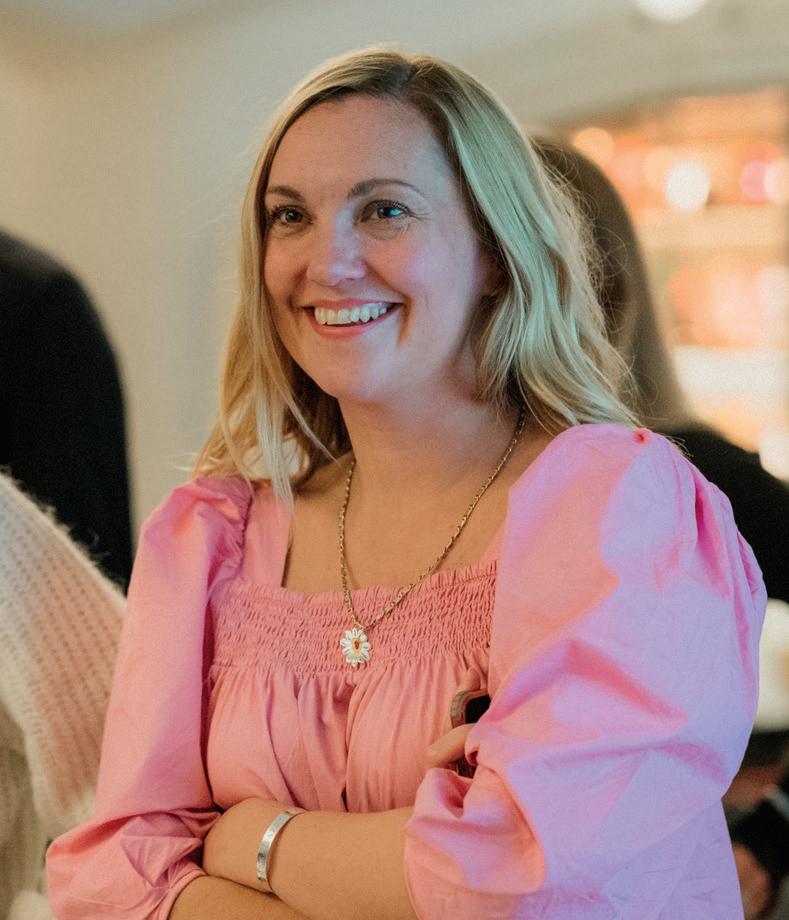
“The vision is about creating a fairer and trusted shopping space for all. We have had some challenges from those stating that we would make money faster if we let brands determine the commission level, or placed ads on the platform. Whilst that may be true,it would completely destroy our vision. Therefore we have had to hold strongly to that, by explaining to them how being firm on authenticity will lead to a much bigger and better company in the long term. In fact, our early users say the thing they love the most about the experience is the authenticity.”
The tech and e-commerce sectors have historically been challenging for women to break into. Do you believe there are now greater opportunities for female leaders, and what can be done to support and encourage more women to step into these roles?
“I do believe there are greater opportunities for women in tech now. Much of which has come as more and more companies
As someone who has transitioned from corporate leadership roles to launching your own startup, how do you balance the visionary aspects of entrepreneurship with the practical challenges of building and scaling a business from the ground up?
“Naturally it is incredibly different running a startup to a larger organisation. Everyone you hire has to have a growth mindset, be able to work at pace, be OK with change and get energy from learning and failing fast.
“We keep our heart on the vision and our mind on building it block by block. Time is your most precious element, so making decisions at pace, with the right mix of science and art is what makes it exciting. We’ve made sure to hire a team with a mix of start up experience and category experience to ensure we can learn from all the mistakes we’ve made in the past and create our own path to growth with i love it in the present.”
With i love it gaining momentum, what are your future goals both for the company and yourself? Are there other sectors or initiatives you’re passionate about exploring in the coming years?
“Our goal over time is to become the ‘Every Passion Store’, and reset what people powered shopping means. I love it will eventually include everything you could possibly love and recommend – it will be there for you, and feel personal and relevant throughout your whole ‘love life’. We want to be the most trusted platform out there and we will properly democratise the value of word of mouth and put money back into the hands of people so they can do more of what they love.

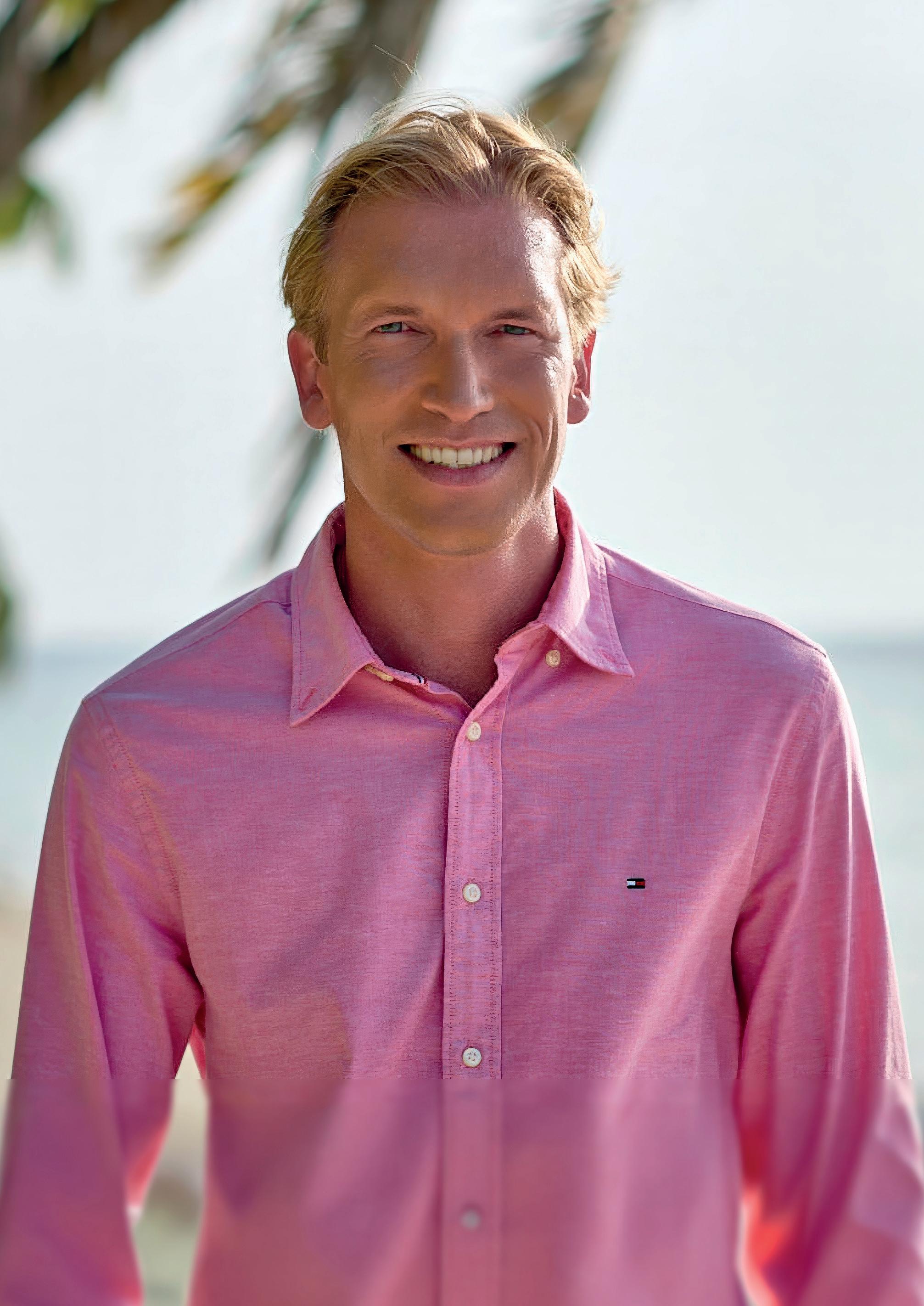
Elias Pertoft is set to redefine luxury hospitality at the Waldorf Astoria Seychelles Platte Island. With over 16 years of experience across the globe, Elias combines opulence with conservation in this pristine paradise. In this exclusive with The Executive Magazine, he shares his vision, the challenges of blending luxury with sustainability, and what makes this resort a groundbreaking venture in high-end travel
IIn the world of luxury hospitality, few have charted as impressive a course as Elias Pertoft. With over 16 years of experience steering prestigious resorts across Asia and the Caribbean, Elias has now embarked on an extraordinary new chapter as the General Manager of Waldorf Astoria Seychelles Platte Island. This ambitious project brings together his passions for high-end hospitality, environmental conservation, and marine adventure in a pristine, uninhabited paradise.
Under Elias’s leadership, the resort aims to redefine luxury by seamlessly blending world-class service with a steadfast commitment to protecting the island’s unique ecosystem. In this exclusive interview with The Executive Magazine, we delve into Elias’s journey, the innovative approaches shaping his latest venture, and his vision for the future of luxury travel and sustainability.
You’ve had a remarkable journey in luxury hospitality, leading prestigious properties across Asia and the Caribbean. What inspired you to take on the challenge of opening the Waldorf Astoria Seychelles Platte Island, and how has your past experience shaped your approach to this unique project?
“I was truly excited when I heard of this opportunity, it feels like a culmination of my career in luxury hospitality, conservation and watersports come together in a very unique way. Platte Island sits 130km from Mahe and there are no other islands in between, the ocean depth is over 3km on the side of this extinct volcano which is 14km wide and its 14km wide crater is the largest nursery in Seychelles for Hawksbill turtles, reef sharks and a large variety of


rays including eagle rays and manta rays.
“For me this is a once in a lifetime opportunity to create a resort which allows rare access for guests to this pristine ecosystem in the comfort of Waldorf Astoria’s iconic service with amazing wellness, dining and your own personal concierge at hand.”
The hospitality industry, particularly in luxury segments, is highly competitive and constantly evolving. What do you believe are the key trends shaping the future of luxury resorts, and how is Waldorf Astoria Seychelles Platte Island positioned to meet these demands?
“Todays luxury is about personal experiences, its about learning something new, to truly connect with the team; here on Platte Island we have a star team of over 40 nationalities that create moments with guests throughout their stay. For example our barrister Dennis who grew up on a coffee plantation invites you to roast your own coffee, our marine biologist Athina takes you on a reef walk to learn about the unique marine life that calls the atoll home. These are true connections that guests will remember forever.”
Building and managing a luxury resort on an uninhabited island like Platte Island presents unique challenges, especially in terms of sustainability and environmental conservation. Could you share some of the most significant challenges you’ve faced, and how you’ve overcome them while maintaining a commitment to luxury and ecological balance?
“A lot of thought has gone into how we can be a net positive impact on Platte Island; the island is home to the largest population of Hawksbill Turtles in Seychelles, we therefore put all the villas and building back 30-50m from the beach creating lush gardens for each villa but more importantly removing light pollution that could disturb the turtles when they hatch. We are 90% solar powered and are working to become 100%, large battery farms to store power and the largest solar farm in the Indian Ocean covers our team member village roofs. We have invested in compost machines to turn the kitchens to zero waste, any food waste is turned into compost that is fuelling our vegetable gardens. No plastic bottles and we are making our own water through desalination, not taking water from wells so the nature on the island gets all the rain water that comes in.
“Lastly we have Island Conservation Society on the island, an NGO that performs research and conservation programs on our marine life and the flora and fauna on land.”

Sustainability is increasingly becoming a priority for both travellers and hotel operators. How have you integrated sustainable practices into the design and operations of Waldorf Astoria Seychelles Platte Island, and how do these practices enhance the overall guest experience?
“Sustainability goes into everything that we do, we believe guests enjoy learning about the solutions we’ve found to leave a minimal impact on our surroundings. One other project to mention is that we are working with Bio gents to make the island mosquito free through carbon traps, it has been almost a year now and we are close to our goal.”
Platte Island was previously uninhabited, home to pristine wildlife and vulnerable species such as hawksbill and green turtles. How did you ensure the protection of this delicate ecosystem during the construction and development of the resort, and what ongoing measures are in place to preserve the island’s natural beauty?
“The whole design and architecture of the resort has been carefully planned to make sure that the lagoon and its marine and birdlife is protected. I personally believe that by having a presence here as a resort together with Island Conservation Society we can protect against the encroachment of the tuna industry which at times can be very destructive especially in uninhabited islands because of their remoteness where bad fishing practices can occur.”
In your role as General Manager, you’ve had to collaborate with local NGOs and neighbouring communities to protect the marine and wildlife environments in the outer islands of Seychelles. Can you elaborate on the importance of these partnerships and how they contribute to the long-term sustainability of the region?
“Seychelles is a young nation and before we set up our resort on Platte Island there was very little known about this very remote atoll, it is its own eco system and has an incredible amount of unique marine and bird life that call the island home. We are excited to partner with Island Conservation Society & Manta Trust to start researching this atoll and find out the species that come here. We have already seen that Humpback whales come close with their calfs and that the lagoon is a unique breeding ground to lemon sharks and manta rays; both of them are uncommon in the inner islands of the Seychelles. The most exciting part for me is that we are the first out here to start this research so it’s like opening up a treasure chest full of discoveries and as a guest diving with us you are very much part of this exploration.”
The hospitality sector is known for its challenges, from economic fluctuations to evolving consumer preferences. What advice would you offer to aspiring leaders in this industry who seek to navigate these complexities and succeed in luxury hospitality?
“The luxury traveller is changing, especially with younger generations valuing experiences above all, I believe it’s about being genuine and being a master of your destination; giving guests access to your advice on how to best experience every day on our island.”
Waldorf Astoria Seychelles Platte Island aims to set a new benchmark for luxury in the Indian Ocean. What differentiates this resort from other high-end properties in the region, and how do you plan to continually innovate to maintain a competitive edge?
“We aim to be a place where you can be as active as you want, learn something new; we are the only five star resort offering blue water fly fishing, we do wellness screenings and let you pick your lunch in our garden, our team are passionate specialists to learn more about coffee, tequila, rum, wine through dedicated masterclasses. We invite you to play a role in conservation programs. This will keep evolving and I think our competitive edge is our team and how passionate and engaged we are in our own almost geeky specialist fields so you as a guest can learn something new and be amazed.”
As you look to the future, what are your long-term visions for Waldorf Astoria Seychelles Platte Island? How do you see the resort evolving over the next decade, and what role do you envision it playing in the broader context of luxury travel and conservation?
“I believe we are setting a new benchmark which for many years have been led by independent small one off resorts and showing that it can be done even better under a recognised brand. We stand for luxury and personalised service, with Platte Island we prove that this can be combined with conservation and putting nature first.”
Finally, with your extensive experience and successful track record, what future endeavours do you foresee for yourself? Are there other areas within the hospitality or sustainability sectors that you are eager to explore or develop?
“I am just getting started, truly blessed to work in luxury hospitality and I see myself keep exploring different corners of the globe with my passion for nature conservation and creating personal and unique guest experiences.”



Gemma Krysko, the dynamic force behind global PR agency We Are Indigo and the innovative Queens of Tomorrow platform, sits down for an exclusive interview with The Executive Magazine. In this candid conversation, Krysko reveals how she’s transforming the landscape for women in business, sharing her journey through male-dominated industries, the challenges of tech entrepreneurship, and her bold vision for the future of female leadership
GGemma Krysko, the visionary entrepreneur behind the global PR agency We Are Indigo and the groundbreaking tech platform Queens of Tomorrow, shares her inspiring journey from the world of destination PR to tech entrepreneurship. As a female leader navigating traditionally male-dominated sectors, Krysko opens up about the challenges she’s overcome, the unique blend of personal empowerment and professional networking her platform offers, and her mission to reshape the future of business for women. With insights on leadership, innovation, and the evolving role of women in business, this interview promises a compelling look into what it takes to thrive and empower others in today’s fast-changing world.
You’ve built a successful PR and communications agency, We Are Indigo, and now you’re venturing into tech entrepreneurship with the launch of Queens of Tomorrow. Can you share how your experience in destination PR and hospitality has influenced your approach to building this new platform for women in business?
“Queens of Tomorrow emerged during a moment of deep reflection and gratitude after both my business and my husband survived COVID-19. For the first time, I truly appreciated my own resilience, the belief I had in myself, and the mindset that got me through such challenging times. This platform was born from that mindset. While I didn’t actively choose the inspiration, it came to me organically, and I embraced it fully. A true light bulb moment. My experience in hospitality and PR has taught me the power of relationships and networks, which has directly influenced how Queens of Tomorrow focuses on connecting and empowering women globally.”
Queens of Tomorrow blends selfaffirmation with networking—a unique combination. Why do you believe this intersection of personal empowerment and professional connection is crucial for women in business today? How do you see it impacting the future of female entrepreneurship?
positive self-talk can rewire the brain for success. By offering tools for both personal and professional growth, Queens of Tomorrow helps women transform their vision into reality while fostering a supportive network of like-minded individuals. Drawing from my own experience, I know how crucial a positive mindset is in building a successful career, and I’ve embedded this philosophy into the platform.”
Transitioning from PR to tech is no small feat. What challenges did you face when developing a tech-driven platform like Queens of Tomorrow, and how did you navigate those unfamiliar waters as an entrepreneur?
“Transitioning to tech was definitely a learning curve. One of the major challenges was understanding the technical aspects of developing a platform. To address this, I sought out collaboration with experts, like Rory Kermack from Harding and Scott, who helped translate my vision into a working product. Rory is an absolute genius.

“Our Affirmation feature is designed to empower women by aligning positive self-talk with key life moments. By integrating this into the networking experience, we provide targeted encouragement when it’s needed most—whether it’s before a presentation or during a challenging negotiation. This combination helps women build confidence, resilience, and a strong professional network.
“We’ve built the platform on scientific principles that show how
“Another steep learning curve was in the areas of finance and investment. While We Are Indigo was a bootstrap startup, Queens of Tomorrow required a different approach in terms of funding and scaling. I’ve learned more about business in the past couple of years than I have throughout my entire career. Trusting my instincts and staying focused on the end goal—empowering women—helped me navigate these unfamiliar waters.”
The business world, especially in sectors like PR and tech, has traditionally been male-dominated. What unique challenges have you faced as a female entrepreneur, and how have you managed to overcome them to lead two successful ventures?
“One of the most significant challenges has been being underestimated or having my ideas dismissed due to my gender. It’s particularly frustrating considering that only 1% of women receive tech funding—a statistic that needs to change.
“Resilience has been essential in overcoming these challenges. I’ve built a strong support network of men and women who believe in my vision, and I rely on them for mentorship and advice. Advocating for myself and trusting my leadership instincts has been key. I’ve also made it a priority to create environments where women feel heard and empowered, both at We Are Indigo and Queens of Tomorrow. These experiences have made me a stronger leader and more determined to create opportunities for women in business.”
What role do you see Queens of Tomorrow playing in shaping the future of business networking for women? How do you envision this platform evolving over the next five years, particularly in supporting female leaders in sectors that are
currently underrepresented?
“Queens of Tomorrow is set to play a pivotal role in redefining business networking for women by providing a dedicated space for female leaders to connect, collaborate, and grow. Over the next five years, I envision the platform evolving into a comprehensive ecosystem that offers both virtual and in-person networking events, along with programs tailored to women in underrepresented sectors.
“We’ll focus on expanding our outreach, offering leadership development, securing funding opportunities, and partnering with organisations committed to gender equity. Our goal is to empower women to break barriers and drive innovation across industries, supported by tools that encourage self-belief and help overcome negative thought patterns.”
You have built a global community of women through Queens of Tomorrow. What advice would you give to female entrepreneurs who are looking to expand their network globally, especially in industries where they might feel isolated or underrepresented?
“To expand globally, female entrepreneurs need to be both strategic and proactive. Here’s my advice:
Leverage Digital Platforms: Connect with peers, mentors, and leaders using global platforms like LinkedIn and industry-specific communities like Queens of Tomorrow.
Be Intentional About Networking: Focus on building meaningful relationships, not just a large network. Seek out individuals and communities that align with your goals.
Embrace Collaboration Over Competition: Partner with other women to amplify your impact through joint ventures or shared projects.
differ, if at all, from those required of male leaders?
“For women in leadership, emotional intelligence, adaptability, resilience, self-belief, and strong communication skills are key. Women often bring a unique approach to leadership, particularly through emotional intelligence and collaborative management styles. They tend to foster inclusivity and empathy, which can create more open and innovative work environments. While leadership qualities required of both men and women can overlap, women often face additional challenges that require them to develop resilience and strong self-advocacy skills.”
Given your experience in both traditional industries like hospitality and emerging ones like tech, what major trends do you foresee shaping the future of these sectors? How should businesses in these areas be preparing for the changes ahead?
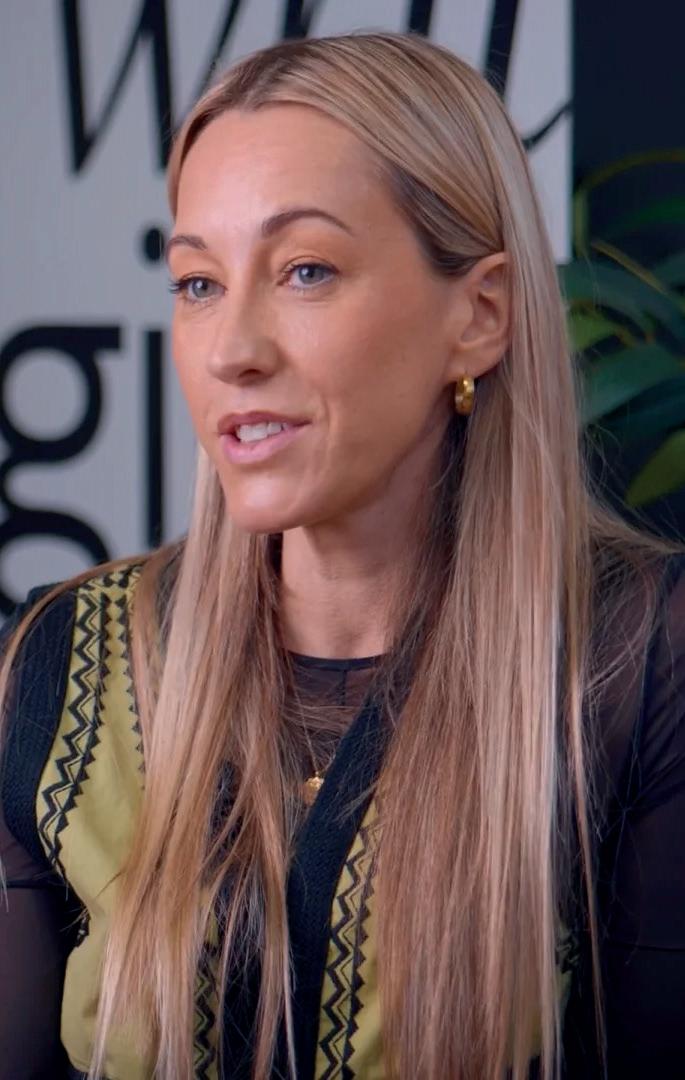
Be Visible: Share your story and expertise through social media or professional forums. Visibility builds credibility and attracts opportunities.
Attend International Events: Both virtual and in-person events are great for expanding your network and staying on top of global trends.
“By taking these steps and staying connected to global communities, women can build a powerful network even in industries where they might feel isolated.”
As a successful entrepreneur, what do you believe are the most important leadership qualities for women who aspire to lead in industries like PR, hospitality, and tech? How do these qualities
“Automation and AI are rapidly shaping both hospitality and tech. In hospitality, we see AI-driven services like chatbots and personalised guest experiences becoming the norm. In tech, AI is transforming everything from operations to customer experience.
“Businesses in both sectors need to prepare by investing in technology and upskilling their teams. However, in hospitality, the human touch will remain crucial. At Queens of Tomorrow, we plan to incorporate in-person events because real-life interactions create lasting connections.”
What are the biggest opportunities you see right now for women who want to break into leadership roles, either in PR or tech? How can platforms like Queens of Tomorrow help women seize these opportunities?
“There are significant opportunities for women, particularly in companies with strong DEI (Diversity, Equity, and Inclusion) initiatives. The rise of remote work and digital platforms has also opened up leadership roles for women globally. Queens of Tomorrow will support women by providing access to mentorship, ongoing education, and a network of likeminded professionals. The platform is designed to help women build confidence and leverage opportunities in both PR and tech.”
Looking ahead, what are your future plans for Queens of Tomorrow? Do you have any upcoming features or new functionality that you’re excited about, and how do you see the platform evolving as you continue to develop the technology?
“Right now, our focus is on refining the app and ensuring a seamless experience for our community. Once that’s in place, we plan to host global events for our members. After a successful launch at Soho House, we’re planning events in Manchester and New York next. This is just the beginning—our goal is to build a platform that empowers women through both technology and real-world connections.”
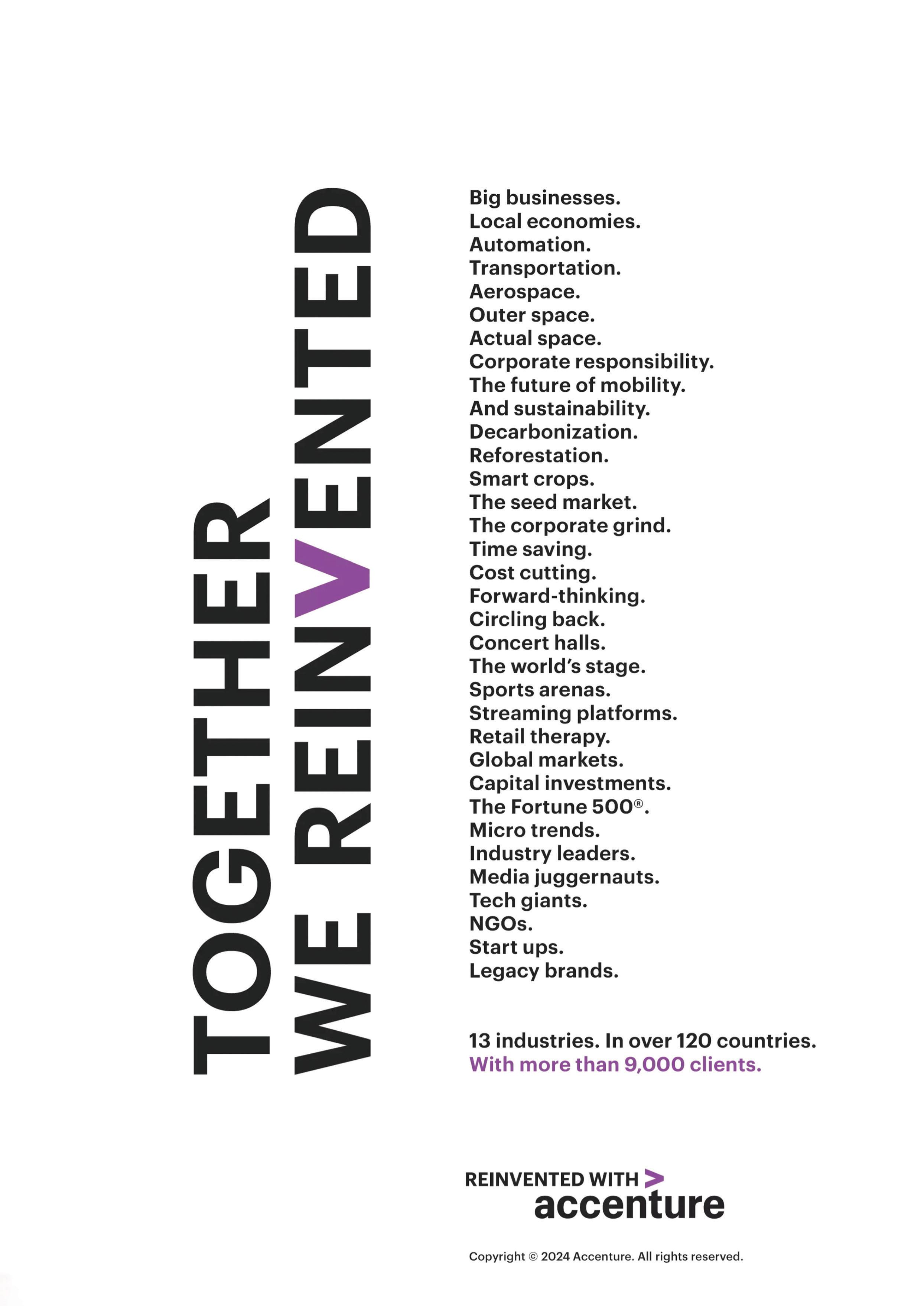

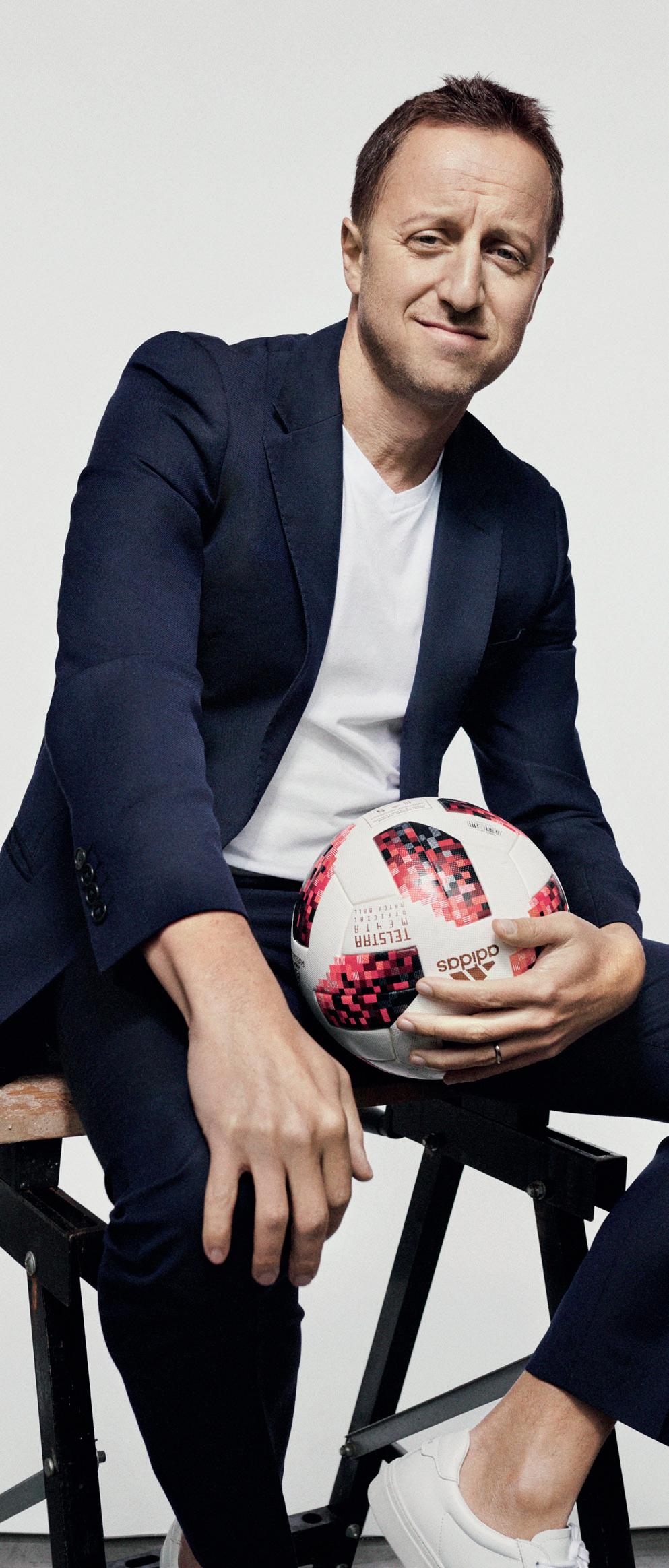
Nelson Mandela famously stated, "Sport has the power to change the world." This sentiment rings truer than ever in today's interconnected and rapidly evolving digital landscape. Beyond its ability to inspire and unite, sport has become a powerful force in shaping culture, driving economic growth, and fostering meaningful connections between brands and consumers.
The unique capacity of sport to transcend differences and create shared experiences is unparalleled. From the Olympic Games to World Cups, we have witnessed countless examples of how sport can unite people across borders, generations, and ideologies. It's a space where pride, hope, and beauty take center stage, making it one of the most potent forces in our global society.
The business of sport thrives on this power to connect people. The global sports sponsorship market is expected to reach nearly $200 billion by 2030, a testament to its enduring appeal and commercial value.
Meanwhile, traditional advertising is losing its effectiveness. Consumers are increasingly finding ads intrusive and irrelevant. This trend is exacerbated by the rise of ad-blocking technologies and the increasing ability of consumers to control their media consumption.
In contrast, sports offer a unique opportunity for brands to genuinely engage with consumers around the things they love. For brands, sport is one of the rare spaces where they can be part of the action without interrupting the experience. By becoming part of the story and adding to the emotion and excitement of sports events, brands can forge deeper and more meaningful connections with fans.
The rise of digital platforms has transformed the way we consume and interact with sports. Platforms like TikTok, YouTube, and Instagram have made sports an all-encompassing part of our daily lives, driving increased engagement with short-form content and highlights. This shift has been a major driver of industry growth, with more than 80% of sports executives expecting further growth in this area.
However, as the space becomes more saturated, brands face a crucial challenge: standing out in a meaningful way. To succeed, they must focus on the emotional and transformative power that sport uniquely offers. It's not enough to simply sponsor an event or an athlete; brands need to engage with the very essence of what makes sport beautiful—the way it unites people, the way it moves them emotionally, and the way it creates lasting moments of shared experience. By integrating themselves into these narratives, brands can create meaningful connections with fans that go beyond traditional advertising. Those that understand this will build stronger, more authentic connections with their audiences.
This issue of The Executive Magazine delves into the multifaceted world of sports business, exploring the latest trends, challenges, and opportunities. We sit down with some of the industry’s biggest stakeholders to delve into areas which will be at the forefront of growth in years to come.
We hope that this collection of articles and exclusive interviews will inspire you to think critically about the future of sports and the innovative ways in which businesses can leverage the power of sports to achieve their goals.


CIO of Aston Martin Aramco Formula One Team
Clare Lansley’s journey to becoming the first female CIO in Formula 1 is nothing short of extraordinary. Now at the helm of Aston Martin Aramco’s technology team, she leads the charge in the sport’s digital transformation, driving innovation and performance in one of the world’s most competitive environments. In this exclusive interview for The Executive Magazine, Clare shares her insights on how cutting-edge technology, AI, and data-driven decisionmaking are shaping the future of F1, while championing diversity and breaking new ground for women in motorsport
AAccording to Clare Lansley, CIO of Aston Martin Aramco Formula One Team, she was destined to work in Formula 1. She says that from a young age, her parents –both avid F1 fans – ‘indoctrinated’ her into the cult of Formula 1. With a passion for the sport already instilled, Clare wanted a business career where she could use the many languages she speaks and travel the world to satisfy her wanderlust. F1 ticked all those boxes – and more. Now leading Aston Martin Aramco’s technology team, Clare has smashed through the glass ceiling of a sport where there are still very few women in senior positions. And she and her team are steering Aston Martin Aramco’s digital transformation in a sport and industry in which data and speed of decision-making are at the very heart of competitive advantage.
As CIO of Aston Martin Aramco, you are leading a critical digital transformation. Could you elaborate on how your role integrates with the overall strategy of the team, and what key initiatives you’ve spearheaded to enhance performance both on and off the track?
“IT’s a critical enabler for making not only the race team but the whole organisation operate successfully. Prior to our current owner’s arrival, it’s fair to say that the technology team had not received the investment it required. But with that now in
place, we’re working on a digital transformation program that is delivering the technology required to drive performance – both at HQ and at track.”
In Formula 1, operational efficiency is key not only on race day but across every function of the organisation. Can you highlight specific examples of how your IT team supports the broader business, such as finance, production, and supply chain management, to maintain seamless operations?
“We’re obviously providing the race team with the telemetry and performance data they need. But, for example, finance need to know at any point in time where we are against the cost cap set by F1’s governing body, the FIA. For production, we need to be able to understand not just how long a component may need for tooling, but whether any machines are offline so we can balance the workload of other machines to make sure that components are available and will get to the track in time.”
How does your team prepare for the intense schedule of 24 races a year, and how do you ensure that the necessary telemetry and performance data are delivered on time for each race, regardless of location or conditions?
“Everything is incredibly time-boxed. We have 24 races this year. Each one is in a different location around the world, all of them with their own unique set of requirements. That might be altitude or climate, a street circuit or a smooth racetrack. And each of those different factors determines what’s called the race pack for the car. So, for every single race you are effectively running
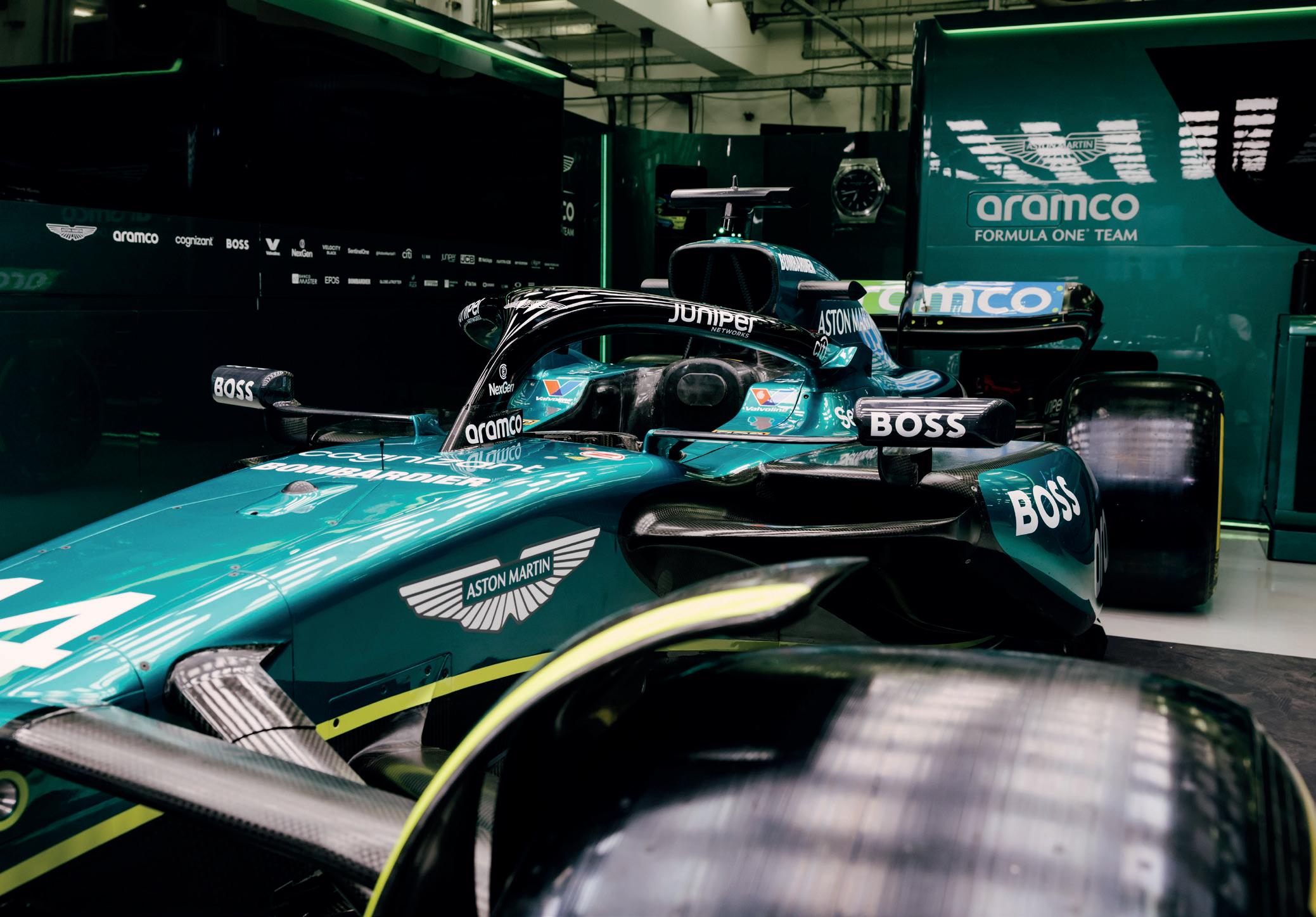
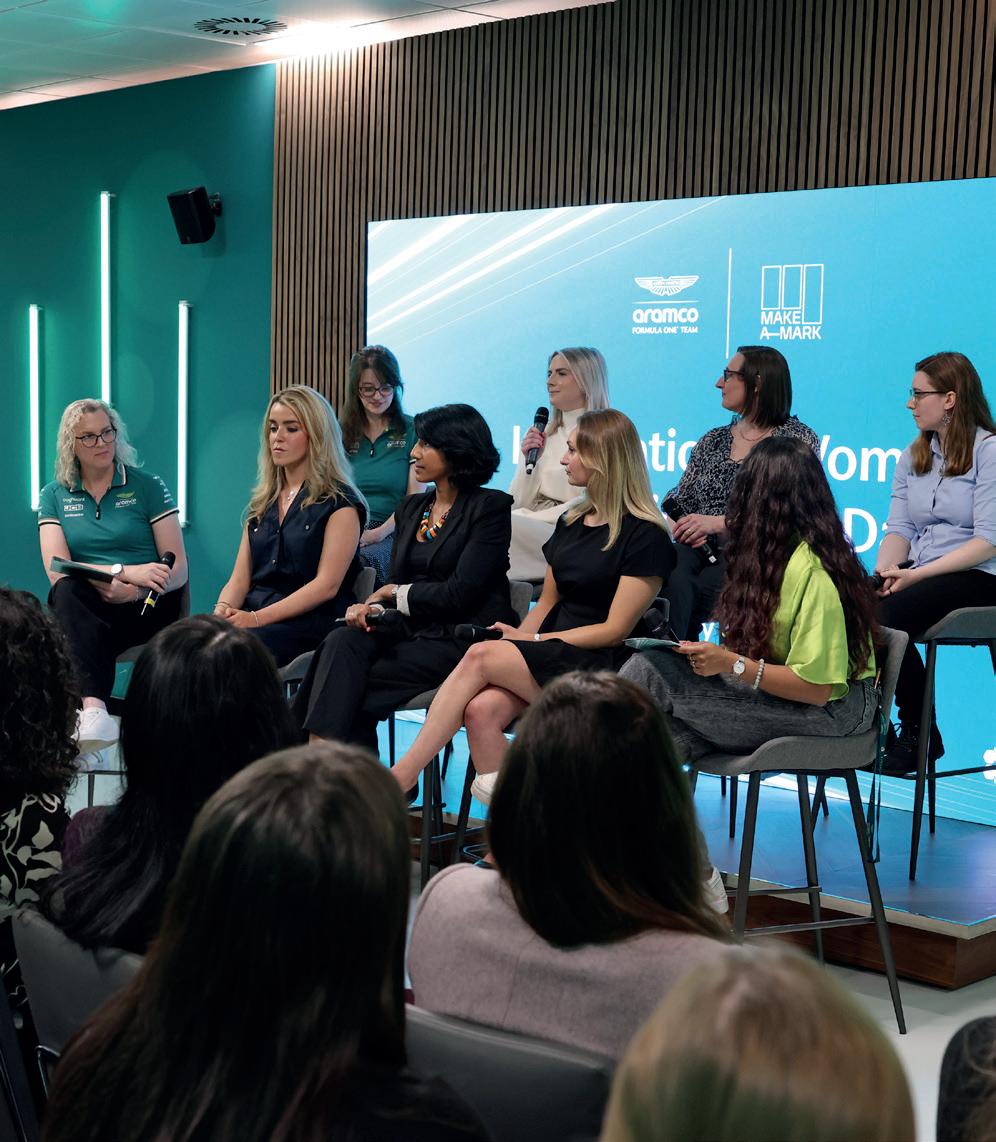
a unique product. That means we’re constantly going to market with a new product, sometimes back to back in three weeks, which is intense!
“Performance is at the heart of that need for speed. Engineers, as you might expect, always need the information now. But more generally, as new technologies or new demands from the business arise, we need to be able to act fast. To get that competitive edge, speed of adoption is the name of the game.”
As the first female CIO in Formula 1, you’ve broken significant barriers in a traditionally male-dominated industry. From your perspective, have you observed a tangible shift in gender diversity within the sport, and what are some of the most impactful initiatives you believe could further attract and retain talented women in F1 and STEM roles?
“Well as the first CIO in Formula 1, that’s one glass ceiling broken! And when I started with Aston, there were two women in IT and now there are ten, so that’s positive.
“And at Aston, we do a lot of engagement with female groups, whether that’s students and school pupils or people who have completed their degrees. We’re actively trying to give women opportunities to come in and see what life is like. I currently have two women doing 12-month placements with me, and we make use of internships and apprenticeships.
“We also subtly changed the way that we advertise our roles, and that’s making a difference, too. Women typically will not apply for a position unless they tick every box. So we changed how our job ads read to say that a particular quality is desirable but not essential. I’m much more interested in how well someone will fit with our dynamic. If there’s a specific skill that’s missing, we can teach that.”
How do you foster a culture of upskilling and cross-training
within your IT team to ensure that no single point of failure exists, and how do you encourage your team to embrace flexibility in their roles?
“Above all I need a team that’s multi-skilled and able to switch to cover different roles as required. I can’t afford to have a single point of failure because a specialist is, for some reason, not available. So we really push upskilling for everyone to make sure that we always have the capabilities and expertise we need on hand, where and when we need them.”
You’ve been leading the digital transformation at Aston Martin Aramco for over two years now. Could you walk us through the key milestones you’ve achieved in that time, and share some of the most significant challenges you’ve encountered in laying the foundations for a fully optimised, tech-driven organisation?
“We started with a back-to-basics program that we put in place to make sure that the fundamentals of system stability, reliability, security and so on were in place. And security is of course absolutely paramount for us, as we are a real target. We needed those foundations in place before we could then go on to deploy the tech that will allow us to optimise and automate a lot of the standard roles and repeatable tasks. With that done, the team now has the capacity to truly transform and push forward.
“We operate a hybrid estate and we’ve been upgrading our core platforms, including ERP and PLM stack. The current focus is on optimisation.”
What processes have you put in place to ensure that data flows seamlessly throughout the organisation, and how do you maintain trust in the data so that teams can make informed, real-time decisions with full confidence?
“For me, it’s all about how we can get the data where it needs to be, really efficiently. One, perhaps the, crucial factor for F1 is the speed at which you’re able to make decisions. And if you have lots of offline copies of data, you’re burning valuable time trying to figure out which is the master. So, to eliminate that inefficiency, you have to get all users to trust the data.
“To that end, we’re building our data lake which is a limitless repository of all data in all formats, structured and unstructured, so that we can properly mine one source of data for the analytics that are needed by different teams.”
Strategic partnerships with technology providers are crucial in F1, where every second counts. Can you give us a few examples of how collaborations with partners have transformed key operations, such as employee onboarding or data management, and contributed to a sharper competitive edge for the team?
“A good example is ServiceNow. It’s helping us to drive the productivity of our end users, for example making our onboarding process much slicker and faster with automated workflows that make sure people have got access to the right tech from day one. So someone joins us on a Monday at 9am, they have their induction and by 10am they’re on the tools and adding value to the team.”
AI is revolutionising industries across the board, and F1 is no exception. How has Aston Martin Aramco embraced AI so far, particularly in areas like real-time race data analysis
or simulations, and where do you see AI creating the most significant performance gains for your team in the future?
“We’re already using AI for real-time data analysis. Algorithms provide insights throughout a race, including the car’s performance, tyre degradation and so on that help the team make informed decisions about pit-stop strategy and car settings.
“We have more than 250 sensors on each car, generating millions of data points per car, per race. All that gets streamed back live to the garage and more or less immediately to our HQ in Silverstone so the team can analyse and make suggestions for optimisation of performance. That’s a serious amount of data that has to be tagged and analysed. And, of course, we also archive the data so that we can do the analysis for the next time that we race at that circuit, so we can look at how the car performed and bank the learnings.
“But the real-time data is crucial to help us deal with unexpected events. That’s the fun thing with F1; something will happen and your ability to react at speed is critical. You’ll have a race plan, but need to adapt on the fly with real-time analysis.”
While AI and data-driven technologies are advancing rapidly, Formula 1 still relies heavily on human intuition and decision-making. How do you foresee the relationship between AI-generated insights and human judgment evolving in the sport, and in what areas do you believe AI will enhance human decisionmaking without replacing it?
“Generally speaking, AI is a big shift for F1. It’s a powerful tool that simplifies vast amounts of complex information which makes back-end processes much more efficient. And if you can process those huge amounts of data more rapidly, you’ll get a recommendation faster than ever before. But at the end of the day, you still need a human to make the decision to ratify making a change.
positive they will be actively monitoring the use of AI going forward.”
Sustainability is becoming increasingly important across industries, and Formula 1 is no different. How is your team addressing the environmental impact of high-performance computing and storage, and what are some of the innovative steps Aston Martin Aramco is taking to reduce its carbon footprint, especially in such an energy-intensive field?
“For example, the high-performance compute that we use has very strict limitations. The FIA mandate the amount of power that can be used for simulations, which restricts the type of chip sets and clock speed which can be used. Furthermore the Team’s position in the championship dictates how many simulations can be run. Furthermore, you can be audited at any time at short notice. You have to keep two years of hot data available so that auditors can take a look at any simulation that took place in that period. It’s not just the engineers in the garage being scrutinised. On the technology side, we too have to open our doors and provide whatever information is required.”
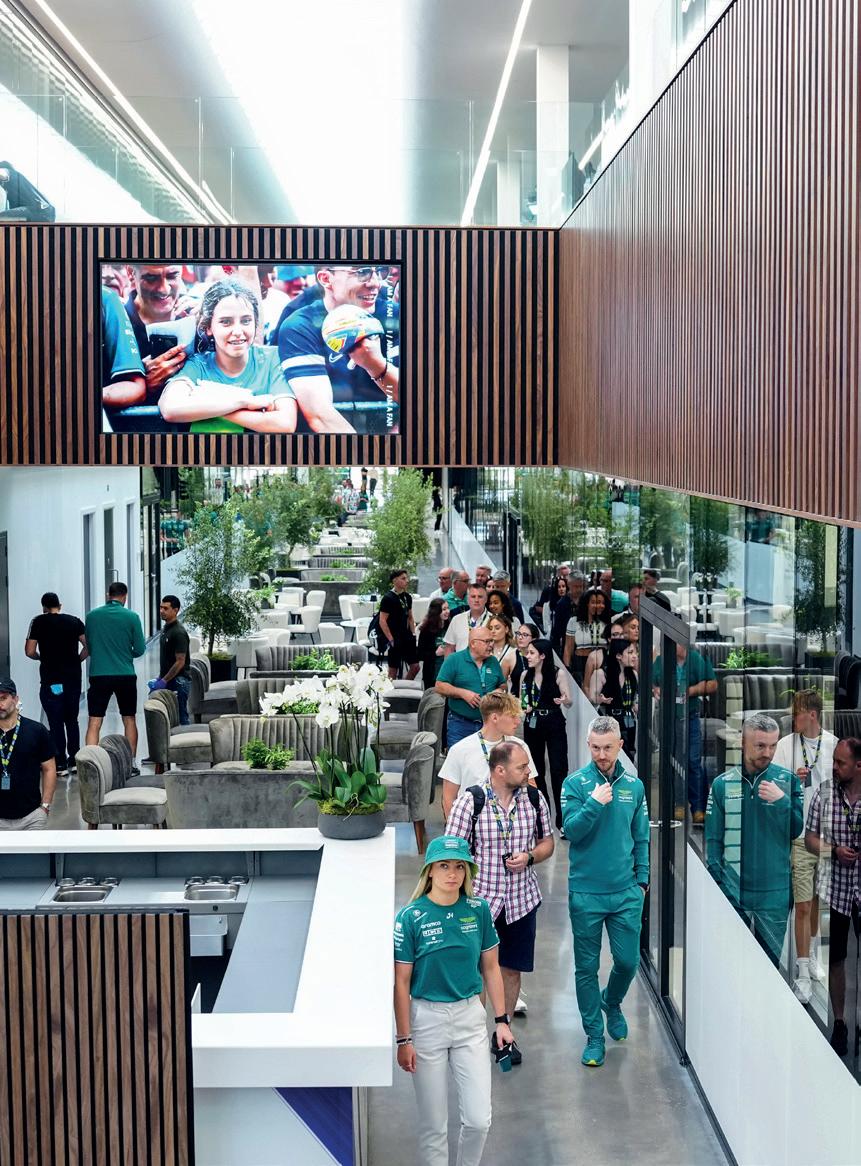
“We also use AI in simulations so that we see what a change of design would look like, particularly on the aerodynamics. And with aero accounting for 60% of the performance of the car, clearly we want to ensure that it’s optimal. We also use AI in generative design for manufacturing components that need to fit a specific size or shape and be the right weight.
“At the end of the day, you still have a human operating the car, and that’s not going to change. It could be that AI will improve how we can predict mechanical failures so we can take pre-emptive action. But you’re not going to influence the drivers’ performance and their response to something unexpected that happens on the track.
“But AI will have a significant impact generally. The FIA actively defines parameters for certain elements of technology, and I’m
Formula 1 operates under stringent technological regulations set by the FIA, which limit power consumption and other computational aspects. How does your team navigate these constraints, while still pushing the boundaries of innovation and ensuring that Aston Martin Aramco remains at the forefront of technological advancements?
“Our new purpose-built HQ at Silverstone was designed and built with sustainability at its centre. We have photovoltaics on the roof that generate 6% of the operation’s energy consumption. After heating and lighting, compute and storage are the biggest consumers of electricity, so we’re very conscious of the need to reduce that demand as much as possible and are actively doing so.
“We ensure that the products we use are TCO-certified [a sustainability standard for the technology industry] and our supplier engagement processes include a sustainability evaluation element, to reduce our scope 3 footprint.”
There’s been growing momentum around diversity and inclusion in motorsport, particularly in female representation. With increased visibility of female motorsport, do you believe we are getting closer to seeing a female driver on the F1 grid, and what more can be done across the industry to cultivate a truly inclusive and diverse talent pipeline?
“Female motorsport is getting much more coverage, which is great. But we need to keep pushing on this. It’s up to us all as a community and a culture to keep knocking on that door. After all, talent has no gender.”
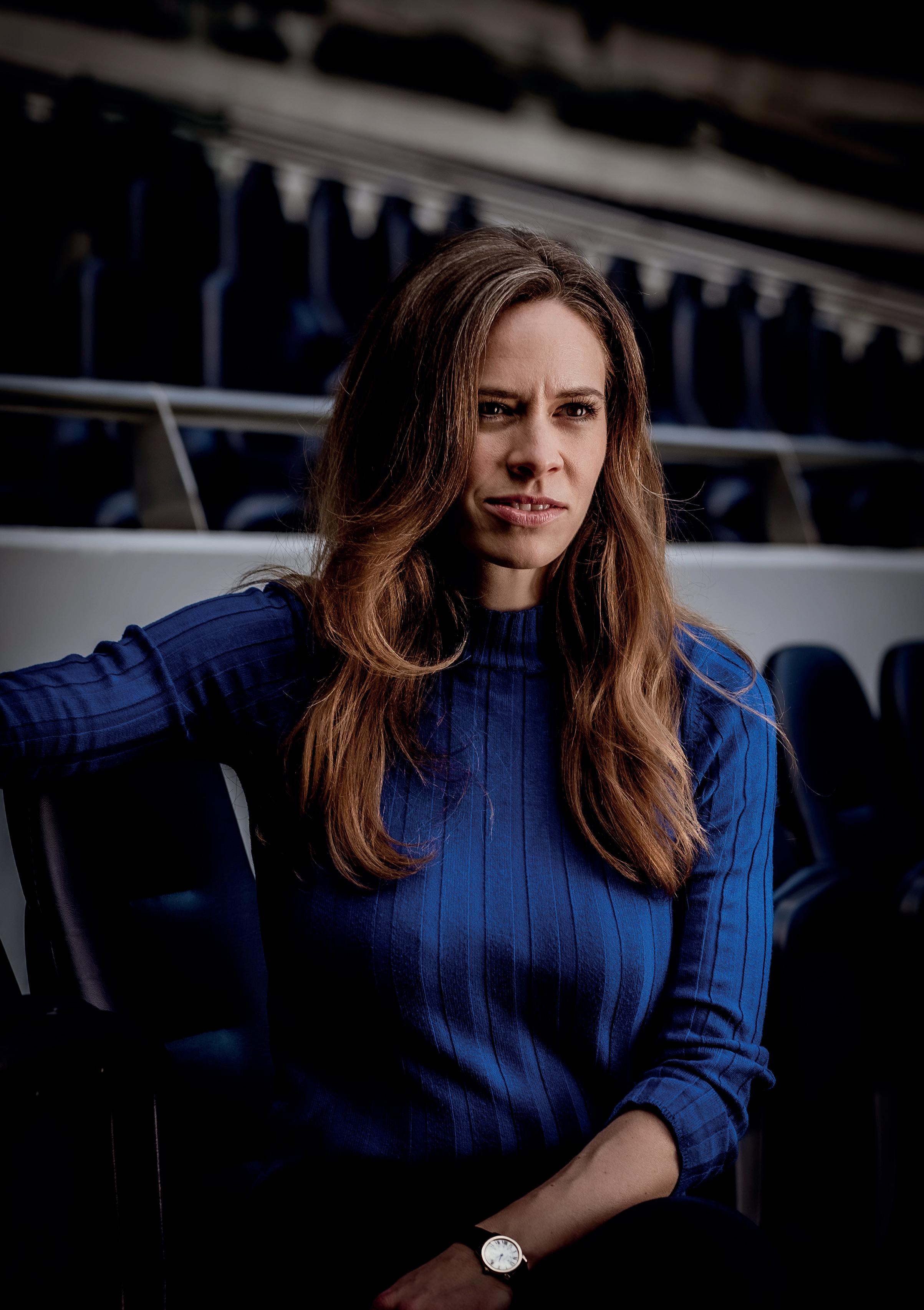
Kate Mason has swiftly emerged as a leading voice in sports journalism, carving out a remarkable career with top media organisations. In an exclusive interview with The Executive Magazine, Kate shares the pivotal moments that fuelled her rise, the challenges she overcame as a woman in a male-dominated industry, and her forward-looking vision for sports media
IIn the ever-evolving landscape of sports journalism, few voices have risen to prominence as swiftly and distinctly as Kate Mason’s. With an impressive career that spans some of the world’s most prestigious media outlets, including Sky Sports News and beIN Sports, the TNT Sports and Eurosport presenter has become a respected figure in a traditionally male-dominated industry.
Your journey in sports journalism is both inspiring and impressive. What key moments in your career do you believe were pivotal in shaping your path to becoming a prominent sports presenter and journalist?
“I think I would talk about two or three pivotal moments in my career. The first has to be London 2012, where I realised it was possible for female broadcasters to lead coverage for massive sporting events. The joy and energy conveyed by people like Clare Balding, who wasn’t an athlete but had a similar educational background to me, really resonated. Seeing her and other women at the forefront of that coverage made me feel like I had to pursue this path.
“To go back a bit, my initial plan was to get into sports journalism after university. I graduated in 2010, and my goal was simply to get to London, where there were more opportunities in this space. Like Dick Whittington, I thought, “I just need to get to London.” I ended up taking a job at a tech company, which wasn’t related to sports at all, but it allowed me to support myself and be in a city with access to big media organisations. I knew if I could just find a way in, I could make it happen.
“Seeing the coverage of London 2012, I realised how much I wanted to be a part of it. It was tough working a full-time job while juggling other commitments, but it really set me on my path. It also made me realise how difficult it is to earn money in the early stages of a media career, which limits who can succeed in this space. I’d like to help build a way to change that because I think it’s limiting talent. In my case, I found a way around it by working a full-time job while taking on internships and meeting people in the industry, but it was exhausting.
Sports journalism, like many sectors, is continually evolving. How do you see the role of a sports journalist changing in the next decade, and what innovations do you believe will drive this transformation?
“The role of a sports journalist has changed dramatically over the past decade. Nowadays, everyone is either a written journalist or has to be a multimedia journalist. I’ve always focused on the broadcasting side, which is a slightly different form of sports media. Broadcasting is often about entertainment and how you communicate with your audience about what they’re watching.
“I’ve come to see that the way sport is being streamed now allows it to reach so many people in very specific niches. For example, if you’re a cycling fan, you can subscribe to Eurosport, where I work, and watch all the races. You can focus solely on what you’re passionate about. One of my first jobs was commentating on Squash TV, which also caters to a specific audience—if squash is what you want to watch, you can subscribe just to that.
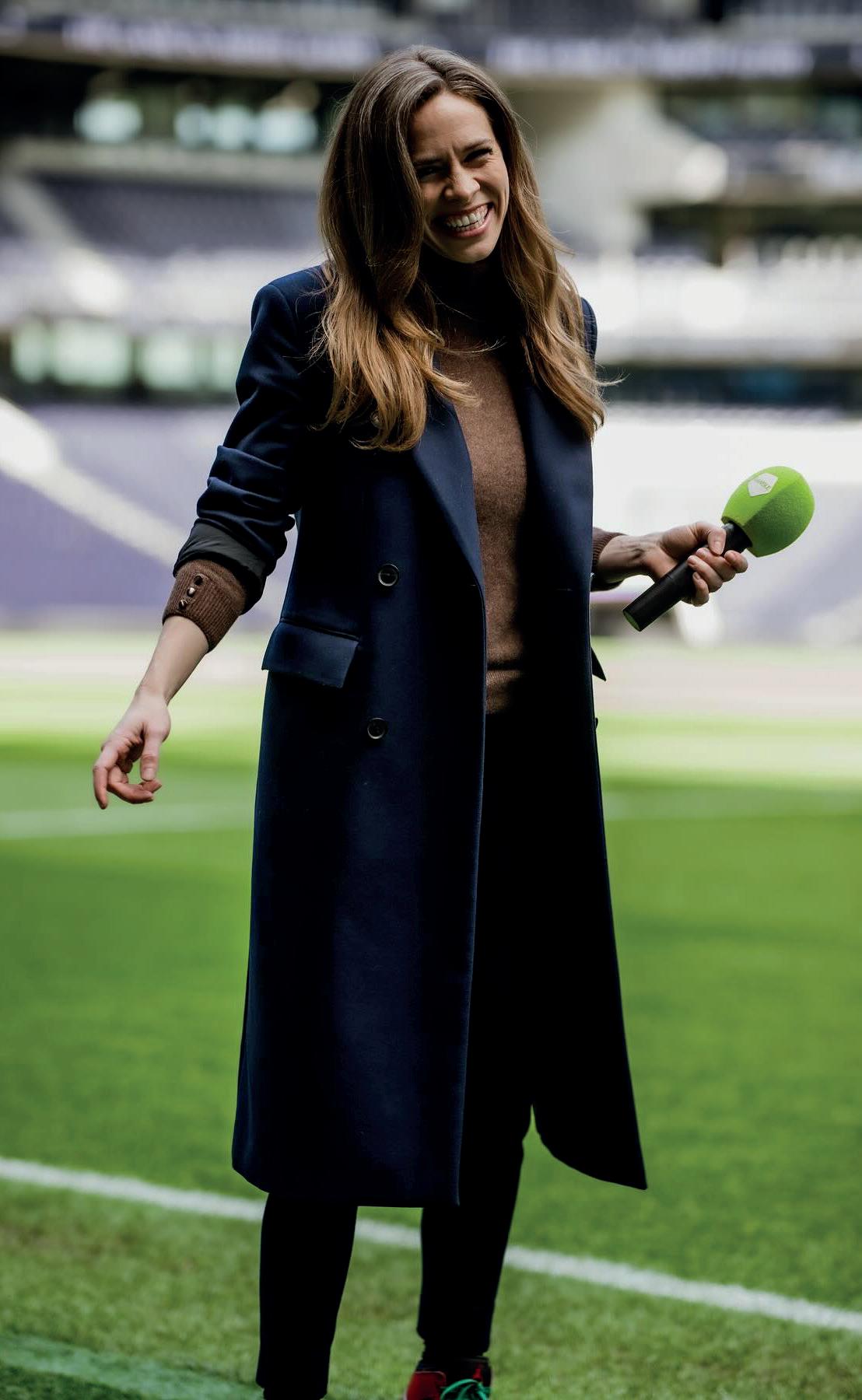
“Eventually, I landed a job in Qatar with BeIN Sports, where I learned a lot and got plenty of on-air experience. This was crucial for developing my skills as a broadcaster. I also learned a lot about the planning of the World Cup and the differences between local culture and the culture in the UK, which was very instructive. After two years there, I made a documentary about Qatar in the run-up to the World Cup, which won an award. That’s really special to me because it’s something no one can take away—proof that I’ve accomplished something meaningful in my career.”
“Looking at the future, I think this increasing specificity of sports fans is going to be fascinating, particularly in how people choose to access content. How streaming develops and how major companies adapt to these changes will be interesting to watch. And of course, there’s AI. Some people say they can create an avatar of me right now and send that instead of me going to work. That’s a bit scary.
You’ve worked with some of the most prestigious media organisations in the world, including Sky Sports News and beIN Sports. What strategies have you employed to navigate and thrive in such competitive environments?
“Prestigious media organisations are definitely competitive environments. I’m naturally a very competitive person—maybe it’s because I’m an only child and always wanted to win. I’ve always been passionate about sports. When I was little, I wanted to play football and cricket, and later I got into triathlons. Ultimately, I found my passion in squash and played quite seriously until I was about 20. So, those competitive aspects of my nature are definitely there.
“However, I don’t think being competitive in the workplace is necessarily the best strategy. In fact, I believe that trying to compete with everyone around you isn’t the most effective way to succeed. Personally, I’ve found that getting to know everyone and being friendly with colleagues is the best way to navigate these environments. In TV, there’s often a very hierarchical structure, which can be helpful because everyone knows their role. But it also means that every single job, no matter how small, is crucial to keeping everything running smoothly. If even one person isn’t performing their role to the best of their ability, the whole operation can fall apart.

“I’m sure this is true in other organisations as well, but I’ve seen it firsthand in the media industry. I think the best strategy is to be curious about all the different roles, many of which I’ve done myself, from being a runner all the way up. It’s important to be respectful of the different talents that people bring, even if they’re very different from the skills of those on screen. Often, the behind-the-scenes work—whether it’s storytelling, formatting, or asking questions—is vastly significant and, in many ways, more important than what’s done by what we call “the talent,” even though that term isn’t my favourite.”
The sports media industry is traditionally male-dominated. Can you share some of the unique challenges you’ve faced as a female journalist in this field, and how you have successfully overcome them?
“You are very very right. As my career progressed, I noticed the environments I worked in became more equal, with more women in the room. This was especially true at the Olympics, where there was often a pretty even split between men and women and a really diverse range of people. I personally think this is the best scenario because when you have a 50/50 balance of men and women, and a range of backgrounds that reflects what you’d find naturally in, say, the UK, it creates a more inclusive environment. It means that people who might typically be in the minority, like women in sports, are better represented. They aren’t just seen as a token or the sole representative of their demographic.
“Later in life, in particular, I found so much joy in sports, and I wanted to share that. Given my passion, I feel a responsibility to advocate for female-specific stories and other important issues related to women in sports. However, it can be tough when you’re the only woman in the room because it feels like you’re constantly fighting for these issues alone.
“To address this, I’ve used a strategy in editorial meetings where I teamed up with a colleague who was also a friend. He was from an ethnic minority, which made him aware of what it feels like to be underrepresented, but you don’t necessarily need to be in a minority for this to work. He and I would support each other by pushing for the other’s perspective. For example, I’d bring up
issues related to race or be mindful of them in discussions, and he’d do the same for issues related to women. Sometimes we’d plan this in advance, but often we just stayed aware of these perspectives to ensure they were covered. This approach helped us create a more inclusive and comprehensive dialogue.”
Female leadership in sports journalism is on the rise, but there is still much progress to be made. What opportunities do you see for women in this sector, and what can organisations do to better support and promote female talent?
“You’re right; female leadership is on the rise, which is fantastic. However, as I mentioned earlier, I believe it would be better if there was more balance. Specifically, in sports media, I still don’t see many women in leadership positions, such as heads of sports media organisations or sports editors. It’s not something I come across often.
“Last year, I attended a meeting with someone in a significant position whom I wanted to work with. After the meeting, I realised that it was the first time in my career that I had pitched myself as a presenting option to a female leader. It struck me as odd because, even though I’ve worked in other industries before, like tech, I had never experienced that in sports. How crazy is that?
“I’ve noticed that many older women who have been in the sports media industry for years have had to adapt to fit into a predominantly male environment. As a result, they often don’t stand out as leaders because they’ve had to be careful not to draw too much attention to themselves—simply because they already stand out for being female.
“It’s a classic scenario where people don’t necessarily consider those who are different from the traditional leaders as potential leaders themselves. There’s a lot of research showing that empathy and understanding employees’ emotions are critical leadership skills. While I’m not saying only women possess these traits, they have traditionally been more associated with women or valued in women.
“I think there needs to be a broader understanding of what


leadership can look like. Also, it’s important to support women in this space to help them have the confidence that their ideas and their presence are valued.”
Your career has spanned various sports and media formats. How do you approach understanding and engaging with different sports cultures and audiences, and what insights have you gained about the intersection of sport and culture?
“It’s so interesting to explore different sports communities, cultures, and audiences. As a sports fan myself, I know that while these communities can appear diverse, at their core, they often share similar characteristics. Sports fans tend to be deeply passionate about one particular sport and are sometimes reluctant to follow others. They might even find reasons to argue why a sport similar to theirs is completely different from the one they support. For example, football and rugby fans often dismiss each other’s sports as not worth following.
“Personally, I really enjoy the sociological analysis of these communities. It’s fascinating to see how people exist within these spaces and to be able to join in on that experience, even as a broadcaster. While you’re not necessarily trying to be a fan when broadcasting a sport, you’re aiming to channel the enthusiasm of the fans, express compelling narratives, and highlight the most interesting stories.
“That’s how I approach every sport I work on. I truly believe that the connection between sport and culture is significant because sport is culture. For instance, “Swifties” are very similar to Tottenham Hotspur fans in their passion and dedication. It’s interesting how society and literature sometimes don’t value sports fans, especially football fans, in the same way they do
connoisseurs of other cultures. Yet, there are more similarities across these dimensions than one might expect.”
Looking ahead, what future projects or roles are you most excited about, and how do you envision your career evolving over the next few years?
“Having recently returned from the Olympics, I am most excited about working on the Winter Olympics, which is a couple of years away. That’s something I’m really looking forward to. What I loved about these Summer Olympics was how so many different sports and their fans coexisted and brought out the best in each other. I just love being around athletes and people who are at the pinnacle of their careers, peaking for those really special moments. It’s one of the most special experiences of my life—working at Paris 2024.
“The Women’s Ashes are coming up on TNT at the start of next year, and just thinking about presenting an Ashes series gives me shivers! There’s also the potential for covering the Men’s Ashes, although these opportunities depend on who has the broadcasting rights. Hopefully, that’s on the horizon. I’d also like to get back into football. I worked in it a lot at Sky and was part of a big independent football podcast. The challenge, of course, is that focusing on one sport can mean being away a lot, so you can’t just jump in and out of different sports very quickly.”
Finally, for business executives and aspiring leaders reading this, what qualities do you believe are essential to becoming a successful and respected leader in the competitive world of sports journalism?
“At the risk of sounding like an HR pamphlet, I would say that passion for sport is important, but so is passion for sports journalism, the history, and the culture—the heritage, if you like—of what sports media has looked like. It’s also crucial to have curiosity and an innovative mindset about where it’s going because there are some really quality things happening in this space. Sometimes, the focus on clicks and trying to find the next big thing can almost limit the focus on the real bread-and-butter elements of what makes the sports media industry great in this country and around the world. That’s knowing how to tell a story, how to get the facts, and how to excite people at home, regardless of the medium— whether it’s TV, TikTok, or wherever.
“Wherever people want to find the sport, they will, and if you can connect with them with enthusiasm and love, and if you treat the people you work with—or those who work for you, if you’re in a leadership role—with respect for their skills, they will support you. They will be excited to work on whatever you’re passionate about because this industry is made up of people who didn’t get involved in it to become multimillionaires or to make their friends jealous. They’re here because they think it’s amazing that they get to talk about, work on, film, and communicate moments like a 100-meter final at the Olympics, the Champions League final, or even Reading against QPR on a cold Saturday in October.
“That’s the thing to remember, even though a lot of the challenges in the industry are about how you can get as many eyeballs as possible on what you’re doing. Some of that focus isn’t really real; it’s apart from the human core of what we’re doing. I think it’s about valuing the work that people put in and the connections they’re trying to make to make people really love the sports and stories they’re working on. That is what it’s all about, and in fact, that’s what life is all about.”
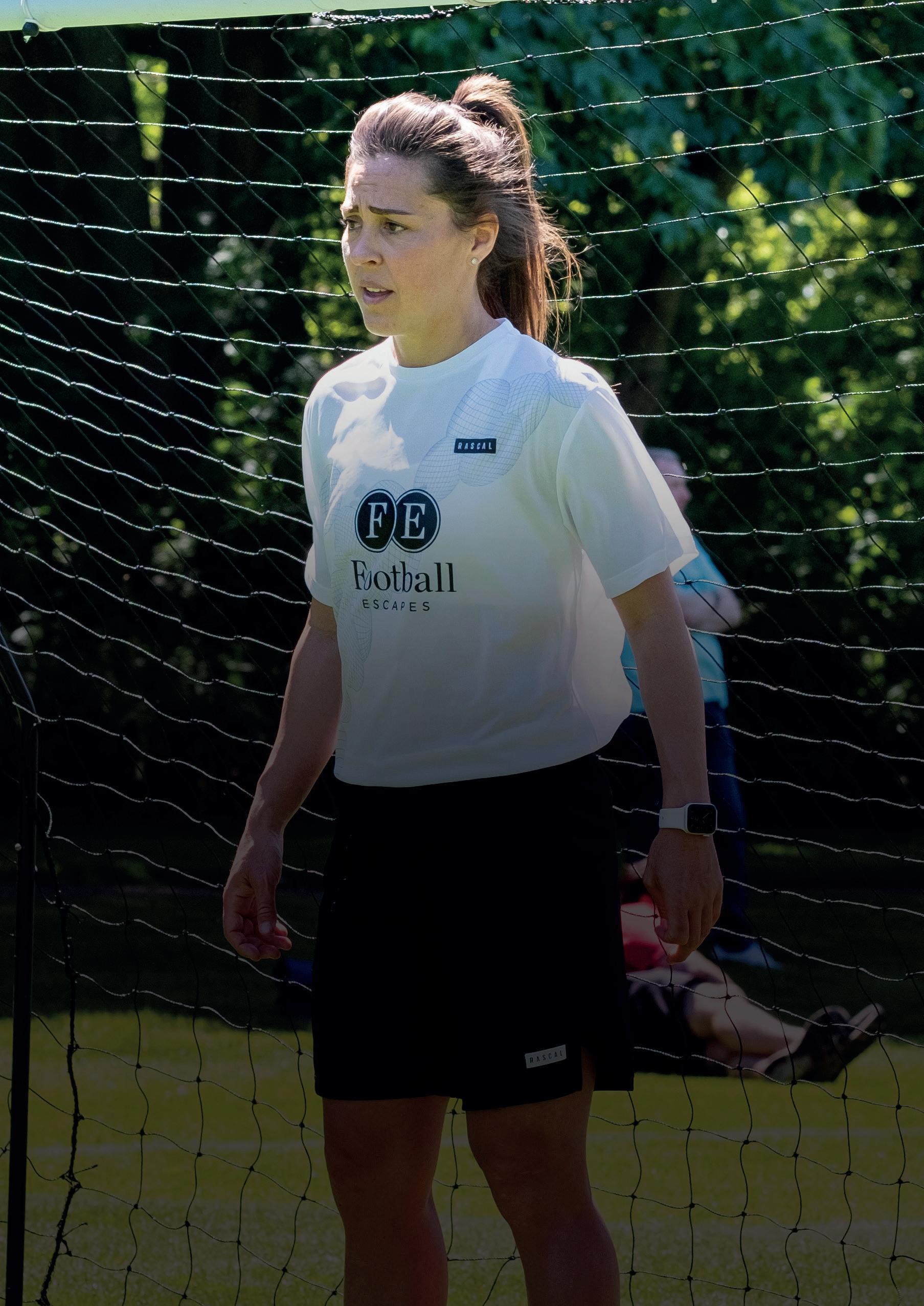
In this exclusive interview with The Executive Magazine, Fara Williams, England’s most-capped footballer, discusses her inspiring journey from grassroots to greatness. She highlights her role in the Football Escapes program with Ikos Resorts, reflecting on how it helps nurture young talent while sharing valuable life lessons
FFrom grassroots beginnings to becoming England’s most-capped footballer, Fara Williams’ journey is one of resilience, leadership, and unwavering passion. In this exclusive interview with The Executive Magazine, Williams opens up about pivotal career moments, overcoming personal challenges, mentoring the next generation, and her vision for the future of women’s football. More than just a football legend, Williams shares the life lessons that have shaped her both on and off the pitch, inspiring a new era of athletes and leaders. Now, advocating the exciting Football Escapes programme at Ikos Resorts, Williams is demonstrating her business prowess whilst still enjoying the game.
Your journey from grassroots football to becoming England’s most-capped player is nothing short of remarkable. Can you walk us through some of the pivotal moments in your career that shaped you as both a player and a leader, and how you’ve applied these lessons beyond the pitch?
“The journey was never straightforward, and honestly, that’s what made it so special. Starting out in grassroots football, I didn’t have the easiest path, but I think that’s what helped shape my resilience. A major moment was earning my first cap for England. It made me realise the impact of hard work. Then, winning the FA Cup with Everton in 2010, it was a reminder that perseverance pays off, no matter how long the wait. Off the pitch, these experiences have taught me the value of teamwork, patience, and always staying grounded, which is something I try to pass on to the next generation.”
Football is a demanding sport, both physically and mentally. What have been some of the toughest personal and professional challenges you’ve faced over your 20-year career, and how did you develop the resilience to overcome them?
“There were moments I felt like giving up, but football was my escape. Professionally, injuries were hard, especially when they happen just as you’re finding form. The key for me was never allowing myself to feel defeated for too long. Resilience comes from understanding that setbacks are part of the journey, and if you keep pushing, you’ll come out the other side stronger.”
You’ve transitioned from playing at the highest levels to now coaching young players as part of the Football Escapes program with Ikos Resorts. How do you approach mentoring the next generation, and what qualities are most critical for young athletes to develop, not just as footballers, but as individuals preparing for life beyond the sport?
“For me, mentoring is about helping kids find their own love for the game and making sure they feel supported both on and off the pitch. I focus on nurturing qualities like self-discipline, resilience, and respect for others. Football is great for building character, but I also remind them that there’s life beyond the sport, and developing a well-rounded personality is just as important as any technical skill.”
In today’s business world, diversity and inclusion are major themes, yet you’ve spent your career excelling in an industry

still heavily dominated by men. What unique challenges have you faced as a woman in football, and what strategies have helped you succeed in an environment where you were often in the minority?
“There were definitely moments when being a woman in football felt isolating. You always feel like you have to prove yourself that little bit more, and sometimes it’s hard to be taken seriously. But I’ve always believed that letting my performance speak for itself is the best way to break down barriers. Surrounding myself with supportive teammates and coaches also made a big difference, as did being vocal about the need for more visibility and support for women’s football.”
The partnership between Ikos Resorts and Football Escapes gives young players the chance to train with legends like yourself. From a personal development perspective, what kind of impact do you believe this immersive experience has on these children, and how do you think sports can shape their futures both on and off the pitch?
“The impact is huge, not just in terms of football but in building confidence and learning how to work within a team. They’re learning discipline and how to push themselves, but they’re also creating memories that will stick with them for life. Football teaches you resilience, and even if these kids don’t go on to become professional players, they’ll take those lessons with them into whatever they do next.”

As someone who has played for some of the top football clubs and represented Great Britain at the Olympics, how have you balanced the pressures of high-level competition with maintaining your personal brand and pursuing new opportunities, such as your involvement with Ikos Resorts?
“It’s all about staying true to who you are. I’ve never been someone who chased fame or recognition, and I think that’s helped keep me grounded. My involvement with Ikos Resorts and Football Escapes feels like a natural extension of my love for the game, and it’s a way to give back. Balancing these things comes down to remembering why you started in the first place—it’s always been about the love of football for me.”
Your career has spanned periods of significant change in the visibility and popularity of women’s football. What shifts have you seen in the business of women’s sports over the last two decades, and what further changes would you like to see in terms of investment and support for female athletes?
“The biggest change has been the increased visibility of the women’s game. When I started, we weren’t on TV, and now we’ve got sold-out stadiums for major tournaments. But there’s still a long way to go, especially in terms of investment and facilities. I’d love to see more funding for grassroots women’s football so that the next generation has even more opportunities than we did. More sponsorships, better pay, and increased media coverage are still needed.”
The concept of “leadership” in football extends beyond the captain’s armband. In your role as a coach and ambassador, how do you view your responsibility to inspire the next generation of athletes, particularly young girls who may not see as many role models in the sport?
“Leadership, for me, is about setting an example through your actions. It’s not just about giving orders on the pitch but being someone others can look up to. I take that responsibility seriously, especially when it comes to young girls. I want them to see that there is a place for them in football, and that they can succeed, no matter the obstacles. It’s important to be visible and to show them that their dreams are achievable.”
Football Escapes and similar programs provide young players with more than just technical training; they also offer life skills. What role do you see these programs playing in developing young leaders, and how can they apply what they learn on the field to their everyday lives, especially in a highly competitive world?
“Football teaches you about teamwork, discipline, and the importance of hard work—qualities that are valuable in any walk of life. These programs help kids learn how to handle both wins and losses with grace, and that’s an important lesson for the real world. The ability to stay focused, keep pushing even when things aren’t going your way, and working well with others are all things that will serve them well, whether in football or whatever path they choose.”
You were appointed a Member of the Order of the British Empire (MBE) for your services to football and charity. How has your charitable work influenced your perspective on leadership, and what advice would you give to business executives about using their platforms to create positive change?
“Receiving the MBE was an honour, but it’s always been about giving back. My experiences have taught me that leadership isn’t just about being in charge—it’s about using your position to help others. For business executives, I’d say it’s important to remember that you have a platform, and with that comes responsibility. Whether it’s through charity work or creating opportunities for others, making a positive impact should always be a priority.”

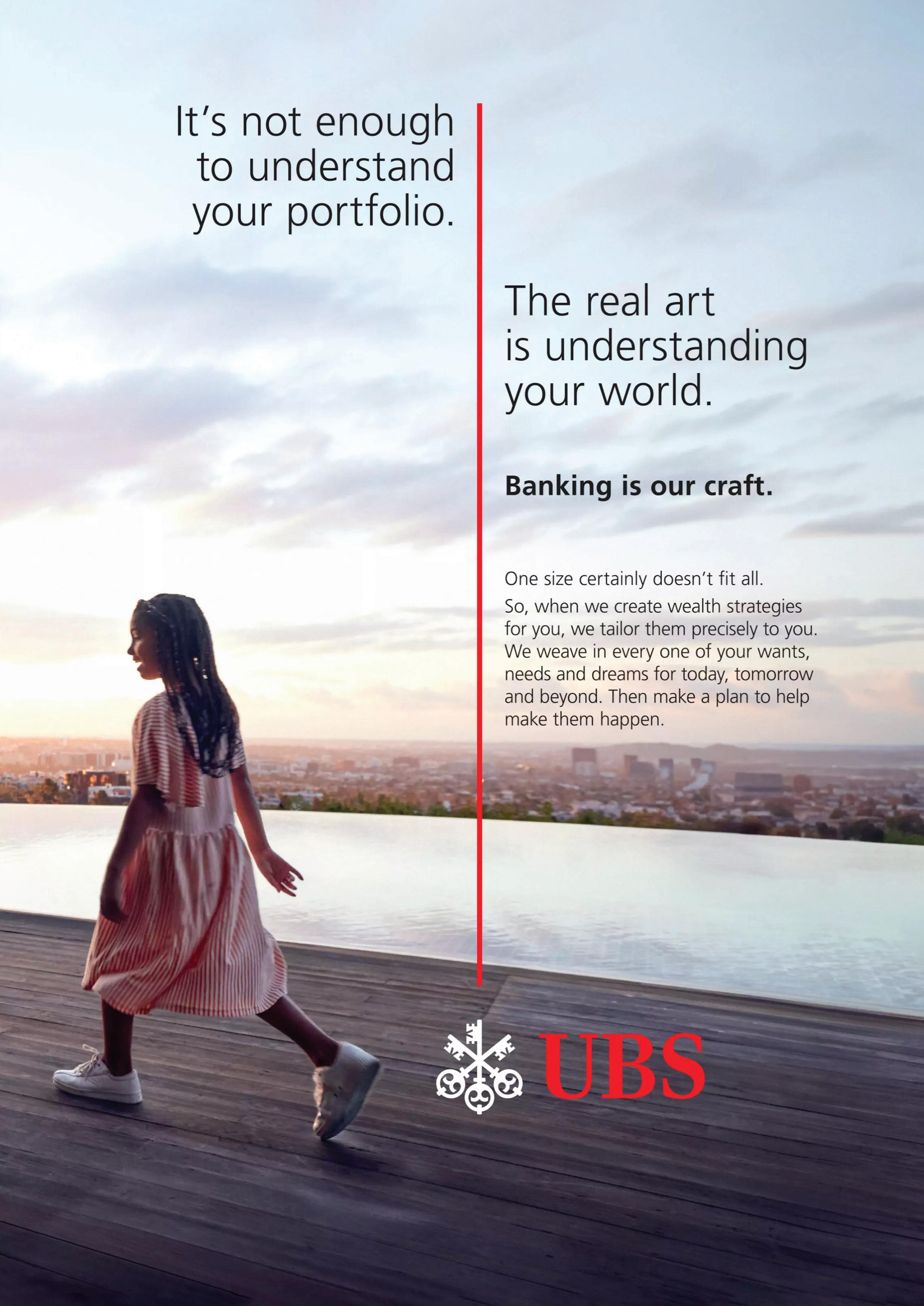

As the curtain falls on another season of high-profile sports, a new race begins—not on the field, but in the boardroom. Global companies are increasingly vying to recruit former athletes, recognising the extraordinary skills honed through years of competition that translate seamlessly into corporate success. These professionals bring unmatched resilience, teamwork, and a drive for excellence, making them a prized asset in the modern workplace
As the summer sports season concludes, a new competition among businesses emerges— the race to recruit former athletes. Global companies are increasingly recognising the valuable skills and unique experiences that athletes bring to the corporate world, creating a surge in demand for these high performers.
Many former athletes, having dedicated years to training and competition, face significant challenges when transitioning from sport to business. For years, their lives have been guided by structured schedules, rigorous coaching, and clear goals. The sudden shift to a more flexible, less defined corporate environment can be daunting, but it is precisely this adaptability that makes them valuable employees. Their experiences foster a range of soft skills—resilience, teamwork, discipline—that companies are eager to tap into.
Recognising the potential of these individuals, companies like Deloitte have established dedicated programmes to assist in this transition. Organisations such as Visa, EY, and Allianz are among the growing list of firms actively recruiting current and former athletes. The goal is not only to help these individuals transition but also to bring their unique qualities into the workplace. These programmes offer structured mentorship, skill development, and
career guidance, which allows athletes to transfer the discipline they developed in sport to their new roles.
One of the key advantages that athletes bring to the corporate world is their ability to overcome adversity. Whether in sport or business, setbacks are inevitable, and the ability to recover, recalibrate, and push forward is a skill honed over years of intense competition. In a corporate setting, this quality translates into resilience, problem-solving, and the ability to thrive under pressure.
Additionally, athletes excel at working in teams. Years of competing in team environments or working closely with coaches have ingrained in them the importance of collaboration and communication—skills that are essential in today’s corporate landscape. While technical skills can often be taught, qualities such as resilience, teamwork, and discipline are more difficult to instil in employees who haven’t had the same level of structured experience.
Leading companies like Equinix, a global data centre provider, recognise that this untapped talent pool has great potential. Kelly Kayser, Senior Director of Talent Acquisition at Equinix, notes that athletes tend to progress through the company faster than their peers. “They are great networkers, have strong communication skills, and know how to deal with adversity,” says Kayser. The company has successfully placed former athletes not just in sales but in marketing, HR, legal, and technical roles.

Equinix, along with others, encourages companies to rethink traditional hiring practices. Kayser highlights the importance of broadening recruitment strategies, particularly in industries facing skill shortages. She adds, “We have a talent shortage in the data centre space, but not a general shortage of talent. Opening up recruitment to individuals with different backgrounds, such as athletes, can help close those gaps.”
However, the transition from sport to business is not always seamless. Many athletes struggle with imposter syndrome as they navigate a new professional environment. While they may excel at managing pressure in sport, success in the workplace is often defined more subjectively. Companies must provide structured support, such as mentoring, to help athletes bridge this gap.
Allianz, a German financial services firm, recognises these challenges and offers tailored support through its Allianz Athlete Programme. The company employs 37 athletes and provides career coaching and mentoring to ensure they are able to make full use of their skills in the corporate world.
Flexibility is crucial for businesses hiring athletes, especially for those still actively competing. Training schedules, travel commitments, and competition periods may require companies to offer remote work or additional time off. As Kayser notes, “We discuss travel requirements and training schedules upfront and adjust as needed when major competitions approach.” Companies that accommodate these needs, such as Equinix’s sponsorship of the US rowing team, benefit from the loyalty and
dedication these employees bring.
Even retired athletes may find themselves drawn back to competition, and businesses need to remain adaptable. As Kayser points out, “An athlete might think they’ve retired, but sometimes they discover they still have more to give.” By offering flexibility, companies can retain highly motivated individuals who continue to balance both their athletic and professional careers.
For companies looking to recruit from this pool of talent, partnerships with agencies such as Athlete Career Transition provide an effective way to connect with athletes. Additionally, the sporting community itself is highly networked, with opportunities often shared among athletes.
It’s worth noting that organisations don’t need to focus solely on Olympians to find success. Athletes at various levels bring a wealth of skills, ambition, and a drive for continuous improvement. Every athlete, regardless of their level of achievement, possesses qualities that can add tremendous value to the corporate environment.
As companies across industries begin to recognise the advantages of recruiting former athletes, the competition for this unique talent pool is heating up. By providing the right support and flexibility, businesses can harness the skills, resilience, and discipline that athletes develop over years of training and competition—skills that can significantly impact business success.

In this exclusive interview with The Executive Magazine, Ferrari Trento CEO Matteo Lunelli discusses his strategy for blending tradition with innovation, including the brand’s high-profile Formula 1 partnership, as he steers the iconic Italian sparkling wine producer to new global heights
MMatteo Lunelli is the visionary CEO of Ferrari Trento and President of the Lunelli Group. He opens up about his journey in leading one of Italy’s most iconic sparkling wine producers. With a centuryold legacy to uphold, Ferrari Trento has achieved global prominence, recently amplified by a groundbreaking partnership with Formula 1. Lunelli brings a rare blend of financial acumen from his time at Goldman Sachs and deep-rooted passion for Italian craftsmanship, positioning Ferrari Trento as a symbol of both heritage and modern luxury.
Securing a sponsorship deal with Formula 1 has brought immense visibility to Ferrari Trento. Can you elaborate on how this partnership has impacted your brand’s global reach and market positioning?
“The partnership with Formula 1 has significantly enhanced our global brand awareness and market positioning. It has resulted in increased sales, particularly in markets where Formula 1 events are held. The collaboration has also positioned Ferrari Trento as the official toast of the most iconic celebration in the world of sport.
“Since we started the partnership with Formula 1, our export sales more than doubled. When we signed the partnership in the United States there was only one F1 Grand Prix in Austin. In the following years, Formula 1 decided to introduce two new races in Miami and Las Vegas. Ferrari Trento sales in the US market more than tripled between 2020 and 2023; in particular, we saw tremendous growth and great success in Florida, Nevada, and Texas, where the circus stops, thanks to the growing popularity of Formula 1 and some strategic activations.
“What makes this partnership very special for us is that Ferrari Trento becomes part of the show when the drivers celebrate on the podium. In addition, our Ferrari Trentodoc is served in all highend hospitality areas managed by Formula 1, and this allows us to introduce our Trentodoc sparkling wine to high-profile guests worldwide. For wine lovers and Formula 1 fans, we created a very special series of Formula 1 limited edition bottles dedicated to some of the most iconic Gran Prix which had a very positive appreciation in the market. Finally, we also experienced very strong demand for our Jeroboam 3-litre bottles, which is the same used by the drivers on the podium. A great opportunity to celebrate like the champions!”
Ferrari Trento has been a renowned name in the sparkling wine industry for over a century. What strategies have you implemented to ensure its continued growth and relevance in a competitive market?
“First of all, we focus on the excellence of our creations, remaining loyal to our values and culture but always looking for innovation in everything we do. To increase our relevance in a competitive market we strengthen brand prestige through strategic partnerships, such as our collaboration with Formula 1, that enhanced Ferrari’s global visibility and sales. It is crucial that we build our own identity. Ferrari Trento is the expression of Trentino Mountain viticulture and is an ambassador of the Italian
Art of Living.”
Your background includes significant experience with Goldman Sachs in major financial hubs. How did your time in finance shape your approach to leading Ferrari Trento and the broader Lunelli Group?
“My tenure at Goldman Sachs provided me with working methods as well as invaluable lessons in planning, risk management, and financial acumen. After joining my family business, these skills have been vital in strategic investments since I was able to identify and capitalise on growth opportunities while ensuring financial stability. Working in an international environment I also acquired a global perspective that allowed me to understand more effectively global market dynamics and leverage this knowledge to drive Ferrari Trento’s international expansion. This experience was fundamental to better develop internationalisation strategies and understand different cultures, which is essential for our global operations and brand identity. Another important skill I strengthened during this experience is leadership, which helped me cultivate a results-driven culture that values innovation and excellence across the Lunelli Group.”
The wine industry is often perceived as traditional. How do you balance respecting heritage with embracing innovation at Ferrari Trento?
“Ferrari Trento maintains its traditional values while embracing technological advancements. This includes using drones, sensors, and satellite imagery to improve vineyard management and investing in the winery in order to ensure consistent wine quality in every step of the production process. We have also achieved organic certification and continue to innovate within this framework. Even in a traditional sector like viticulture, we believe that we need to take advantage of every single technology and innovation that can help us to continuously improve what we make every day. I think that a traditional brand is an innovation which succeeded over time.”
What are the biggest challenges you have faced in maintaining the quality and exclusivity of Ferrari Trento’s products while scaling the business?
“The challenges we have faced include sourcing high-quality Chardonnay grapes, achieving organic certification, and adapting to climate change by cultivating vineyards at higher altitudes, which can also increase the maintenance cost. These efforts do ensure that Ferrari Trento maintains its excellence and sustainability standards. We share a sustainability culture with all our grape grower suppliers.”
As a strong advocate of ‘Made in Italy,’ how do you see the future of Italian luxury goods, particularly in the wine sector, evolving in the next decade?
“I envision a future where Italian luxury goods, particularly in the wine sector, continue to emphasise cultural authenticity and sustainability. I believe consumers increasingly value the traditions, heritage, and distinctive Italian style behind our products. “Made in Italy” creations communicate a sense of cultural richness and ethical practices that resonate deeply with today’s consumers.”

A prestigious new chapter unfolds as Jacob & Co. joins forces with Manchester City Football Club, blending luxury horology with elite sport. This partnership will see the creation of exclusive, limited-edition timepieces, celebrating the club’s greatest moments while elevating the fan experience to unparalleled heights
Jacob & Co., a name synonymous with luxury and innovation, has officially joined forces with Manchester City Football Club in a partnership that promises to merge the worlds of haute horology and elite sport. This collaboration, which positions Jacob & Co. as an official partner of the club, is set to launch an exclusive series of limited-edition, co-branded timepieces designed to celebrate Manchester City’s iconic moments.
This new partnership represents a strategic alignment between two globally recognised brands. Jacob & Co., celebrated for its extraordinary craftsmanship and design, will bring its expertise to these timepieces, each reflecting the essence of both
partners. The watches are designed to embody the precision, teamwork, and ingenuity that both Jacob & Co. and Manchester City represent. The exclusive collection will serve as a tangible manifestation of the shared pioneering spirit that drives these two iconic brands.
The collaboration will introduce three distinct references, each with its own distinctive design and technical mastery. Leading the collection is the Epic X Sport Edition Manchester City, a newly designed 41mm titanium watch. Powered by the automatic Jacob & Co. JCHA01 Calibre, this model boasts a striking rhodium dial with a diamond-shaped pattern, prominently featuring the Manchester City logo at the 6 o’clock position. Its light blue accents, seen on the crown and inner ring, mirror the club’s signature colours, while the honeycomb rubber strap adds to its sporty, contemporary appeal. Limited to just 250 pieces, this model is destined to become a collector’s item, with a custom
inscription on the sapphire crystal case back reading, “THE BEST TEAM IN THE LAND AND ALL THE WORLD.”
Accompanying this model are two elevated versions from the Epic X Chrono 44 collection: the Epic X Chrono 44 Edition Manchester City in Rose Gold/Blue Ceramic and the Epic X Chrono 44 Edition Manchester City in Full Rose Gold. These models, featuring the Skeleton Bi-Compax Chronograph SelfWinding Jacob & Co. JCAA05 Calibre, are the epitome of luxury sports watches. Available in ultra-premium materials, the Rose Gold/Blue Ceramic edition is limited to 30 pieces, while the full Rose Gold version is even rarer, with just 20 pieces available. Both models showcase the Manchester City-inspired light blue colour and include the same custom inscription as the Sport Edition, ensuring continuity across the collection.
Beyond the timepieces, Jacob & Co. is set to enhance Manchester City’s hospitality offerings through its role as presenting partner for select premium experiences. Fans and guests can indulge in bespoke packages such as “The Icon Experience” and the exclusive “Champion’s League VIP Away Trips,” which promise to deliver unparalleled access to the club’s most exciting moments. These initiatives will further enrich the Manchester City fan experience, both at the Etihad Stadium and during international away trips.
“Our fandom in the sports world continues to grow tremendously, especially in football. This partnership is the perfect opportunity for Manchester City fans to experience our ultrapremium custom products while representing their favourite city, team, and players.”
Benjamin Arabov, CEO of Jacob & Co.
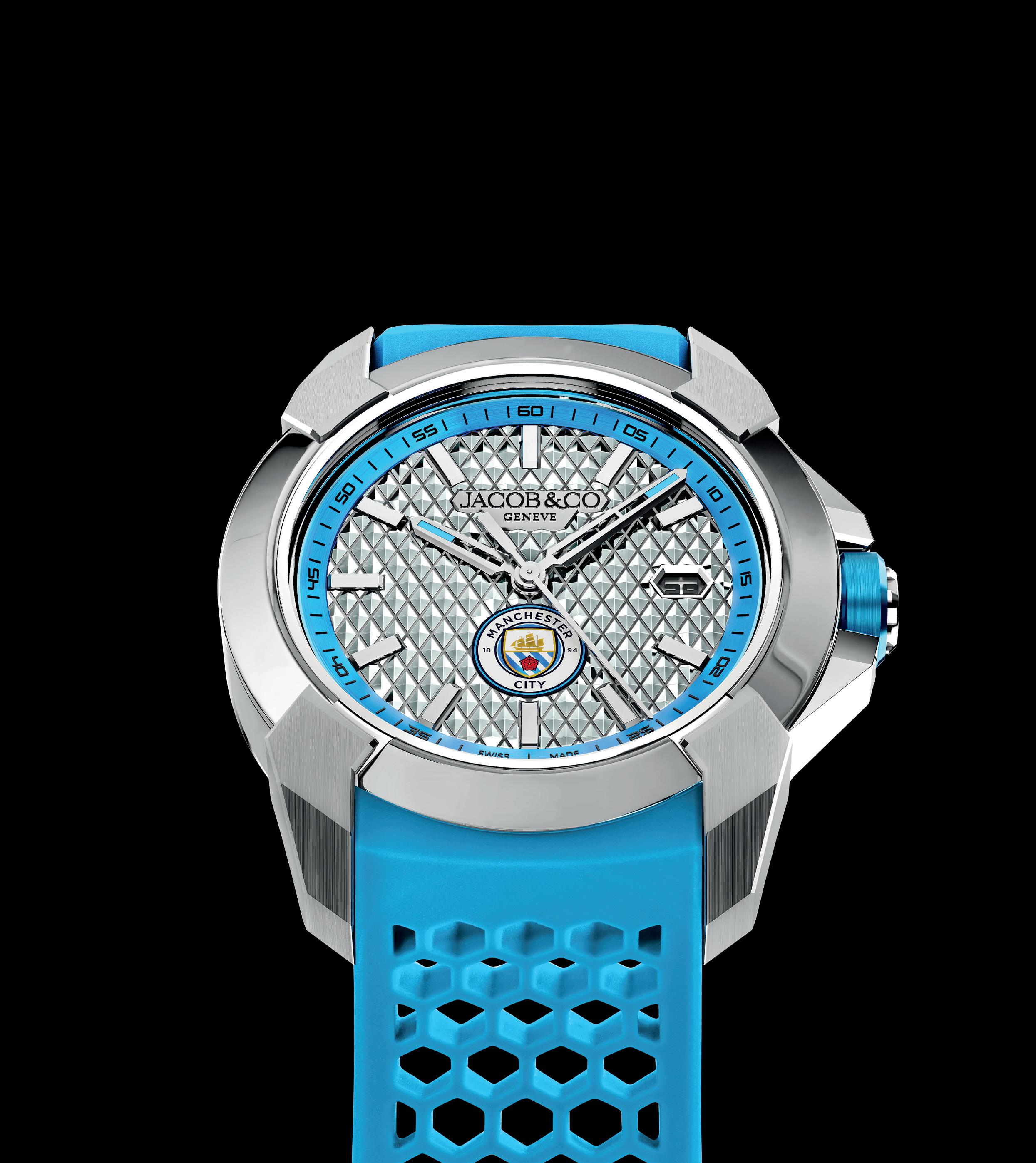

Trailblazing boxer and philanthropist Ramla Ali shares her journey of breaking barriers in sports and business. In this exclusive interview with The Executive Magazine, she discusses overcoming challenges, empowering women, and her exciting new partnership with SIRO

IIn an exclusive interview with The Executive Magazine, professional boxer and philanthropist Ramla Ali shares her inspiring journey from breaking barriers in the world of sports to becoming the first Muslim woman to win an English boxing title. Ali reflects on the challenges she faced in a male-dominated industry, her entrepreneurial efforts through the Ramla Ali Sisters Club, and her groundbreaking partnership with SIRO. She discusses the importance of representation, inclusivity, and the need for systemic change, while offering valuable insights into leadership and the business of sports. Looking ahead, Ali reveals exciting projects on the horizon, including a biopic and further expansion of her charitable work.
You’ve had a remarkable journey from boxing in Somalia to becoming the first Muslim woman to win an English title, and now stepping into your role as a key ambassador for SIRO. What motivated you to venture into professional boxing and how did you navigate the early challenges in a male-dominated sport?
“My motivation has always been to break down barriers and inspire the next generation. I knew the path I would be taking would mean struggling financially and having to self fund my whole Olympic boxing experience, especially in comparison to other athletes and nations, or trying to convince broadcasters and promoters in professional boxing to market and promote me. Something I still see today in the sports industry is how both gender and race plays a huge factor, you’re treated differently, and until we have representation in boardrooms we will forever be swimming upstream. Although I have faced challenges and battles with executives I always knew that regardless of the outcome of my career or how I progressed, those that followed would hopefully have it a little easier as a result of my journey and for that I wouldn’t have changed something (as small as it is) in the industry.”
Your ‘Ramla Ali Sisters Club’ is a testament to your commitment to inclusivity and empowerment. Can you elaborate on the strategic vision behind this initiative and how it has impacted the broader community?
“In 2018 I wanted to create a community and safe space that didn’t exist for me when I was growing up. I looked at my older sisters who are hijab wearing ethnic monitories and I thought to myself that these are the forgotten women of our society when it comes to opportunities and access to sport. Especially as they enter their older years and have families, but also still have huge ambitions to be active, to stay connected with communities and support groups and so the Sisters Club was born.
“It started as a once a week free boxing class to teach women of ethnic and religious minorities and those that suffer from domestic and sexual abuse. It was never meant to be about boxing, but rather about providing a safe space for these women to connect with each other. Now we operate four weekly boxing classes in London and one in New York, a run club in London and Florida and a basketball and football club in London. Looking after a little over 1,800 women each and every month across our various sports. All classes are free to enter and the ongoing vision is to expand both our sporting programs into other sports and other markets. Beginning next with the Middle East. Working with
a global hospitality brand like SIRO, who have ambitious plans to support the local communities in which they operate, also means I can reach a wider audience through our joint efforts. This is one of the reasons why I wanted to work with SIRO, which also has an ethos of empowering their guests to become the best version of themselves through its offering.”
Entrepreneurial ventures in the sports industry often come with unique challenges. What have been the most significant obstacles you’ve faced in growing your initiatives, and how have you overcome them?
“Creating and executing the idea is the easy bit. Raising funding is always the hardest. We’ve been fortunate enough to have some fantastic brands along the way to support our charity, but at first it was a battle. We of course are faced with weekly challenges; our classes are growing faster than we anticipated and are often oversubscribed with ladies asking for more, which is fantastic but also a difficult thing to manage. We also find it hard to capture content and market our classes because 95% of the women we support want to remain anonymous. The challenges we have with funding mean we are unable to provide marketing assets to show our success. Finding both great locations that are accommodating and qualified coaches who are reliable and specialise in certain sports was also a challenge we didn’t anticipate. Myself and my husband, who is my manager, are trustee members of the Ramla Ali Sisters Club UK Charity boards. We have both never taken a salary or an expense from the charity and this can be difficult at times whilst we juggle our regular work, both of which need nurture and attention.”
As a leader in both sports and charitable endeavours, what qualities do you believe are essential for emerging female leaders to succeed in these fields, and how can they be cultivated?
“Selfness is probably a defining quality and I wouldn’t say it’s a character trait found in a lot of athletes. To be an elite athlete you have to be selfish a lot of the time, so they don’t always go hand in hand. What I found as well, which is a shame, is that generally female athletes are often less supportive of other female athletes in comparison to men. I would say this is a huge factor in what’s holding us back. We need more forums, more unions, more select committees which are female lead and working together to create systemic change across broadcast time, brand and marketing equality, pay disparity.”
Your work with SIRO focuses on enhancing the guest experience through athletic insight. How do you plan to contribute to the development of programs and experiences at SIRO, and what impact do you hope these will have on the guests?
“SIRO is a truly unique place – unlike any other hotel I’ve ever stayed in or worked with. You get to experience the full spectrum of the life of an athlete from the training facilities which are unmatched to the recovery centre and treatment rooms. Every little detail of thought and expertise has gone into the delivery of the guest experience. My plan and hope is support the athletic programs further through more sports led classes for its guests, panel talks in which guest can interact with elite athletes and my ambition is to hopefully launch a Sisters Club partnership with the hotel which will allow for local Emirati women to also experience the charities work and bring that community together whilst

enjoying the facilities of SIRO.”
Being a role model for young girls, especially in traditionally male-dominated sports, is a significant responsibility. How do you approach this role, and what message do you hope to convey to the next generation of female athletes and leaders?
“I’m very conscious of this. It’s what leads my decisions on the brands I work with, what I say in a public forum and the types of people I interact with. I’m always aware of young girls and how impressionable they can be, so I make sure this is at the forefront of everything. I hope what people see in me is that the journey is as important if not more than the end result. We live in a society now which wants everything today, experiences, results, everything. My journey has been a long one. It’s a life of many rejections, many failures along with many successes. I want to be a representative and example of that ruthless refusal to quit.”
In your opinion, what are the key factors that distinguish a successful leader in the sports industry from others, and how do these factors align with your own leadership style and approach?
“A successful leader is someone who can not just understand the broader picture and plan but be able to take a step back and utilise the great teams around them to help execute this. You can’t do everything on your own and finding the right partners is what will support a greater legacy in leadership.”
Looking ahead, what are your future plans both in the realm of boxing and your philanthropic work? Are there any new projects or initiatives on the horizon that you’re particularly excited about?
“I was the first female to ever fight in the Kingdom of Saudi Arabia which I’m immensely proud of but it’s been an even bigger ambition of mine to compete professionally in Africa. Something I’m yet to do. Aside from this I’m currently an executive producer on a biopic movie about my life with my husband Richard entitled In The Shadows which has been seven years in development and we finally finished filming with BAFTA winning actress Jasmine Jobson playing myself. This has taken up most of my summer and autumn in 2024. With regards to my charity work I’m hoping to partner with UNICEF once again on a trip across either East Africa or the Middle East. Expand The Sisters Club into MENA and continue to raise awareness towards important issues of mine such as child protection and the rights of refugees. With regards to SIRO, I am looking forward to working with the team on the forthcoming launch of their second property and first in Europe, SIRO Boka Place in Montenegro which opens in Spring 2025.”
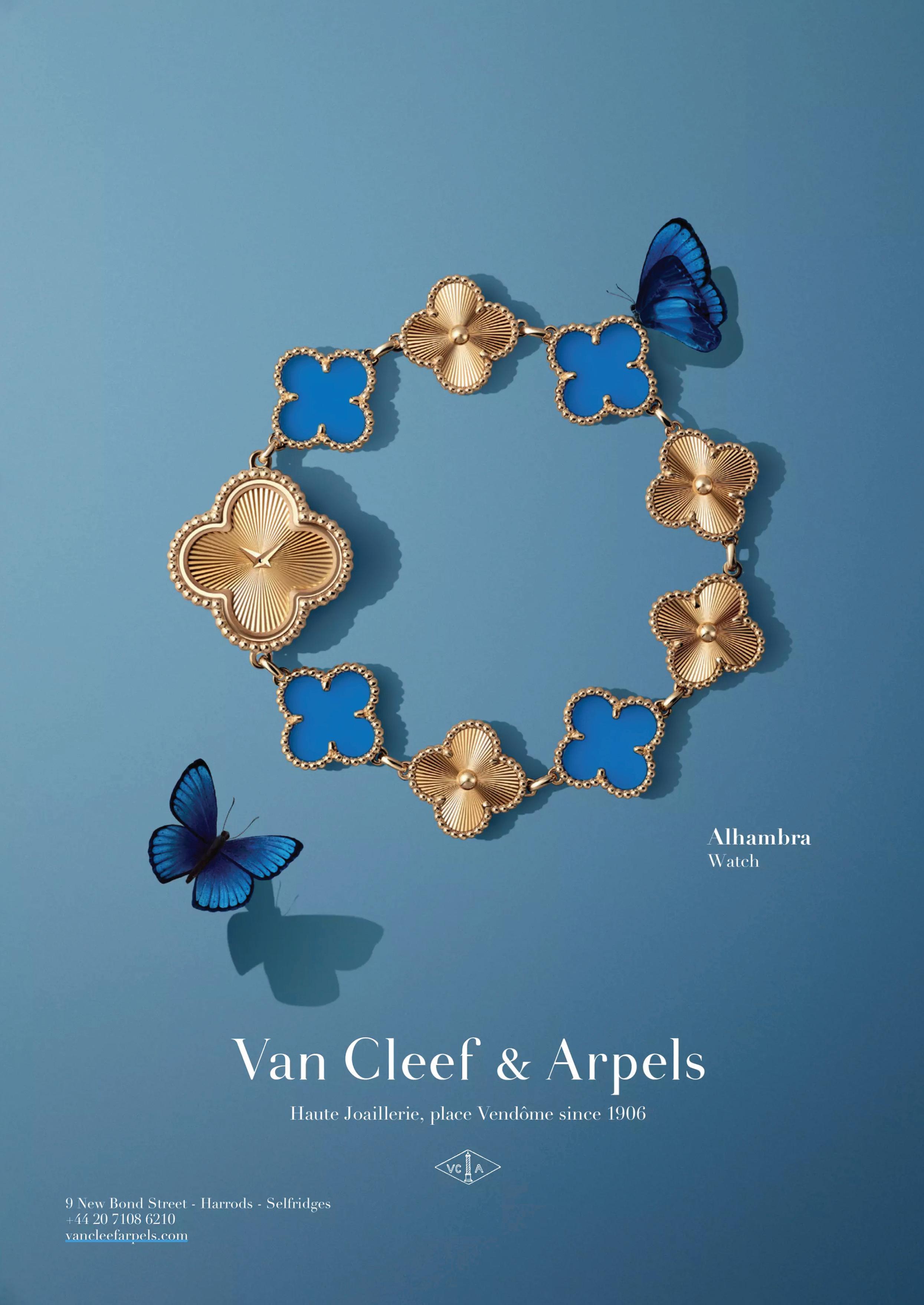
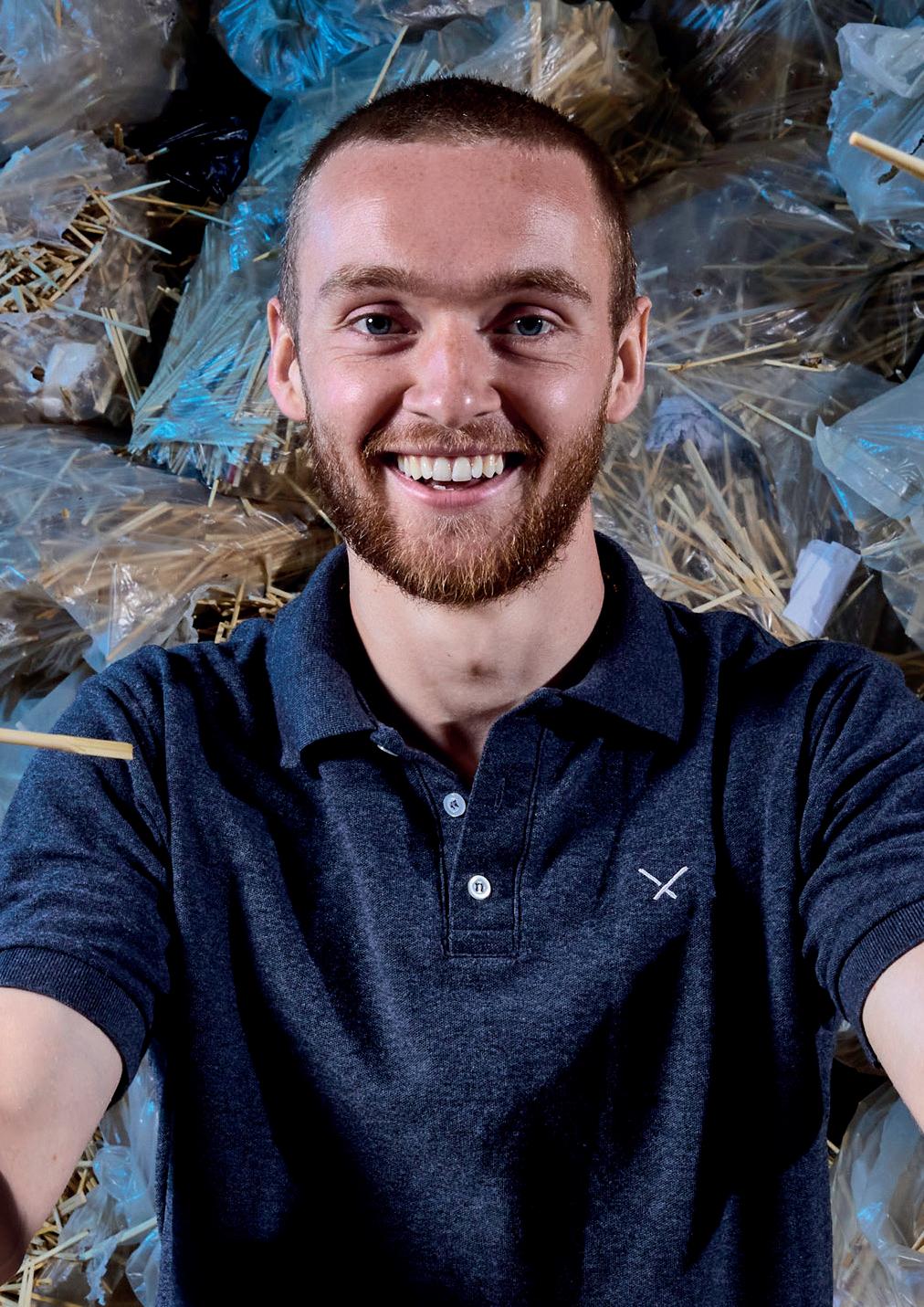
SSheffield United footballer Tom Davies shares his remarkable journey from the football pitch to the forefront of sustainable entrepreneurship. As Managing Director of ChopValue UK, Tom is transforming millions of discarded chopsticks into highperformance, eco-friendly furniture, while setting new standards for sustainable manufacturing. With candid insights on balancing his athletic career with running a pioneering business, overcoming market scepticism, and his vision for the circular economy, Tom offers valuable lessons for both entrepreneurs and executives alike. This conversation delves into his leadership philosophy, the challenges of building a green enterprise, and his mission to inspire a future where waste becomes resource.
You have successfully transitioned from being a professional footballer to leading a pioneering sustainable furniture company. What inspired you to venture into the circular economy and repurpose chopsticks into furniture?
“My journey into the circular economy started with a simple idea. My agent Neil Sang introduced me to the concept of ChopValue which existed in Canada, repurposing chopsticks into furniture and the opportunity to bring it to the UK. I’ve always been passionate about sustainability, so it felt like a perfect fit. ChopValue’s mission to transform waste into valuable resources really resonated with me. The fact that an estimated 80 billion chopsticks are used globally each year and are at risk of going straight to landfill was a huge motivator for me to get involved.”
Can you describe the journey of establishing ChopValue UK? What were the initial challenges you faced, and how did you overcome them?
“Starting ChopValue UK was no walk in the park. We faced a lot of challenges, from setting up the infrastructure to getting people on board with the idea. But with perseverance and a bit of help from my public profile, we got things rolling. We began by collecting chopsticks from local restaurants in Liverpool and Manchester, and it’s been an incredible journey since then. The initial scepticism about using chopsticks as a resource is a big hurdle, but we’re breaking down barriers by educating the market about the benefits of sustainable products.”
As a professional athlete and a business leader, how do you balance the demands of your football career with running a growing company? What skills from football have translated into your business practices?
“Balancing my football career with running a company is certainly a juggling act. But the skills I’ve gained from football; like teamwork, discipline, and strategic thinking, have been invaluable. It’s all about meticulous time management and making sure I give my best to both roles. Regularly visiting the microfactory and getting hands-on with the process, from sorting chopsticks to working the laser engraving machine, has been a rewarding experience.”
ChopValue UK has repurposed nearly five million chopsticks in its first year. What impact do you hope to achieve in the next five years, both environmentally and within the industry?
“Looking ahead, we hope to significantly increase the number of repurposed chopsticks. We’ve already repurposed nearly five million chopsticks in our first year, and our goal is to convert 25 million chopsticks into premium climate-positive products, saving up to 1,200 tonnes of CO2 emissions. Globally, ChopValue has already diverted over 160 million chopsticks from landfill, storing 7,890,770 kg of CO2 emissions. Our products are not only sustainable but also high-performance, being stronger than oak and harder than maple.”
What have been some of the most significant challenges you’ve encountered as an entrepreneur in the sustainable sector, and how have you addressed them?
“We’ve faced significant challenges, especially with market acceptance and operational logistics. But we’ve tackled these by continuously innovating and educating the market about the benefits of sustainable products. The fact that we’d already collected nearly five million chopsticks ahead of our grand opening in June this year is a testament to our efforts and the growing consumer adoption of sustainable products. Our current focus is to grow our sales, let the public and businesses know we exist, and that our products are functional, durable and a beautiful alternative to using virgin woods, and we have so many to choose from.”
As a business leader, what qualities do you believe are essential for inspiring and guiding a team towards innovative and sustainable solutions?
“For me, inspiring and guiding a team requires vision, resilience, and the ability to motivate others towards a common goal of sustainability. My leadership is driven by my commitment to environmental causes and my ability to inspire my team to achieve great things. I believe in leading by example and educating others on the importance of sustainability and responsible manufacturing.”
What advice would you give to aspiring entrepreneurs who are looking to make a meaningful impact in their industries, especially those interested in sustainability and the circular economy?
“My advice to aspiring entrepreneurs is to stay committed to your vision, keep learning, and be adaptable. Passion and perseverance are key, especially in the fields of sustainability and the circular economy. Believe in what you’re doing and keep pushing forward.”
Given your platform as a professional footballer, how do you leverage your influence in the sports industry to promote sustainability and responsible manufacturing practices?
“As a professional footballer, I use my platform to promote sustainability by raising awareness and advocating for responsible manufacturing practices. Balancing my football career with entrepreneurship has allowed me to leverage my public profile to support environmental causes, which is something I’m equally passionate about. I’m committed to ensuring upcoming generations have a healthy planet on which to thrive and understand the huge importance of treating it kindly.”

Discover the City Of Dreams Mediterranean Resort: The Ultimate Rewarding Getaway
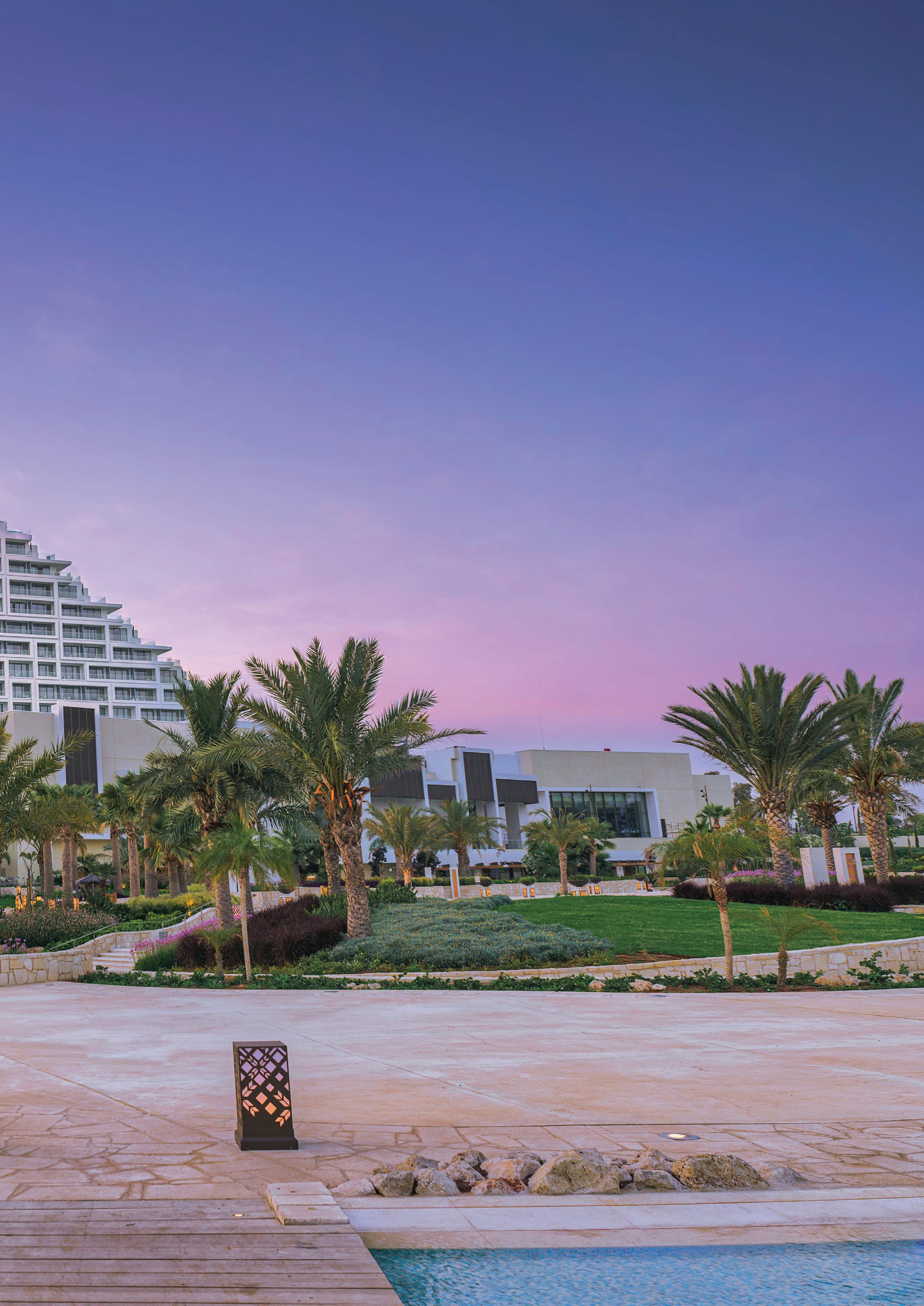
CCity of Dreams Mediterranean (COD) in Limassol, Cyprus, offers a new pinnacle of luxury as Europe’s first fully integrated resort. Nestled against the backdrop of the Mediterranean, the 5-star destination combines opulent accommodation, the island’s largest pool complex, and world-class entertainment. With over 500 lavish rooms and suites, the resort is designed to immerse guests in unparalleled comfort, offering sweeping views and impeccable service, recognised globally.
The resort’s casino, the largest in the Mediterranean, is complemented by an array of fine dining options, thrilling activities like the Waverider, and an Adventure Park for adrenaline seekers. Families, too, will find a wealth of options, including dedicated children’s pools and playful fountains. The design of the resort evokes the charm of Mediterranean villages while providing modern, luxurious amenities.
COD also serves as a premier venue for corporate events, combining leisure and business in an exclusive environment. Its location, facilities, and all-in-one convenience make it a top choice for both discerning travellers and executives alike, offering an experience that blends relaxation, entertainment, and sophistication at every turn.
Nestled along the sun-kissed shores of the Mediterranean, City of Dreams is a luxurious oasis that redefines the corporate retreat experience. With sophisticated business facilities and indulgent leisure amenities, this stunning resort creates a perfect balance of productivity and pleasure. Ideal for rewarding top performers or fostering team spirit, it promises an unforgettable escape that inspires creativity and collaboration

As guests enter the pristine private grounds, they are greeted by the impressive entrance, where attentive staff are quick to assist with luggage, ensuring a warm welcome from the moment of arrival. The check-in process is effortless, with the friendly team taking care of every detail. The expansive lobby, featuring modern, high-end décor, offers a glimpse of the resort’s on-site casino, hinting at the excitement that lies ahead.
To the right, The Platinum Club, a private gaming area reserved for elite members, adds an air of sophistication. This exclusive space provides a luxurious atmosphere, complete with elegant lounges, fine dining, and exceptional service, setting the tone for the premium experiences that define City of Dreams Mediterranean. The resort’s grand marble and mirrored interiors evoke a sense of glamour, immediately immersing guests in a world of luxury and excitement, reminiscent of the vibrant energy of Las Vegas.
COD offers a sanctuary of luxury with 500 meticulously designed rooms and suites that perfectly blend elegance and comfort. Inspired by the natural beauty of the Mediterranean, each accommodation features high ceilings and expansive windows, providing a seamless connection to the stunning surroundings. The interiors showcase a harmonious palette of soothing colours, complemented by geometrical shapes crafted from metal, wood, and textiles, ensuring a light and inviting atmosphere.
Guests can indulge in lavish bathrooms equipped with indulgent rainfall showers and oversized bathtubs, ideal for unwinding after a sun-soaked day. Each room includes a separate seating area, perfect for work or quiet relaxation. Premier Rooms, located between the third and fourteenth floors, provide breathtaking views of the Akrotiri Salt Lake and the resort’s manicured gardens from private balconies.

For those seeking an elevated experience, the resort features an impressive selection of suites. The Sky Suites offer up to 165m² of luxurious living space, with panoramic views of Limassol and the Mediterranean, along with modern amenities including interactive tablets for room control. Panoramic Suites provide an abundance of natural light through oversized windows, creating an inviting space for families or entertaining friends.

The crowning jewel is the Prestige Suite, a rooftop retreat complete with a private swimming pool and sweeping views of the coastline. The Presidential Suite epitomises sophistication, spanning two levels with over 400m² of space, featuring marble bathrooms, a private fitness room, and an infinity pool. This suite is often reserved for distinguished guests, offering a truly decadent experience with unparalleled luxury and breathtaking vistas.
The resort presents an impressive array of dining experiences, catering to diverse palates with options ranging from casual poolside fare to exquisite fine dining. Currently home to seven unique outlets, the resort is set to expand its culinary offerings with the anticipated opening of the Prime Steakhouse, where guests can indulge in premium cuts of succulent meat in an elegant setting.
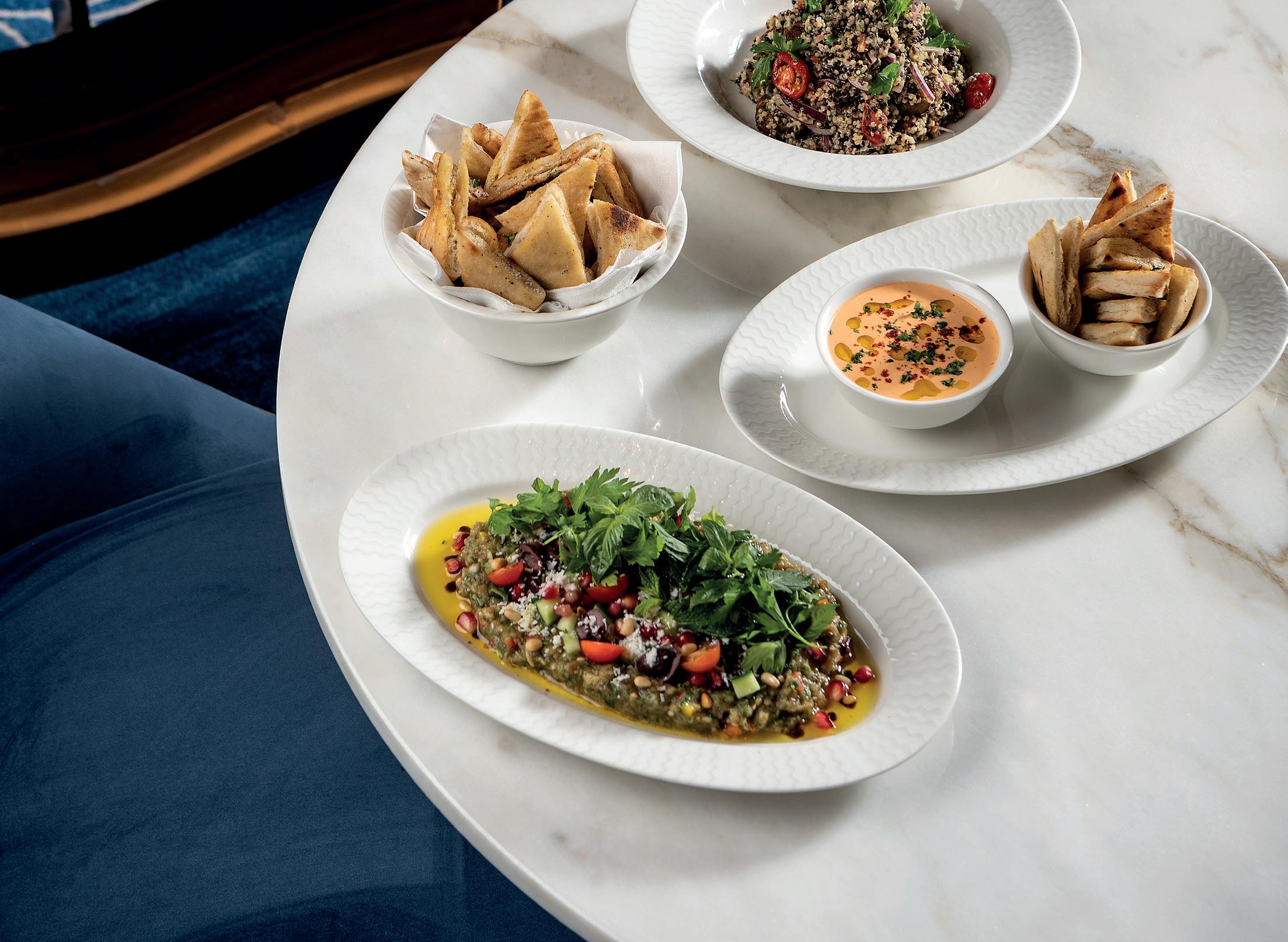
For a relaxed dining atmosphere, Aqua Bar offers refreshing bites beside the pool, while Veranda Café, located near the lobby, serves a delightful selection of smoothies, juices, coffee, and gelato. The Lounge provides an art-deco-inspired space for guests to unwind with a cup of coffee or a fine glass of wine. High rollers can enjoy quick bites at Center Stage, conveniently located within the casino.
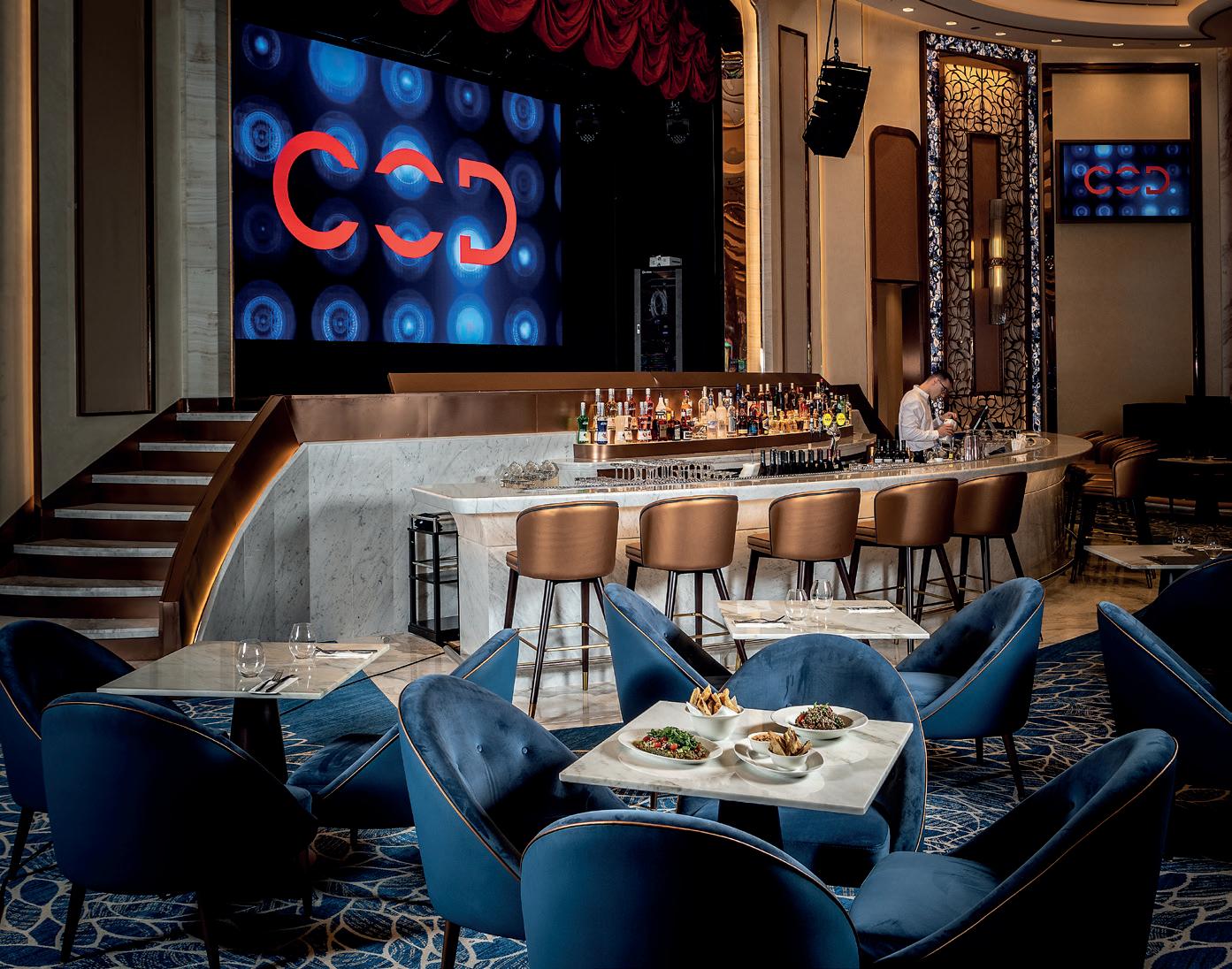
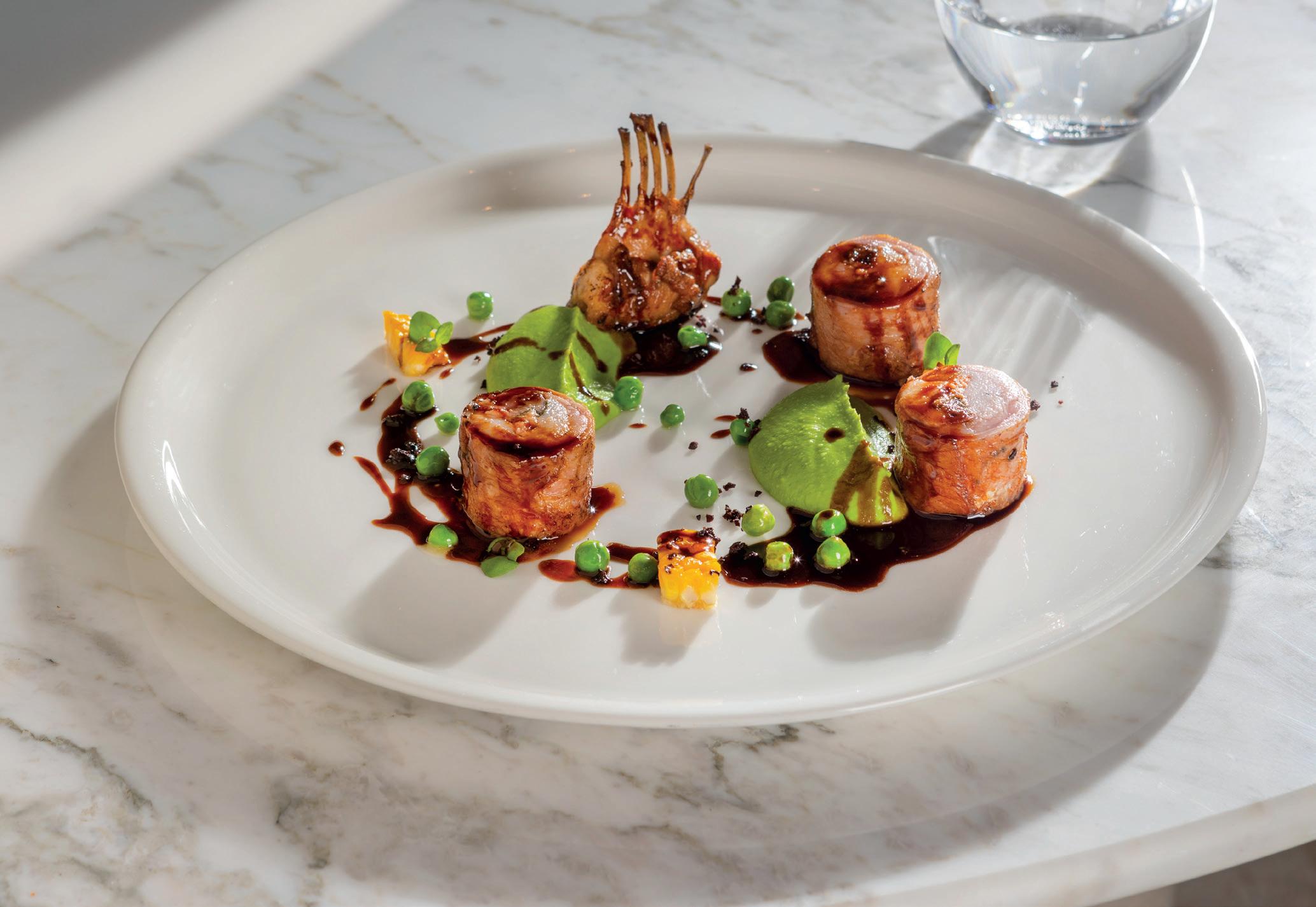
Prime Steakhouse sets the stage for an immersive dining experience focused on top-tier meat selections grilled to perfection. Diners can indulge in heritage prime cuts, accompanied by an exclusive selection of mustards and sauces, alongside a carefully curated wine list and an extensive collection of rare whiskies in the Cigar Lounge Area. In-room dining is also available, allowing guests to enjoy exquisite dishes from the comfort of their rooms.
This October, the resort welcomes renowned two-Michelin-starred Chef Arnaud Bignon from Spondi in Athens, offering guests the opportunity to savour a remarkable five-course dinner menu expertly paired with exceptional wines from Famille Perrin.
Three premium dining venues promise exceptional culinary experiences. Amber Dragon, inspired by the Michelin-starred Dragon family of restaurants in Macau, invites guests on a journey through PanAsian cuisine, featuring a captivating open kitchen and a specialty wood-fired Peking duck oven. At Anaïs, the resort transforms into a vibrant poolside venue every weekend, offering glamorous parties with live entertainment, cocktails, and a lively atmosphere that extends from day into night.
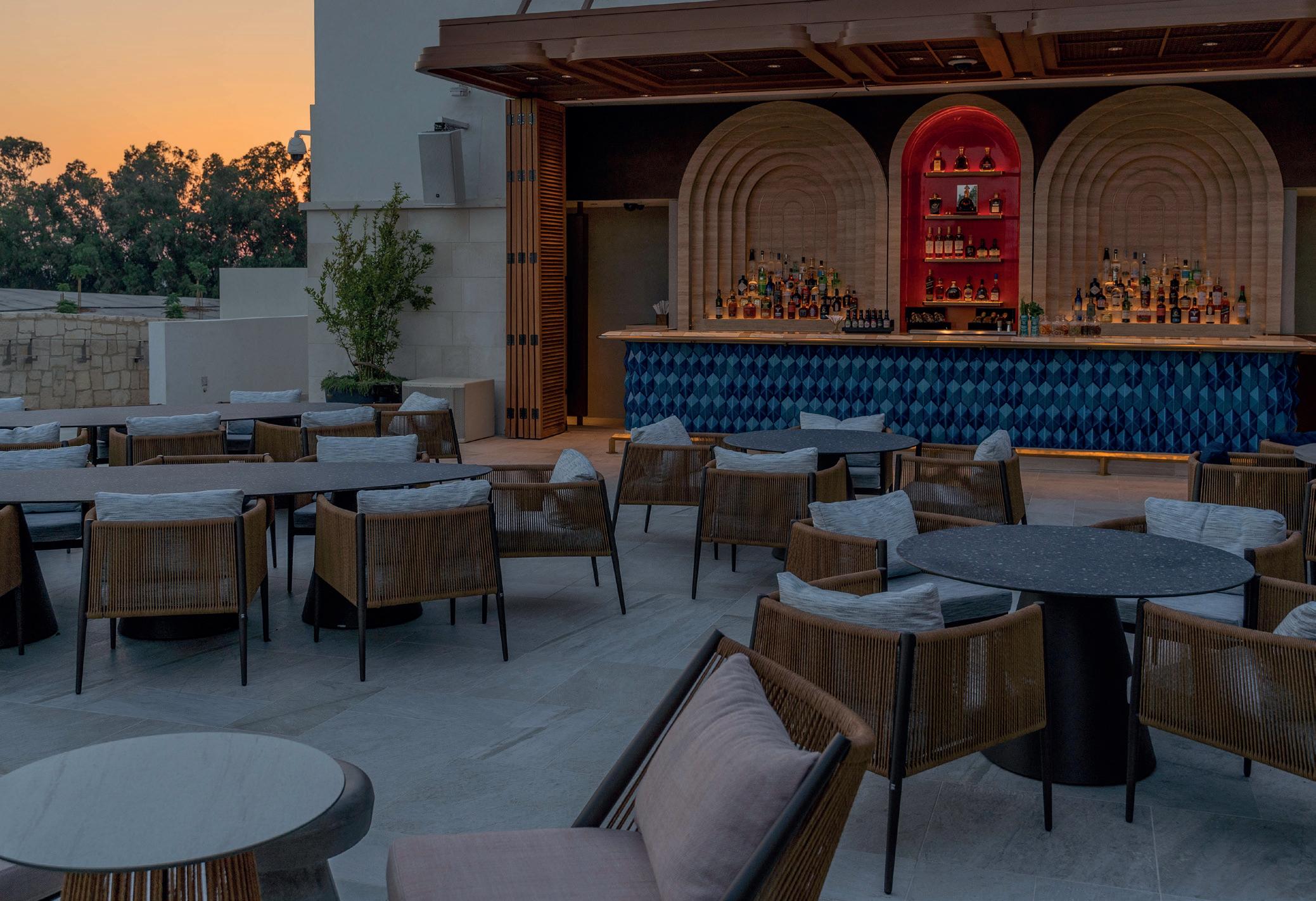
City of Dreams boasts an impressive array of world-class facilities designed to enhance every guest’s experience. From the exhilarating Grand Casino to the expansive pool complex, the resort seamlessly blends leisure and entertainment for families, couples, and business travellers alike. Each space is meticulously crafted with state-of-theart technology and innovative design, inviting guests to unwind, play, or connect in an inspiring environment. Whether engaging in adrenaline-pumping activities or retreating to serene havens, visitors can enjoy thoughtfully designed areas that capture the essence of luxury living, ensuring that every moment at the 5 star hotel is unforgettable.

At the heart of the resort lies the Grand Casino, a stunning 7,500 sq. meters (80,000 sq. ft.) of opulence, featuring state-of-the-art gaming facilities and a diverse array of games. Whether you’re a seasoned player or simply seeking a fun night out, you can try your luck at the slot machines or elegant card rooms for blackjack and poker. The experienced and attentive staff are ready to assist you, guiding you through each game to enhance your experience. For elite members, the exclusive Platinum Club offers an intimate gaming area with exceptional service, fine dining, and entertainment.
The resort’s pool complex is the largest in the area, featuring both outdoor and indoor heated pools. The Grand Pool serves as a refreshing oasis, perfect for families with a dedicated Kids’ Pool complete with exciting slides. For those seeking tranquillity, private cabanas and a relaxing pool bar offer the ideal spots to unwind. An indoor pool, heated for winter comfort, is perfect for exercising or leisurely swims. The Beach Pool delivers a unique sandy beach vibe right at your feet.
Indulge in luxury at the Balmain Hair Salon, where expert stylists provide exceptional service to keep your hair looking fabulous. For a high-end shopping experience, visit the curated selection of designer boutiques featuring renowned brands like Cartier, Gucci, and Prada.
Tennis enthusiasts can enjoy world-class facilities at the Marcos Baghdatis Tennis Academy, home to 12 stateof-the-art courts and a professional-sized centre court for international tournaments. The academy emphasises personalised coaching and community engagement.
The vibrant entertainment scene at COD ensures endless excitement, featuring concerts, dance shows, and exclusive parties that cater to every taste.
Families will find a wealth of activities to keep everyone entertained. Game Zones offer video games, billiards, and arcade classics. Kids can revel in endless fun at Aqua World, with thrilling slides and fountains, or explore the Adventure Park, featuring an 18-hole miniature golf course, zip line coaster, and climbing wall.

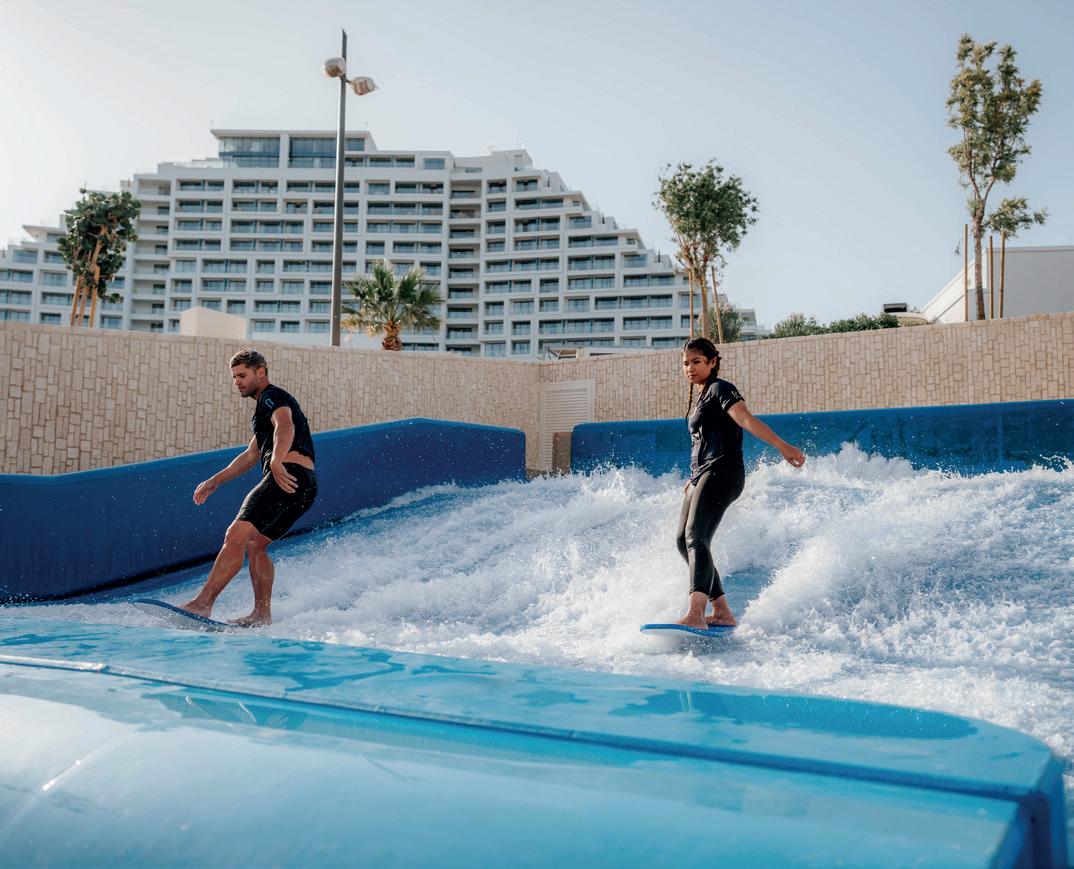

For those seeking rest and relaxation, Renu, the resort’s opulent spa, presents an extensive menu of treatments and therapies. Guests can unwind with a variety of massage and holistic rejuvenation therapies designed to restore both mental and physical wellbeing. The spa offers revitalising facials, anti-aging treatments, and indulgent hand, foot, and body treatments that cater to diverse needs.

The spa also features a state-of-the-art fitness centre, a health club with saunas, a steam room, and a jacuzzi, alongside a welcoming indoor pool, all available yearround.
The wellness programs focus on regeneration, offering personalised treatments designed to awaken the senses and foster relaxation. Guests can immerse themselves in an array of luxurious treatments using high-end beauty brands such as Swiss Perfection, 111SKIN, Natura Bissé, Omorovicza, and Bvlgari.


Highlights include the Quality Time Couple’s Massage, which envelops partners in a serene ambiance, featuring synchronised strokes and nourishing body oils for a deeply relaxing experience. Additionally, the Deep Tissue massage targets and releases deeply held tension, promoting a sense of harmony. Other notable services include the Gent’s Care facial, tailored for men’s skin, and the Cellular Perfect Lifting treatment, which visibly improves skin firmness and promotes cellular renewal, sculpting the face and smoothing wrinkles.


With over 8,000 m² of versatile indoor and outdoor event space, the resort offers an exceptional setting for memorable gatherings, from intimate meetings to large-scale conferences. The venue features a grand ballroom, a spacious forum, and five adaptable meeting rooms, alongside stunning outdoor locations that provide breathtaking backdrops
The state-of-the-art facilities are designed to accommodate bespoke events, ensuring each gathering aligns with specific visions and goals. The resort’s dedicated events team, in collaboration with trusted partners, brings innovation and creativity to every occasion, including structured team-building activities.
The resort’s corporate facilities encompass a range of impressive spaces designed to elevate any event. The Forum serves as the island’s largest expo centre, ideal for large gatherings, while the Grand Ballroom provides a stunning venue for memorable occasions. Five flexible meeting rooms cater to diverse needs, inspiring creativity and collaboration, and the picturesque amphitheatre offers a unique outdoor setting for special events, enhancing the overall experience. Together, these facilities ensure that every corporate gathering is executed with elegance and sophistication.


Perched along the sparkling shores of Ibiza’s east coast, Nikki Beach Ibiza offers a sophisticated escape where luxury meets leisure. Known for its vibrant atmosphere, impeccable service, and world-class cuisine, this renowned beach club invites guests to indulge in an unforgettable experience that blends relaxation, entertainment, and gourmet dining against the backdrop of the Mediterranean

NNikki Beach Ibiza, nestled in the picturesque Santa Eulalia area, stands as one of the island’s most celebrated beach clubs, offering a seamless blend of relaxation, entertainment, and exceptional dining. Known for its world-class hospitality, Nikki Beach is not merely a destination—it is an experience. Since its inception, this iconic venue has remained synonymous with luxury, delivering an unforgettable atmosphere for discerning guests.
Located in a pine-shaded cove along Ibiza’s east coast, Nikki Beach Ibiza boasts breathtaking views of the Mediterranean Sea. The beach club opens its doors at 11 a.m., welcoming guests to indulge in its offerings from brunch until the sun dips below the horizon. Whether it is a chilled-out afternoon or an upbeat celebration, the venue effortlessly caters to both moods, providing an experience that is both tranquil and vibrant.
At Nikki Beach Ibiza, dining is a refined affair. The extensive, curated menu reflects a deep appreciation for high-quality ingredients, offering a range of internationally inspired dishes with a distinct Spanish flair. Guests can enjoy fresh seafood, innovative sushi rolls, healthy salads, and slow-roasted free-range rotisserie chicken, all while taking in the stunning beachfront views.
For those seeking a more social dining experience, the beach club is renowned for its signature sushi boats and sharing platters, perfect for large groups. Nikki Beach’s dedication to excellence is evident in its culinary offerings, which cater to a variety of tastes and dietary preferences, including a selection of vegetarian dishes.
The luxurious daybeds at Nikki Beach are the epitome of comfort, set against the azure backdrop of the Balearic Sea. Guests can unwind on the club’s signature white daybeds while enjoying the relaxed yet vibrant atmosphere. The attentive staff ensures that



every need is met, allowing guests to focus on enjoying their time in the sun without a care in the world.
The ambience is enhanced by resident and guest DJs who provide the perfect soundtrack to the day. Whether it is chilled-out lounge music or more upbeat sets, the music seamlessly complements the dining and social experience. The venue’s design, featuring terracotta tones and natural wood accents, perfectly harmonises with the surrounding landscape, creating a sophisticated yet laidback vibe.
Nikki Beach is not only a destination for leisure but also a premier venue for high-profile corporate events. Known for hosting bespoke functions for globally renowned luxury brands such as Perrier-Jouët, Maserati, and Valentino, the venue offers customised event planning services. From intimate gatherings to grand celebrations, Nikki Beach Ibiza provides the perfect setting for product launches, retreats, and cocktail parties.
The experienced events team ensures that every detail is meticulously planned, offering tailored catering, entertainment, and decor solutions to create one-of-a-kind experiences. For executives seeking to impress clients, reward teams, or foster new partnerships, Nikki Beach Ibiza delivers unparalleled service in an unforgettable setting.
For those visiting for the first time, Nikki Beach Ibiza leaves a lasting impression. The beach club’s combination of luxurious surroundings, exceptional service, and relaxed atmosphere provides a welcome retreat from the hustle and bustle of everyday life. Guests are treated to attentive service throughout the day, ensuring that every moment is spent in comfort.
Whether lounging by the pool, sipping on a freshly crafted cocktail, or enjoying a leisurely lunch, guests at Nikki Beach are immersed in an environment designed to celebrate life’s finest pleasures. For business executives looking to balance work with relaxation, Nikki Beach Ibiza offers the perfect balance of sophistication and leisure.
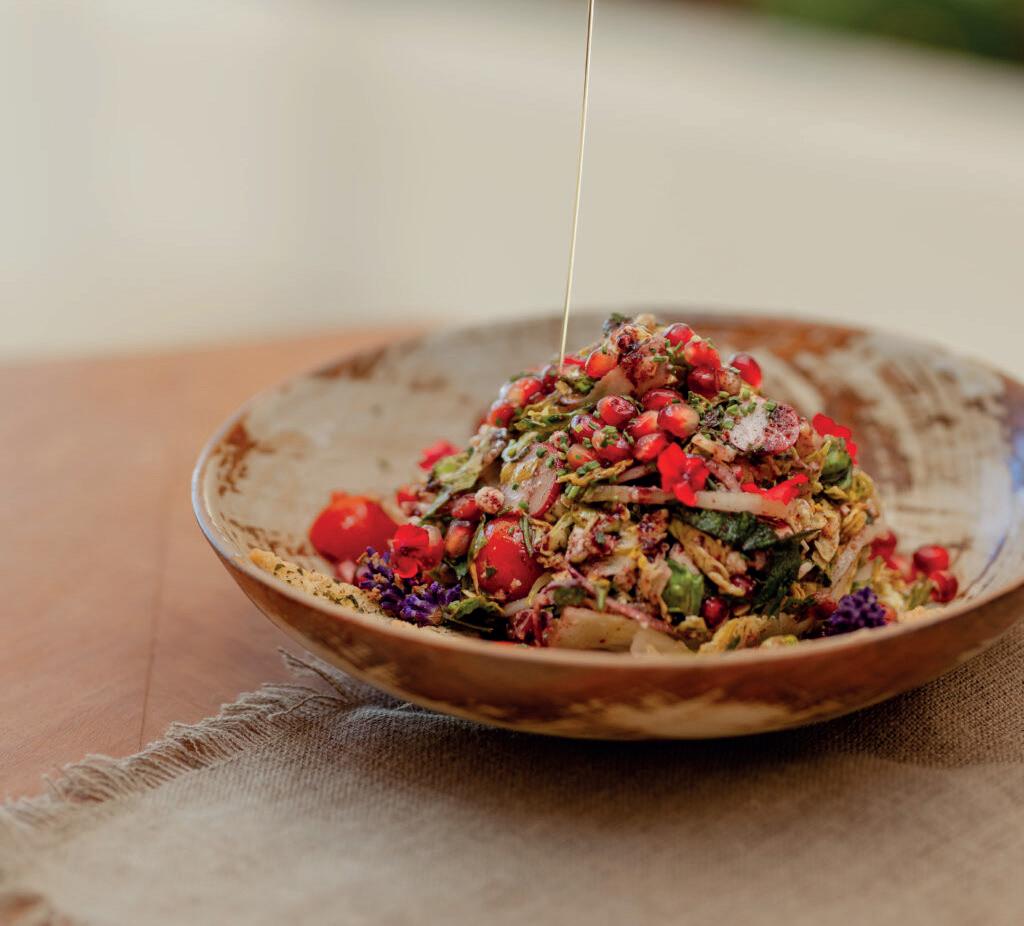



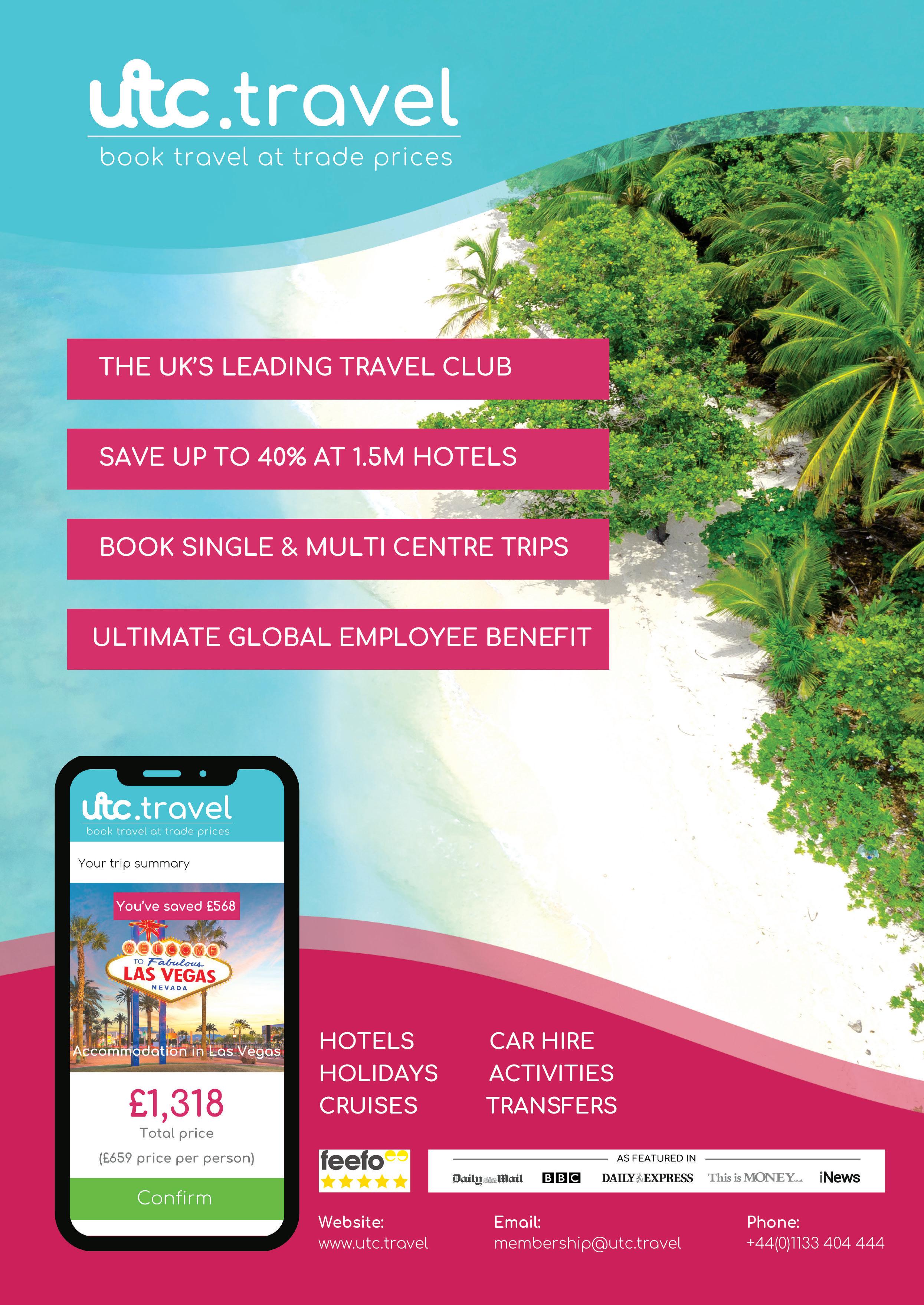
As the festive season approaches, discerning executives seek the perfect tokens of appreciation for loved ones, colleagues, and clients. Our curated list of luxurious gifts offers the finest in gourmet, spirits, and unique experiences, ensuring each choice is an unforgettable indulgence
Celebrate the new Continental GT Speed with Bentley’s Limited Edition Luggage Set, crafted from premium Italian leather. The set includes a Weekender Bag, Backpack, and Washbag, each embossed with the Bentley emblem. Available in Gravity Grey with Mandarin, Kingfisher, or Hotspur accents, this exclusive collection is priced at £2,500. Produced in limited quantities for this season only, these luxurious sets won’t be available once sold out.

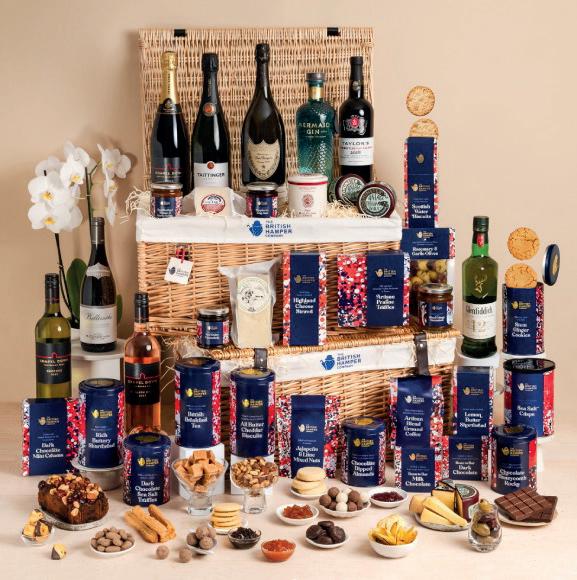
Indulge in luxury with The Grand Extravagance Hamper from The British Hamper Company, an opulent collection of fine wines, spirits, and British artisan delicacies. This lavish gift features vintage champagnes like Dom Pérignon and Taittinger, alongside the rich, smoky Glenfiddich 12 Year Old Single Malt Scotch Whisky. Pair these exceptional drinks with artisanal treats, from blue Stilton and Lincolnshire Poacher cheeses to buttery shortbread, velvety chocolate truffles, and a tangy beetroot and horseradish chutney. Presented in two luxurious hand-woven wicker baskets, this hamper is the epitome of extravagant gifting.
The Bugatti Chiron Spirit Safe epitomises luxury and highperformance design. Inspired by racing tracks and France’s illustrious racing heritage, this safe features flowing lines and characteristic hues of blue that pay tribute to Bugatti’s legacy. Priced at a premium, it combines the iconic horseshoe radiator and signature C-line with innovative elements. The Spirit Safe’s design not only reflects Bugatti’s renowned C-Shape but also evokes the dynamic energy of a racetrack. Inside, your precious watches are displayed to perfection within the B&Z watch winders. A security glass panel protects against scratches and dust, offering both elegance and optimal security.
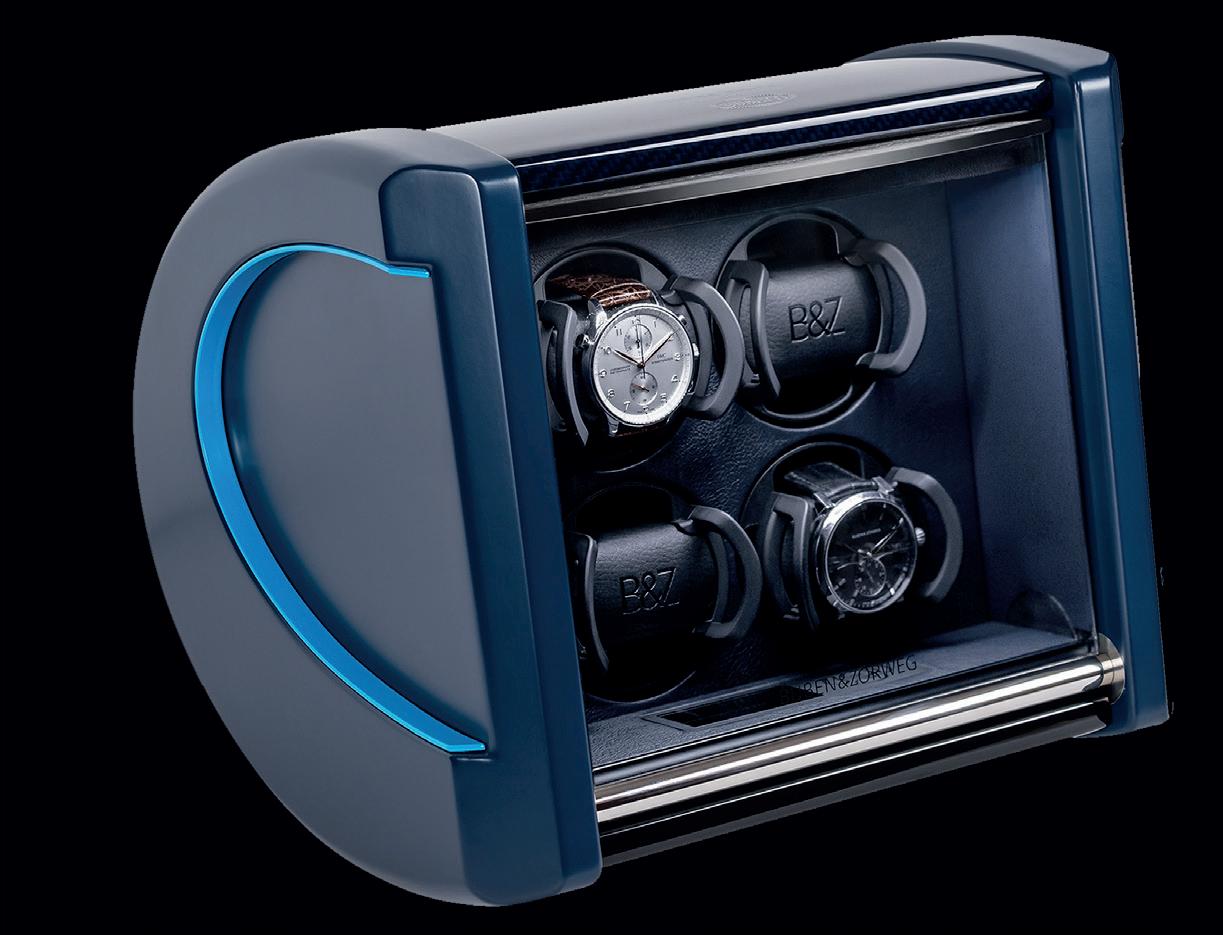

Goldmund’s Pulp + Hub wireless speaker system delivers luxury audio with stunning design. Combining sleek, active stereo speakers with a new Hub for improved connectivity and high-resolution streaming, the system uses WiSA technology for wireless hi-res audio. It also supports aptX HD Bluetooth and wired playback via HDMI, coaxial, and optical inputs, making it ideal for both music and home theatre setups. The speakers, designed by Cécile Barani, feature an iconic cylindrical aluminium silhouette, blending modern aesthetics with cutting-edge audio performance.
Wine lovers will be captivated by the Porte Noire 2013 Grand Cru Blanc de Blancs, a Champagne that embodies the essence of the terroir with its minerality and single vintage purity. This bottle is rich with notes of orchard fruits, apple turnover, and crème caramel. Whether saved for a special occasion or enjoyed as an aperitif, it is a gift that exudes sophistication.
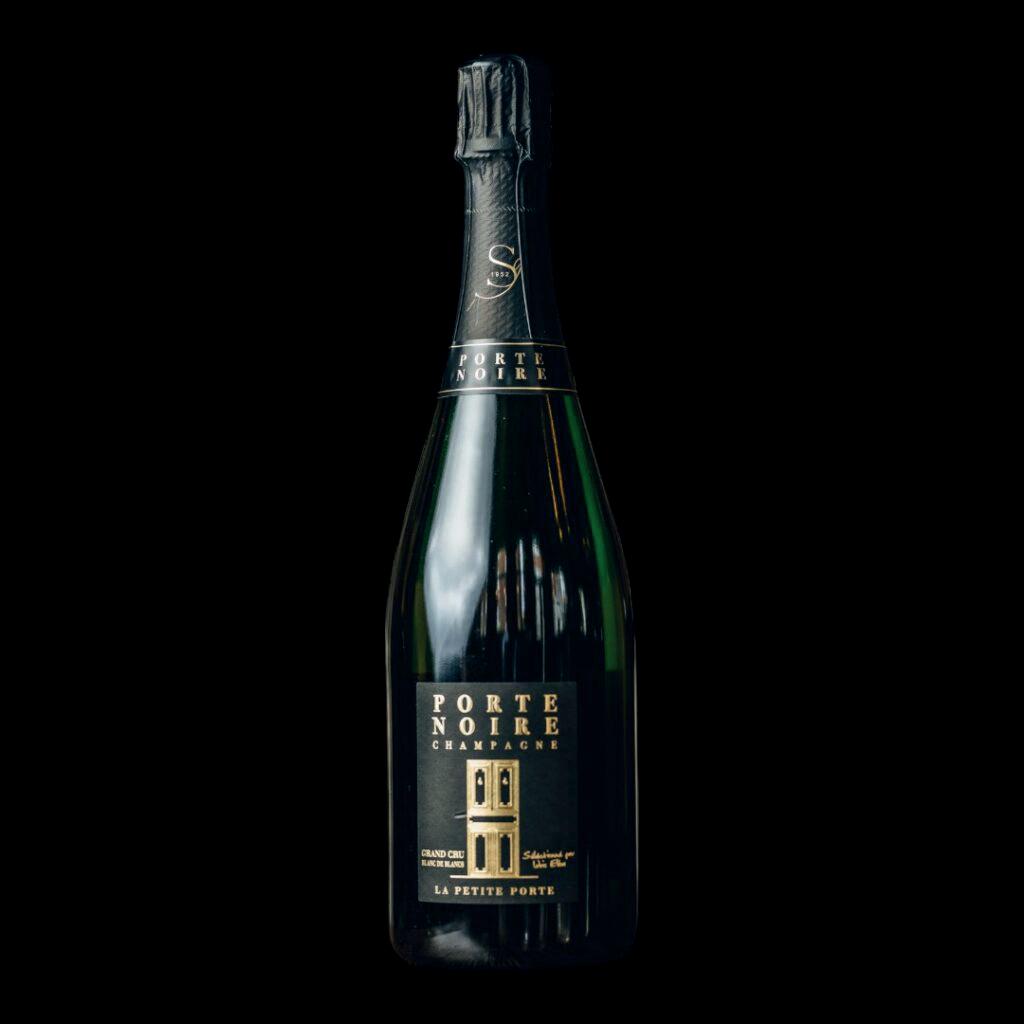
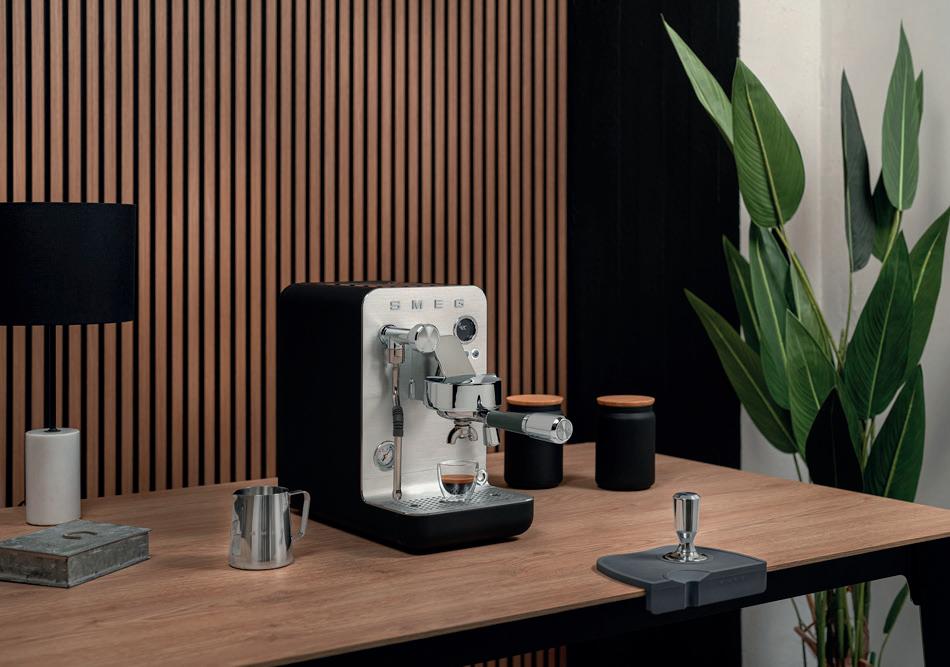
For the coffee lover seeking barista-quality performance, the Smeg EMC02 Mini Pro Espresso Machine delivers in style. This compact yet powerful machine offers both manual and automatic extraction, ensuring versatility for every coffee preference. Featuring three Thermoblocks, it quickly heats up to serve perfect espressos, lattes, or macchiatos, making it ideal for festive mornings. With its sleek design and impressive functionality, the Mini Pro transforms any kitchen into a café bar, offering luxury coffee experiences from the comfort of home.
Casa Noble’s Marqués de Casa Noble Tequila stands out as a premier gift for aficionados of this fine spirit. Crafted from 100% Blue Weber Agave grown in Jalisco’s volcanic soils, this ultra-premium, limited-release tequila offers a sustainable, luxurious experience. An exceptional choice for those who appreciate the finest in tequila craftsmanship.
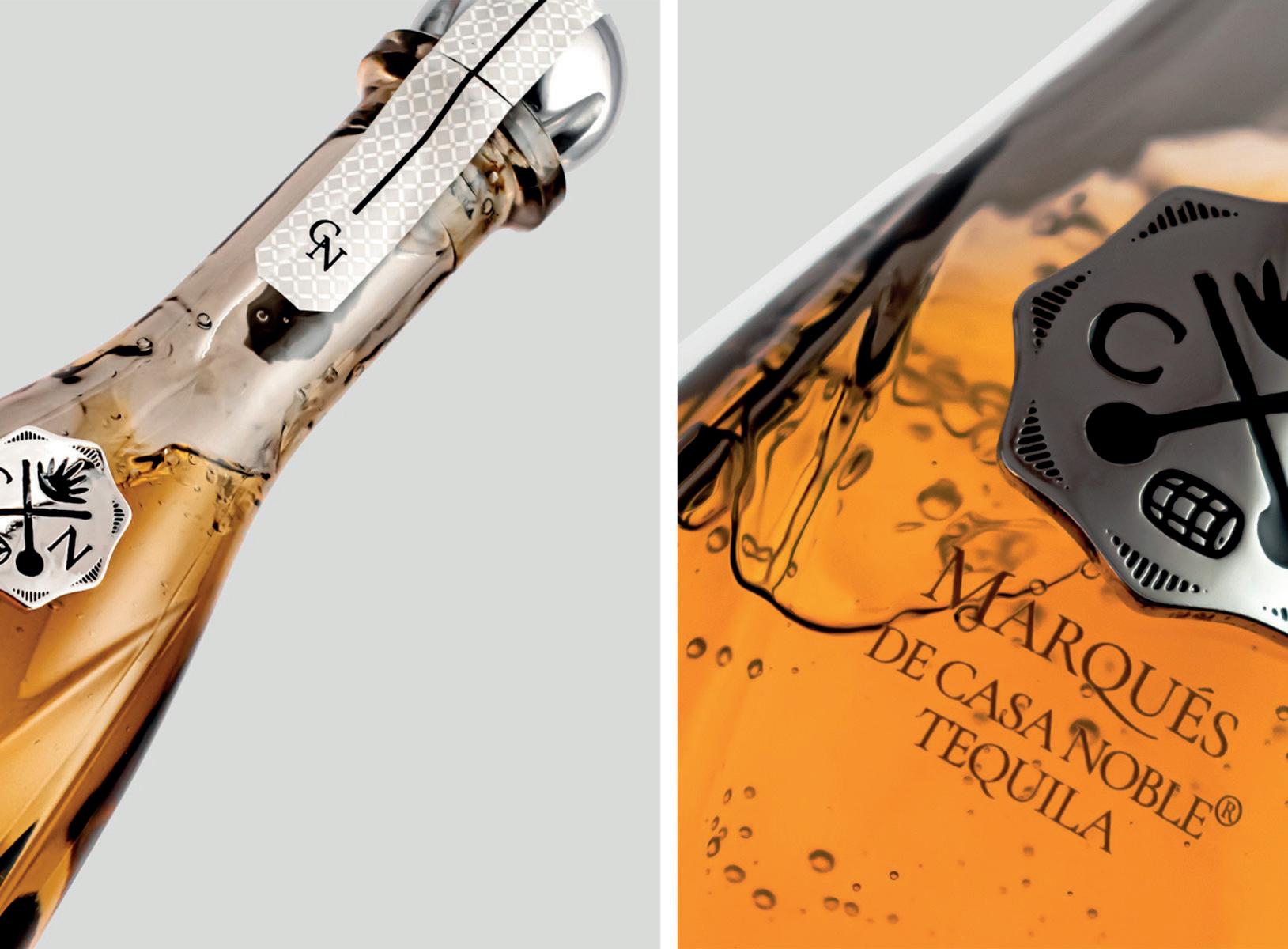

The Shokunin Sideboard by Patience & Gough is a masterpiece of luxury and artistry. Featuring handlaid marquetry of mother-of-pearl and dyed veneers on its tambour doors, this exquisite piece is crafted with hundreds of precision-engineered moving parts. Designed by Patience & Gough and produced by the renowned Shamsian workshop in Oman, the sideboard blends regal heritage with meticulous craftsmanship, making it a timeless heirloom and the ultimate statement piece for any home.
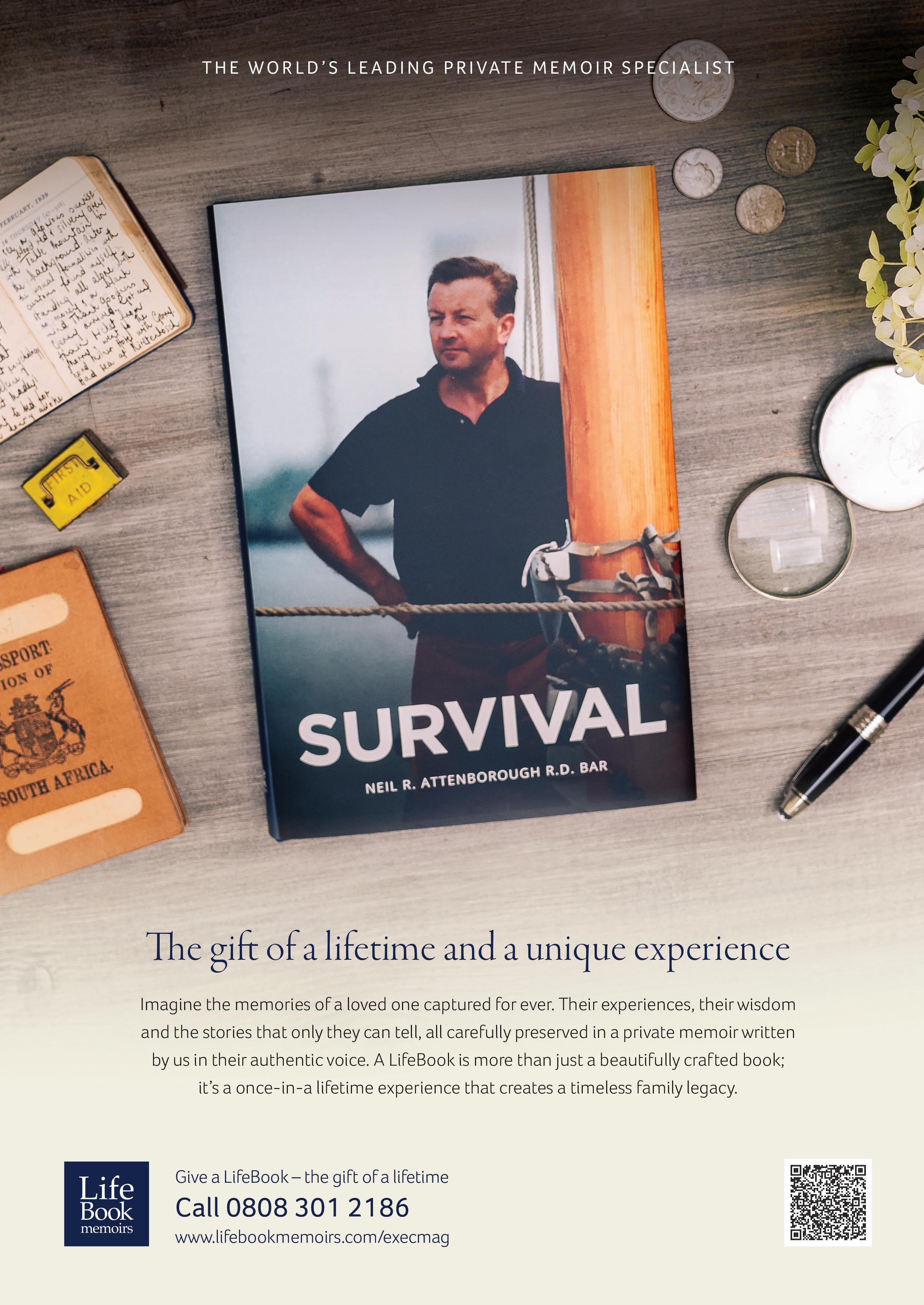

HexClad’s patented hybrid cookware combines the best of stainless steel, cast iron, and non-stick convenience, offering Michelin-level performance for home chefs. Designed for ultimate versatility and durability, this cookware is built to last and ensures effortless cleanup. Elevate your kitchen game even further with the 67 Layer Japanese Damascus Steel chef’s knife, featuring an incredibly sharp edge and precision tip. Its ergonomic design and perfect balance make slicing through tough veggies or trimming proteins an effortless task. Ideal for anyone looking to cook like a pro at home.
For those who seek the luxury of fine dining, Northcote offers an unparalleled experience with its Five Course Gourmet Menu paired with a wine flight. This exquisite dining experience showcases the innovative creations of the acclaimed kitchen brigade under the direction of Lisa Goodwin-Allen. The seasonal menu, rich in flavour and artistic presentation, is complemented by expertly selected wines for each course, creating a global tasting journey.
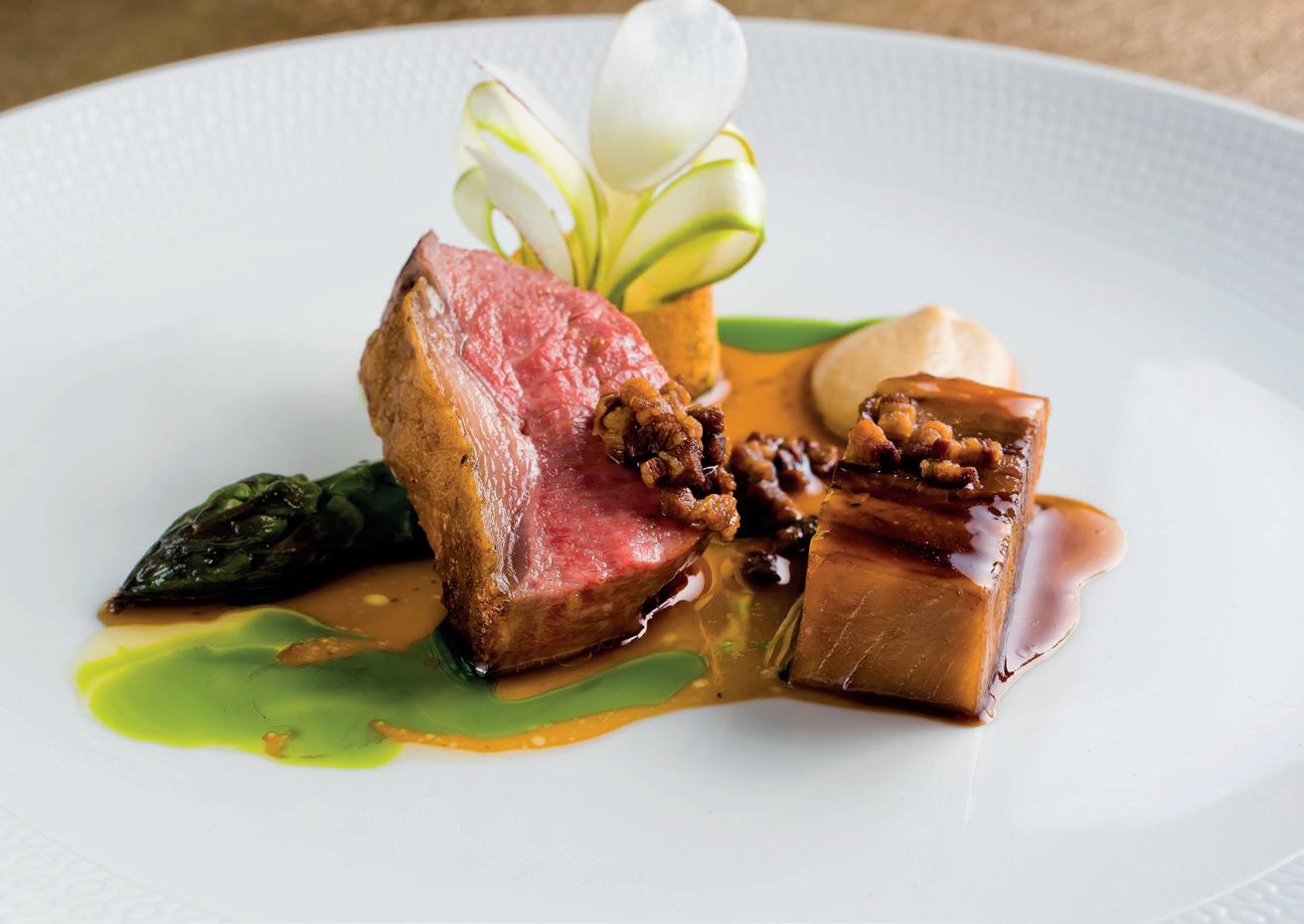

For those who value sustainability, the Harvest 2019 Rye Whisky from Fielden Whisky offers an exceptional and eco-conscious gifting option this Christmas. Crafted from heritage grains grown on regenerative farms, this whisky is free from chemicals, embodying a bold celebration of sustainable agriculture. This release delights with fresh, floral, and fruity notes, enhanced by a touch of zesty spice. It’s a meaningful gift that combines environmental stewardship with the timeless appeal of fine whisky.
For the wine collector, the Schrader Old Sparky 2021 is an unrivalled treasure. Sourced from the iconic To Kalon Vineyard, this Napa Valley Cabernet Sauvignon is exclusively available in Magnum. With its concentrated fruit notes and elegant floral and spice undertones, this full-bodied wine, aged in new French oak, is perfect for cellaring, making it a remarkable gift for the discerning oenophile.
Schrader Cellars

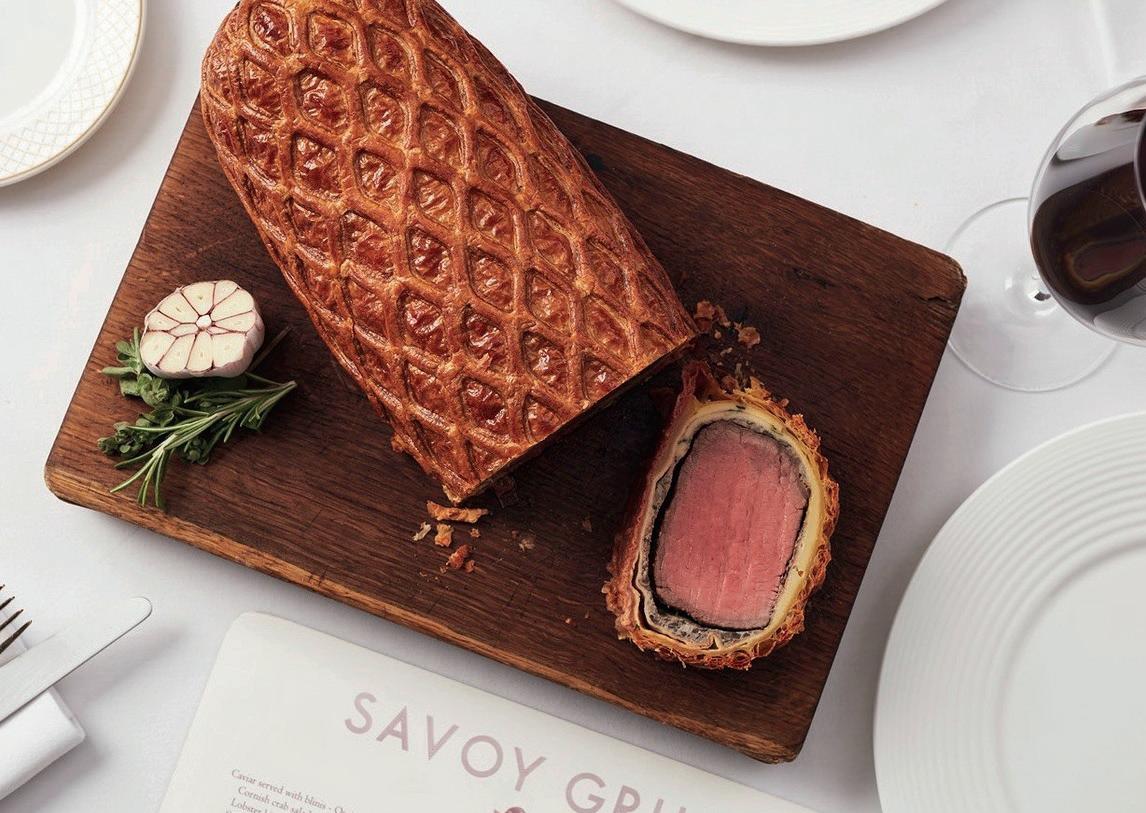
Gifting an experience can be just as impactful as a tangible item. The Beef Wellington masterclass at Gordon Ramsay’s Savoy Grill offers an unforgettable journey into the culinary world. Participants not only learn how to craft the famous dish in the world-class kitchens but also enjoy a bespoke three-course lunch with wine pairings, making it an extraordinary gift for those who value both skill and memory-making.
Savoy Grill, London
Give the gift of legacy with a bespoke biography from LifeBook Memoirs. Professionally crafted by world-class writers, these beautifully written books capture the life stories of loved ones, preserving their memories and personal history for future generations. Whether for introspection or to pass down cherished experiences, a LifeBook is a lasting heirloom that ensures unique stories are never forgotten, offering a deeply rewarding experience for both the subject and their family.
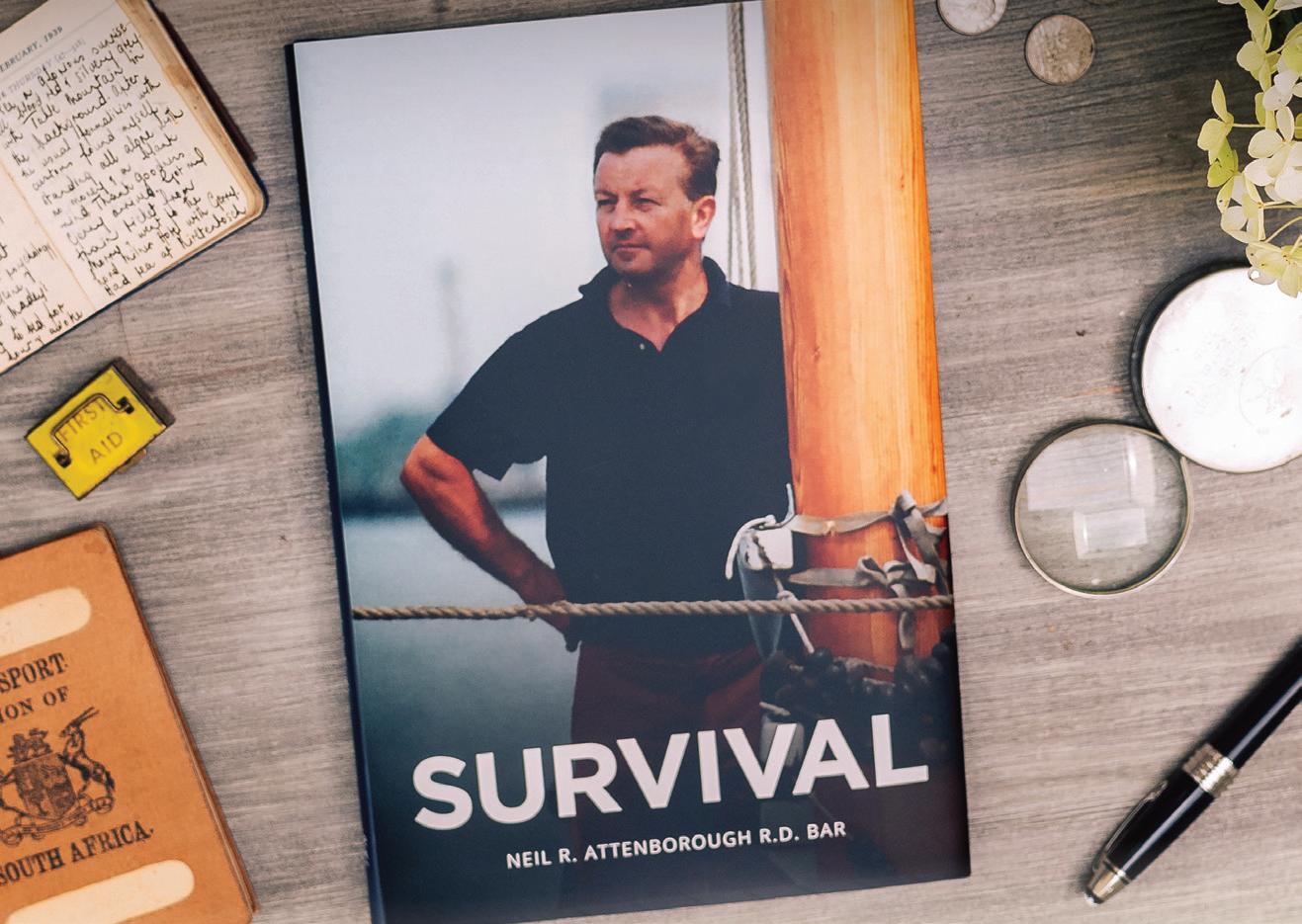
Celebrate the festive season with the Joy 2020, a sparkling wine from Southern Australia’s renowned Bird in Hand winery. Produced using the traditional champagne method in the picturesque Adelaide Hills, this effervescent wine is a sensory delight. It charms with aromas of red apple and a palate rich in toasted almonds and spiced red berries, finishing with a refined elegance. Ideal for pairing with oysters or smoked salmon, Joy 2020 is a sophisticated addition to any Christmas celebration, embodying both festivity and finesse.


Equiano Rum Co. presents Ominira, the first vintage expression in their Legacy Blend series, honouring the brand’s namesake, Olaudah Equiano. With an ABV of 52%, reflecting Equiano’s age at the time of his passing, this blend is a tribute to the freedom fighter’s remarkable journey. Crafted from rums distilled in Barbados and Mauritius, and matured for a minimum of 11 years, Ominira offers aromas of ripe banana, sweet molasses, and cedarwood. Limited to just 3,000 bottles and priced at £180, this premium rum is a unique and meaningful gift that celebrates history and excellence.
For the culinary enthusiast, the Savernake Knives Starter Set is the ultimate kitchen companion. This set features knives made from 60HRC Sandvik Swedish Steel, renowned for its sharpness and durability. British-made in Wiltshire, and hand finished to order, each knife can be customised with a choice of handle material and personalised inscriptions, adding a bespoke touch. The set includes the Stout Yeom, perfect for precision tasks; the Classic, versatile for everything from lamb to vegetables; and the Savernake Knife, an all-rounder for herbs, meat, and more. Order before 15th November to ensure Christmas delivery.
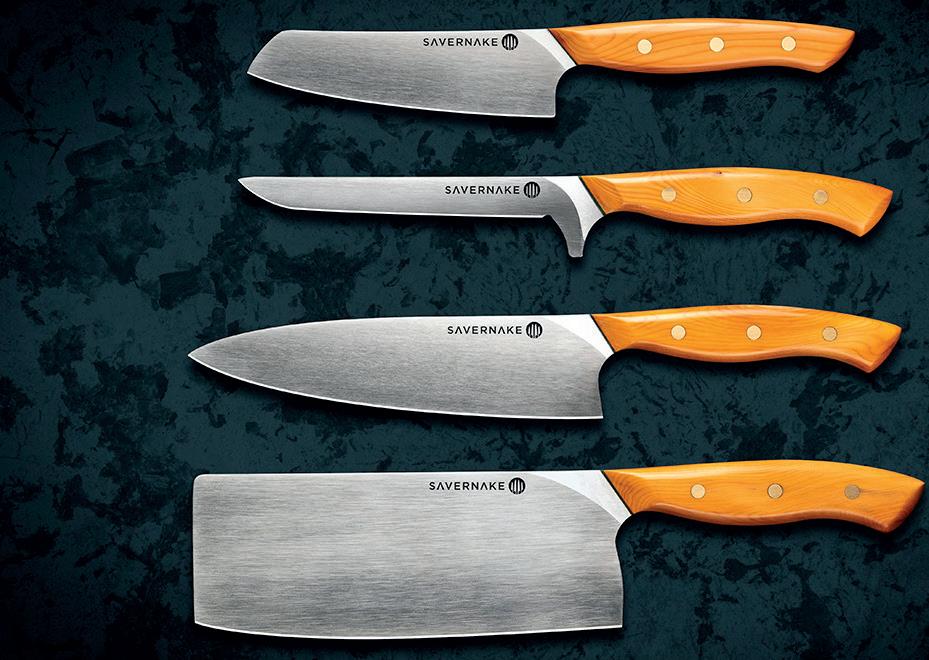


For the wine enthusiast looking to deepen their knowledge, a Wine & Spirit Education Trust (WSET) course offers a perfect learning experience. WSET’s globally recognised qualifications—ranging from the Level 1 and 2 Award in Wines to the Level 1 Spirits course—are now available both online and in person at wine schools across the UK. Whether navigating wine lists or impressing friends, this educational gift will provide lifelong skills
Purnima Fragrances presents a luxurious 3-wick candle encased in a handmade ceramic vessel, crafted in Stoke-on-Trent with a hand-sculpted logo. Packaged in an embossed box with a branded satin ribbon, this candle is an exquisite gift. Available in a selection of boutique scents, it brings a timeless and sophisticated fragrance to any room. Priced at £255 and weighing 1750g, the candle offers 145 hours of burn time, creating a lasting and elegant ambiance.


The Reid Single Malt Vodka redefines luxury clear spirits with its decadently rich taste, offering an experience unlike any other vodka. Designed for the discerning drinker and sophisticated sipper, it challenges expectations of what vodka can be. Perfect as a gift or a refined addition to a home bar, the set includes a bottle of Reid single malt vodka accompanied by two elegant Cardrona-branded Spiegelau martini glasses, all presented in a beautifully crafted wooden box.
Embark on a sensory journey with the prestigious Petrossian Caviar Assortment Set of the World. This luxurious collection includes 5 world-class caviars, featuring Beluga Tsar Impérial, Ossetra Tsar Impérial, Sevruga Steluga Tsar Impérial, Baïka Tsar Impérial, and Daurenki Tsar Impérial. Presented in 5 x 50g tins, this set offers a fabulous tasting experience for up to 8 people. Beautifully housed in a large collector's tin, elevate the decadence by adding Petrossian Premium Vodka—the purest expression of indulgence.
£1,125.00
petrossian.fr
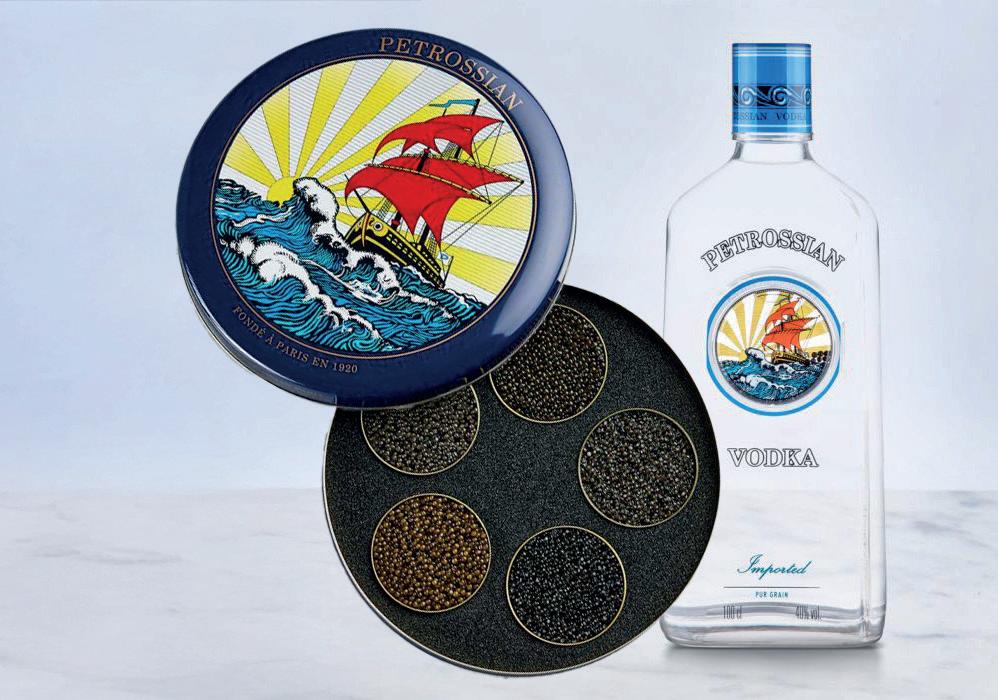

Elevate your space with Pullman Editions' striking Art Deco posters, which blend the timeless allure of glamorous destinations and historic automobiles with the bold, dramatic imagery of vintage design. Each poster, crafted by leading artists with a unique signature style, is part of a limited edition of 280. Printed using traditional techniques on 100% cotton fine art paper, these pieces are signed, hand-numbered, and bear an embossed stamp of authenticity, making them both a stylish and collectible addition to any home.
Step into the bohemian elegance of House of Bali with their handmade luxury kimonos. The Tie Dye Belted Kimono features wide-cut sleeves, an open front, and a waist tie for a relaxed yet chic fit. Its versatile design allows it to be worn as a beach robe, wraparound dress, or dressing gown. Crafted with vibrant, richly coloured prints, this standout piece combines effortless beauty with luxurious comfort.



The automotive world is abuzz with the return of an icon, as Aston Martin unveils the new Vanquish—a marvel that combines unparalleled power with exquisite design. This latest masterpiece from the storied marque promises to redefine the boundaries of performance and luxury, setting a new standard for ultra-high-performance grand tourers

TThe illustrious name of Vanquish graces the automotive world once more, heralding the arrival of Aston Martin’s most formidable production model to date. Though the name itself is not visibly emblazoned on the vehicle, the new twin-turbo V12 flagship unmistakably asserts its heritage through its striking design.
With a commanding output of 835 horsepower and 1000Nm of torque, the Vanquish embodies Aston Martin’s commitment to excellence. For those accustomed to imperial measurements, this translates to an impressive 824bhp and 737lb ft. The performance figures are equally remarkable: the Vanquish accelerates from 0-62mph in just 3.2 seconds (0-100kph in 3.3 seconds) and boasts a top speed of 214mph. This performance sets a new benchmark for production Aston Martins, requiring a limited-edition model such as the Victor or Valkyrie, or even a
pilot’s licence, to surpass.
Aston Martin’s dedication to engineering prowess is evident in their quest to outshine competitors. The Vanquish’s 5.2-litre V12 engine features a reinforced block, upgraded heads, crankshaft, and valvetrain, alongside optimised turbos and a new ‘Boost Reserve’ technology for rapid responsiveness. This is a direct challenge to Ferrari’s 820bhp 12 Cilindri, showcasing Aston Martin’s engineering supremacy.
In terms of design, the new Vanquish stands apart from its predecessors. The longer bonnet, now 80mm extended from the front axle to the A-pillar, gives the car a classic long-bonnet GT appearance. The redesigned front grille, 13 per cent larger than that of the DBS Superleggera, accommodates the increased cooling requirements of the potent engine. A distinctive ‘bow-and-arrow’ side vent and bespoke door design further differentiate it from the DB12.
The Vanquish features a redesigned rear, including a striking carbon ‘shield’ and multi-rod taillights inspired by the Valour model. A new ducktail spoiler and diffuser replace the DBS’s
vented bootlid, enhancing stability at high speeds. Notably, the Vantage headlights are the only elements carried over from previous Aston models.
To enhance performance, the Vanquish incorporates forged wheels to reduce unsprung weight, and standard ceramic brakes that save 27kg compared to steel alternatives. The bespoke tyres, marked with the ‘AML’ code, are specifically developed to complement the car’s long wheelbase and high power output.
Inside, the Vanquish is designed as a strict two-seater, featuring a substantial carbon strut brace in place of rear seats. This structural enhancement contributes to a 75 per cent increase in body stiffness over the DBS 770 Ultimate, providing an excellent foundation for the Bilstein adaptive dampers. With a dry weight of approximately 1,774kg, it strikes a balance between agility and stability, weighing more than its Italian competitors but less than a Bentley Continental GT.
The Vanquish offers a standard ‘GT’ mode for a refined driving experience, with additional sportier settings for those seeking


a more dynamic ride. These settings are managed through a touchscreen interface, which, alongside the improved driver’s instrument display, enhances user experience. The interior features a sleek centre console with tactile switchgear and exposed screwheads, adding a bespoke touch. A standard panoramic glass roof, with a tint that blocks 94 per cent of the sun’s rays, ensures a bright and airy cabin. Although a dimmable version was considered, design constraints led to the choice of a fixed tint or optional carbon fibre roof.
While manual shifting is reserved for ultra-exclusive models like the Valiant and Valour, the Vanquish retains its sophisticated eightspeed automatic transmission, now with enhanced software for quicker gear changes. Improvements extend to the steering map and retuned ESP for a refined driving experience.
Aston Martin plans to produce no more than 1,000 Vanquish units annually, ensuring the exclusivity of this V12 marvel. Set to enter the ultra-GT segment later this year, the Vanquish will compete with high-calibre rivals such as the Ferrari 12 Cilindri and the new Bentley Continental GT plug-in hybrid.


Lamborghini has once again redefined the boundaries of automotive excellence with the introduction of the Temerario, a masterful successor to the iconic Huracan. This new supercar seamlessly blends striking design with cuttingedge hybrid technology, setting a new standard in performance and luxury



LLamborghini has introduced the highly anticipated successor to the Huracan: the Lamborghini Temerario. This new model represents a significant leap forward in both technology and performance, blending traditional Lamborghini flair with cutting-edge innovation.
The Huracan’s 5.2-litre naturally aspirated V10 engine has been replaced by a sophisticated hybrid V8 powertrain in the Temerario. This new engine configuration, coupled with electric assistance, delivers an impressive 920 horsepower—setting a new benchmark in its class and placing it ahead of competitors such as the Ferrari 296 GTB.
Lamborghini’s signature design language continues to impress with the Temerario. The vehicle retains the aggressive wedge shape that has become synonymous with the brand. At the front, the headlights are noticeably slimmer, complemented by new hexagonal daytime running lights integrated into the lower bumper. These lights are not merely decorative; they include air tunnels designed to enhance engine cooling.
The side profile of the Temerario highlights a low-slung, purposeful stance, underscored by staggered alloy wheels—20 inches at the front and 21 inches at the rear. At the rear, the car features hexagonal tail lights that echo the design elements at the front, along with a larger diffuser and a central exhaust outlet reminiscent of the Revuelto.
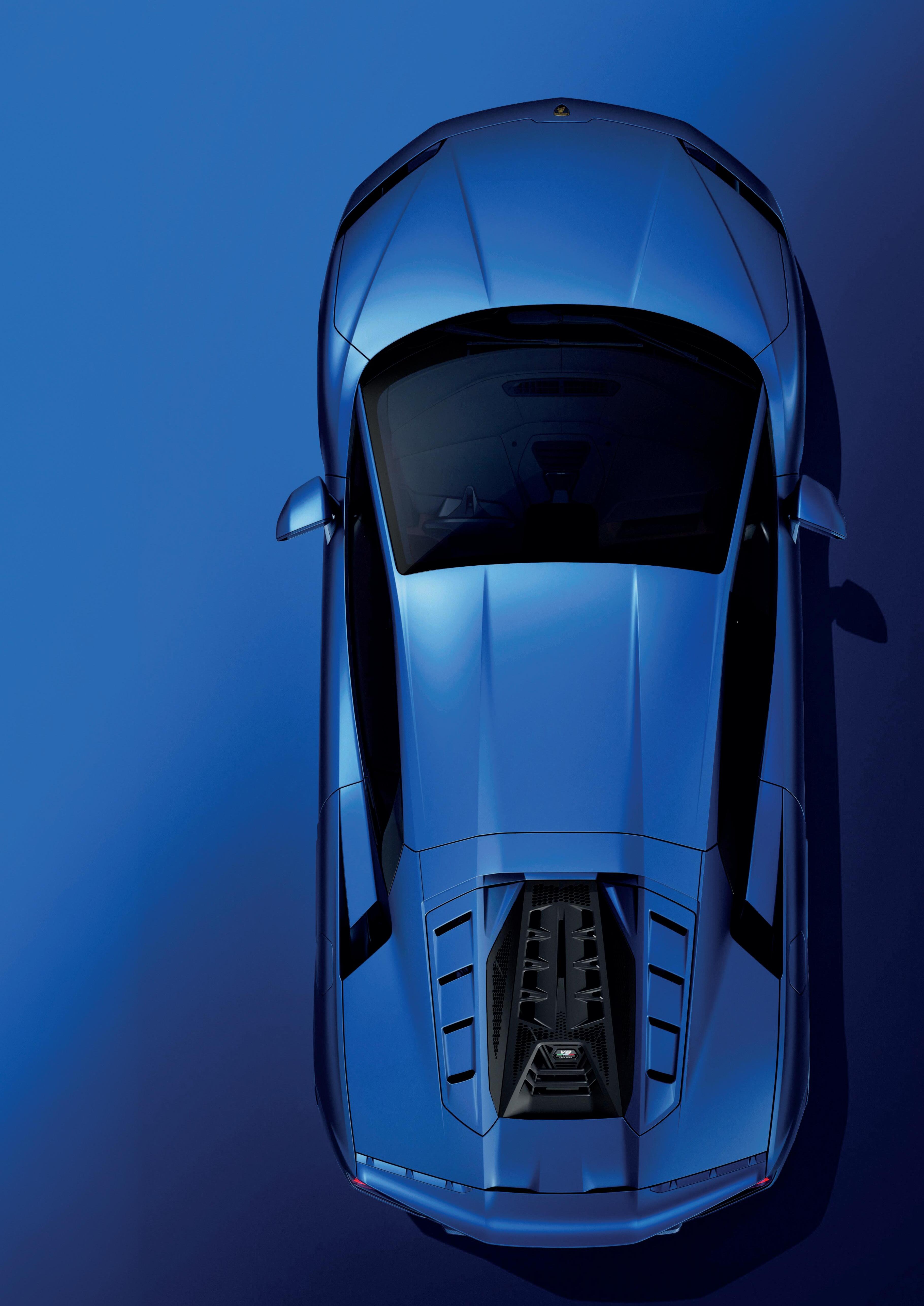
Under the hood, the Temerario houses a 4.0-litre twinturbocharged V8 engine, which produces 800 horsepower independently. This is augmented by a trio of electric motors, pushing the total output to 920 horsepower and delivering up to 2,150 Nm of torque in launch mode. Power is efficiently distributed to all four wheels through an eight-speed dual-clutch gearbox, enabling a remarkable 0-60mph acceleration in just 2.7 seconds. While this performance metric is slightly behind the Ferrari 296 GTB by 0.3 seconds, the Temerario’s 90-horsepower advantage is a testament to its engineering prowess.
The vehicle’s V8 engine is celebrated for its exhilarating soundtrack, further amplified by a sports exhaust system that allows the driver to experience the full spectrum of engine noise, particularly when revving up to its 10,000 RPM redline.
The interior of the Lamborghini Temerario draws heavily from the Revuelto, offering a modern, high-tech environment. Central to the cabin is an 8.4-inch portrait touchscreen, which, although reminiscent of the later versions of the Huracan, is complemented by a new 9.1-inch passenger display and a 12.3-inch digital instrument cluster. This blend of technology enhances both driver and passenger experience, making the Temerario a formidable contender in the supercar segment.
While exact pricing details for the Lamborghini Temerario have yet to be disclosed, prospective buyers can expect a starting price in the region of £250,000. This represents a step up from the outgoing Huracan, which was priced from approximately £200,000. Orders for the Temerario are expected to open soon, marking the beginning of a new era for Lamborghini enthusiasts.


The Pininfarina Battista Dark Knight stands as a bold tribute to both luxury and performance. Born from the collaboration between Automobili Pininfarina and Wayne Enterprises, this limited edition hypercar fuses the mystique of Gotham with cutting-edge electric technology, creating a driving experience as powerful as it is refined

TThe Pininfarina Battista Dark Knight emerges as a striking tribute to Batman’s 85th anniversary, blending iconic superhero inspiration with unmatched luxury and performance. The collaboration between Automobili Pininfarina and Warner Brothers has produced a special edition hypercar, which embodies the sophistication of Bruce Wayne and the cutting-edge innovation of Gotham City.
At the core of the Dark Knight edition lies the reimagined Battista Furiosa, a stunning evolution of the pure-electric model. This unique edition boasts bespoke enhancements and a bold new design language, marking it as the most formidable version of the Battista to date.
Design and Craftsmanship: Gotham’s Elegance Reimagined
The Battista Dark Knight commands attention with its meticulously crafted exterior. Finished in Argento Vittorio gloss paint, the car’s sleek bodywork radiates a sense of elegance and power, reminiscent of Gotham City at dawn. Key features such as the Goccia roof in Nero Torino gloss and bespoke carbon fibre elements further accentuate its aerodynamic prowess. These subtle Gotham-inspired details, including the Wayne Enterprises logos on the side skirts and roof, reflect a perfect balance of refinement and function.

The vehicle is also equipped with bespoke Prezioso Evoluzione wheels, featuring a gloss black face and matt black channel rim, complemented by black-anodised calipers and a brushed aluminium centre lock ring. These elements not only enhance the car’s aggressive stance but also underscore its commitment to high performance.
Step inside the Battista Dark Knight, and one is greeted by an interior that speaks to a world of luxury and innovation. The cabin, swathed in Tan leather with bespoke embroidery and intricate stitching, offers a serene driving environment. Inspired by the calming presence of Gotham City at night, the interior creates a perfect blend of tranquillity and cutting-edge technology.
A standout feature of the interior is the expansive curved glass roof, which bathes the large cabin in natural light. This design choice enhances the sense of space and elevates the feeling of luxury, making every journey feel like a moment of personal indulgence.
In keeping with its connection to Bruce Wayne, the vehicle’s HMI display is designed with Wayne Enterprises branding, offering a sophisticated navigation system guided by the calming voice of Alfred Pennyworth, Wayne’s trusted assistant. This integration of technology and comfort creates a seamless driving experience, ensuring that every ride is as effortless as it is exhilarating.
The Battista Dark Knight’s performance capabilities are nothing short of extraordinary. Powered by a 120 kWh lithium-ion battery and four electric motors, the hypercar delivers a staggering 1,900 horsepower. It accelerates from 0 to 100 km/h in an astounding 1.86 seconds, and reaches 200 km/h in just 4.75 seconds, pushing the boundaries of electric vehicle performance.
This all-electric hypercar is also engineered for practicality. With a WLTP range of up to 476 km, the Battista Dark Knight combines zero-emission driving with long-distance capabilities, offering the perfect balance between power and sustainability. The



vehicle’s Brembo 390mm carbon-ceramic brakes and 6-piston calipers ensure unrivalled stopping power, reinforcing its focus on safety and precision.
Automobili Pininfarina’s commitment to zero-emission technology is exemplified in the Battista Dark Knight, demonstrating that sustainability need not come at the cost of performance. With an electronically limited top speed of 350 km/h and a maximum torque of 2,340 Nm, this hypercar proves that electric vehicles can deliver a truly exhilarating driving experience.
The full carbon fibre monocoque and carbon fibre body panels not only reduce the car’s weight but also contribute to its exceptional structural rigidity, further enhancing its handling capabilities at high speeds. Additionally, bespoke front and rear louvers, along with the tailored shark fins on the tailgate, ensure optimal aerodynamics and improved brake cooling.
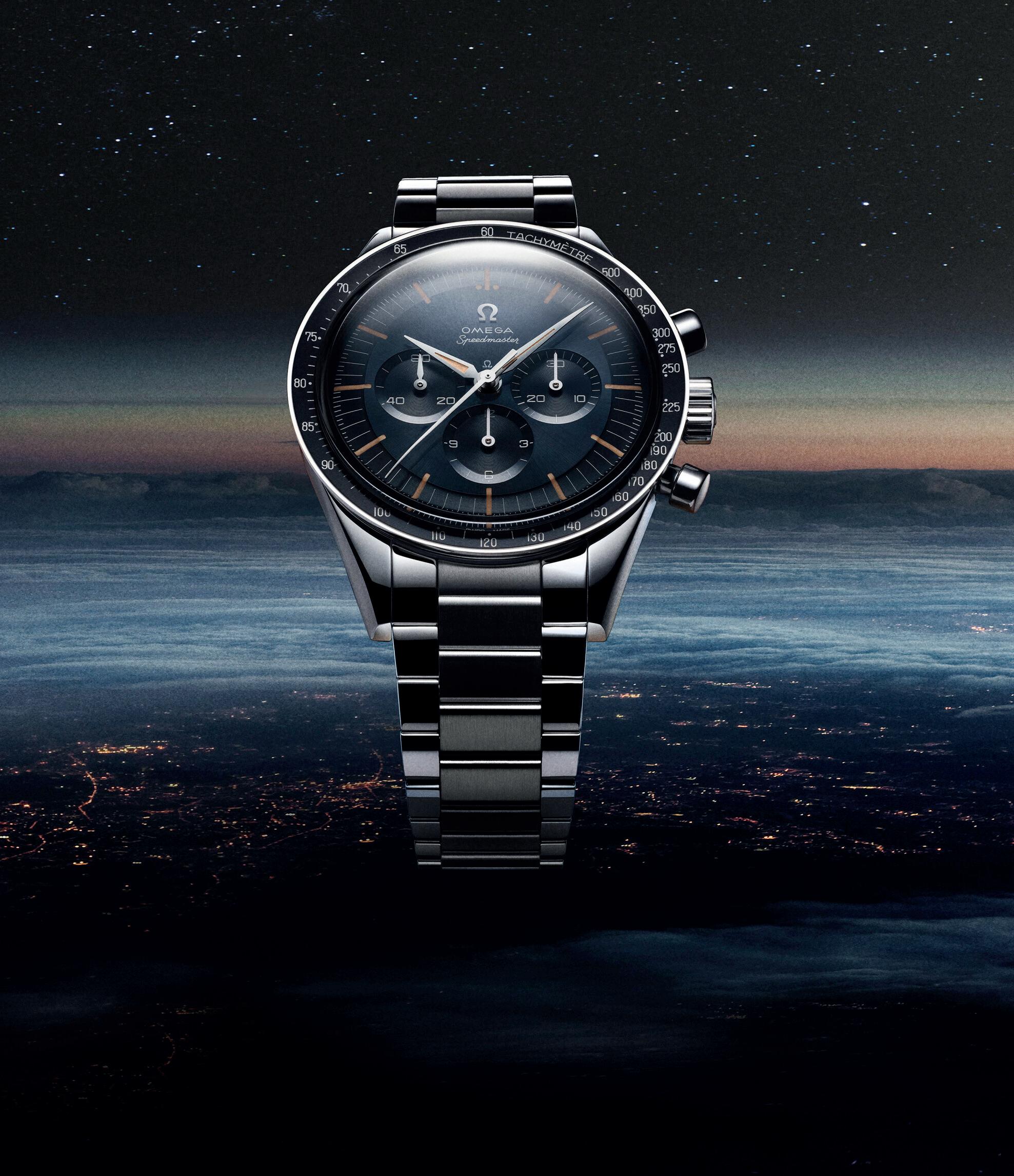
OMEGA's legendary heritage in space exploration reaches new heights with the revival of one of its most iconic timepieces, ‘The First OMEGA in Space.’ Combining timeless design with cutting-edge technology, this reissue offers a refined nod to the brand’s celebrated history while delivering the precision and performance
RRenowned for its impeccable craftsmanship and role in space exploration, OMEGA has once again delighted enthusiasts with the reintroduction of one of its most coveted timepieces: ‘The First OMEGA in Space’. This iconic watch, now updated with the modern Co-Axial Master Chronometer calibre, serves as both a celebration of the brand’s storied past and a testament to its enduring commitment to precision and innovation.
Originally introduced in 1959, the CK 2998 Speedmaster was part of the second generation of the Speedmaster family, a model that captivated the attention of collectors and professionals alike. Featuring Alpha hands, a symmetrical case, and a dark bezel, it stood apart from its predecessor, the first Speedmaster from 1957. Its timeless design and technical sophistication made it an instant classic.
However, it was in October 1962, during NASA’s Mercury Sigma 7 mission, that the CK 2998 truly secured its place in history. Astronaut Walter “Wally” Schirra selected the watch as his personal timepiece for the mission, marking the CK 2998 as ‘The First OMEGA in Space’. This milestone was the beginning of OMEGA’s rich legacy in space exploration, a legacy that continues to define the brand today.
The modern reinterpretation of this legendary model remains faithful to its historical roots while incorporating cuttingedge advancements. The watch is equipped with a symmetrical 39.7mm case in polishedbrushed stainless steel, a nod to the original proportions. Its dark bezel, crafted from black aluminium, features the hallmark tachymeter scale with the revered “Dot Over Ninety”, a detail that is synonymous with the earliest Speedmaster designs.
dial in a sophisticated grey-blue shade, echoing the tones of CK 2998 models from the 1960s. The vintage Super-LumiNova fills the Alpha hands and hour markers, ensuring clarity in low-light conditions, while the white varnished central seconds hand complements the crisp, transferred markings.
True to its heritage, the updated model also features dual vintage OMEGA logos—one on the dial and another on the crown. The caseback, engraved with “SPEEDMASTER”, “THE FIRST OMEGA IN SPACE”, and the significant date of October 3, 1962, further highlights the watch’s legacy. A Seahorse medallion is also integrated, a symbol long associated with OMEGA’s maritime and space endeavours.
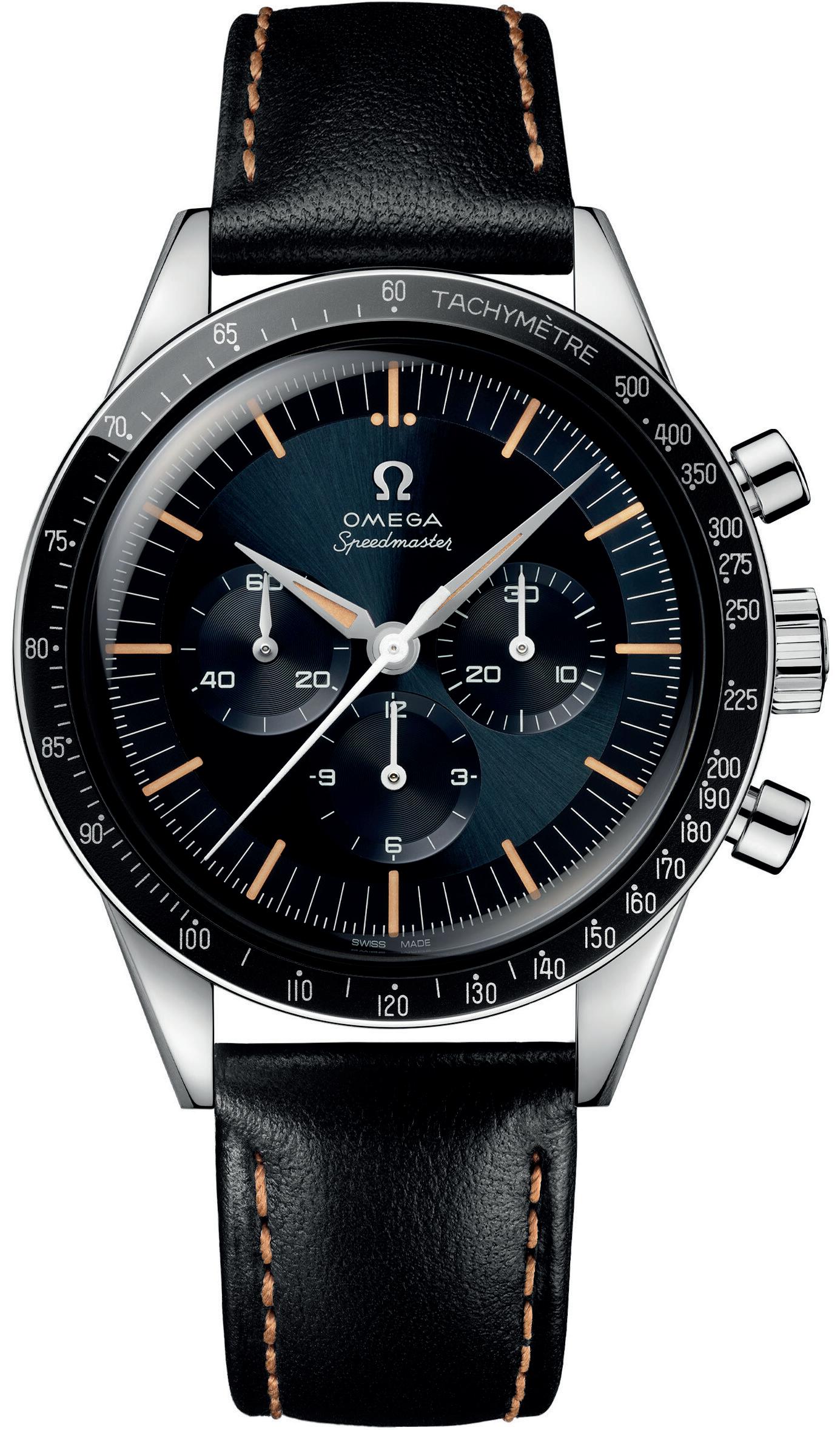
Beneath the sapphire crystal, OMEGA has chosen a CVD-coated
While the external design remains loyal to its past, the mechanics powering this watch are firmly rooted in the future. At its heart is the Co-Axial Master Chronometer Calibre 3861, an evolution of the Calibre 321 that powered the original CK 2998. This new calibre ensures unparalleled precision, performance, and resistance to magnetic fields, meeting the rigorous standards of METAS certification. It’s a clear reminder that, just like rocket technology, horological innovation continues to evolve.
Collectors and aficionados now have the option of choosing from three distinct models of this celebrated timepiece. ‘The First OMEGA in Space’ is available with either a black or brown leather strap, both featuring a refined buckle, or for those seeking a more contemporary look, on a full metal bracelet with flat links. OMEGA’s patented comfort release adjustment system ensures a perfect fit for the wearer.
Each timepiece comes elegantly presented in a special edition box, complete with an exclusive “Legendary Moonwatch” leaflet. This thoughtful presentation further cements the watch’s place not only as a timepiece but as a historical artefact, appealing to collectors who value craftsmanship, heritage, and modern innovation.
